|
The material on this website is intended for educational use only and may not be reproduced for commercial purposes without express permission from the appropriate copyright holder.
Le contenu de ce site Web est destiné à des fins pédagogiques seulement et ne peut être reproduit à des fins commerciales à moins d'en avoir obtenu la permission du titulaire du droit d'auteur approprié.
"British Columbia was discovered, explored and settled by Aboriginal or Native people."
Dr. Ed Whitcomb
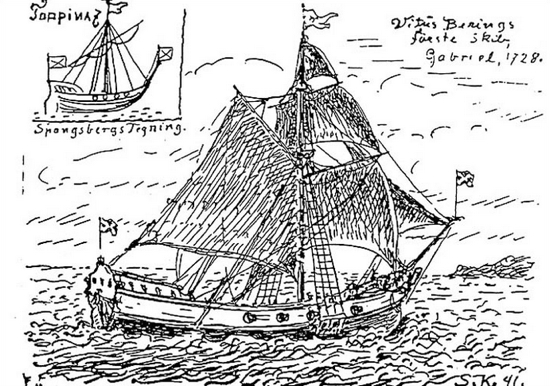
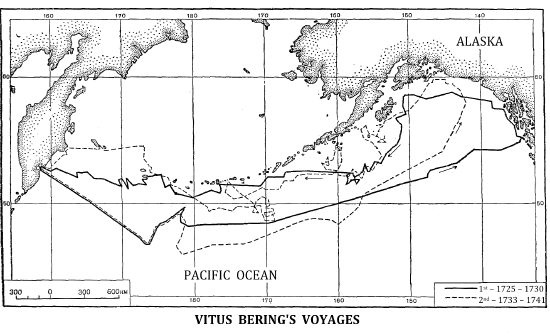
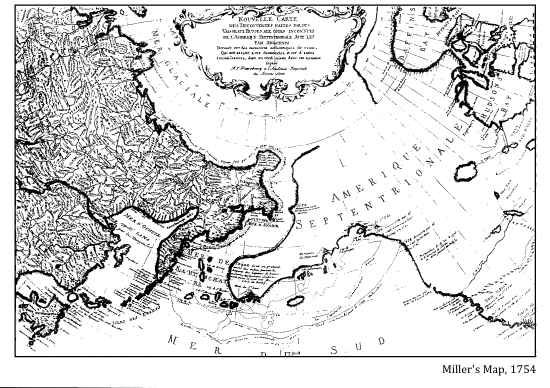
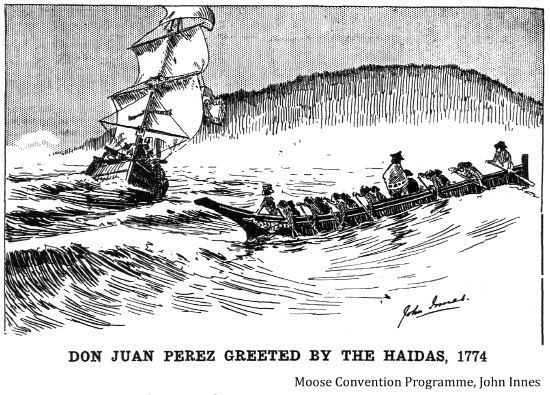
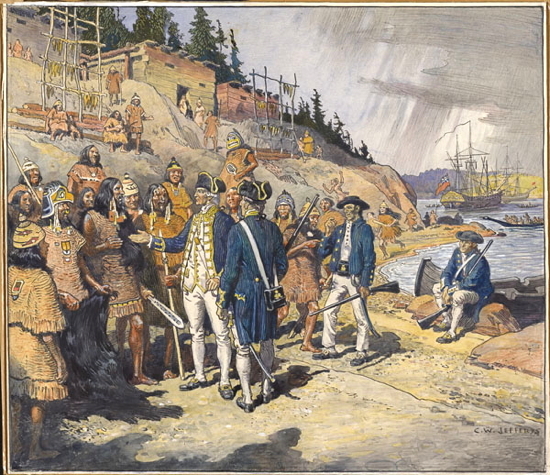
Captain Cook meets the West Coast Indians at Nootka, 1778. LAC Acc. No. 1972-26-765, Charles W. Jefferys, 1920s or 1930s
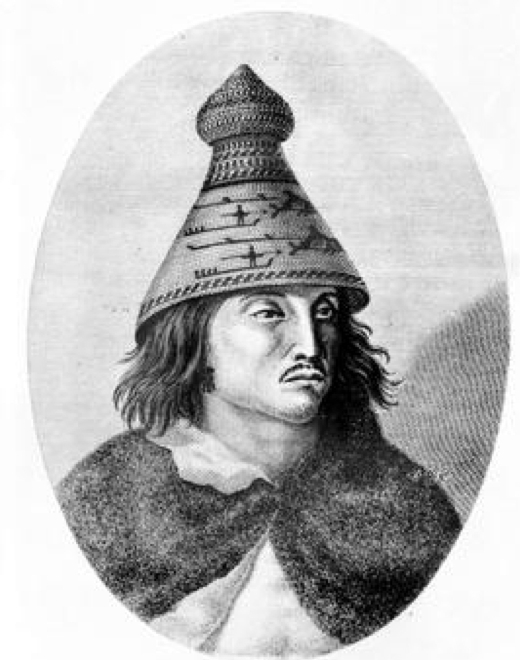
Chief Maquinna of Nootka Sound, Tomas de Suria, 1791
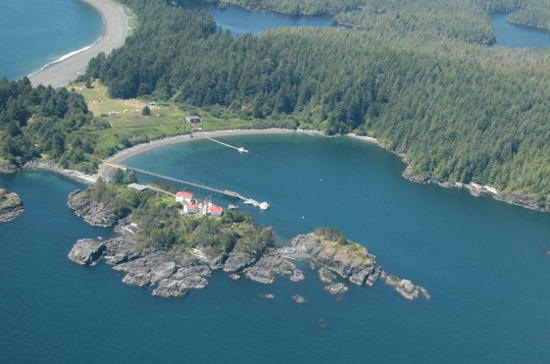
Friendly Cove
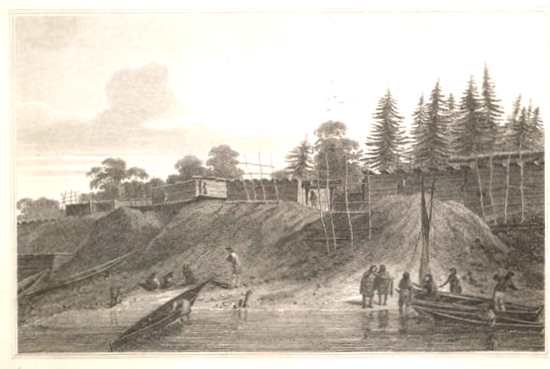
Habitations at Nootka Sound, 1778. LAC Acc. No. R9266-2667 Peter Winkworth Collection of Canadiana, John Webber, 1812
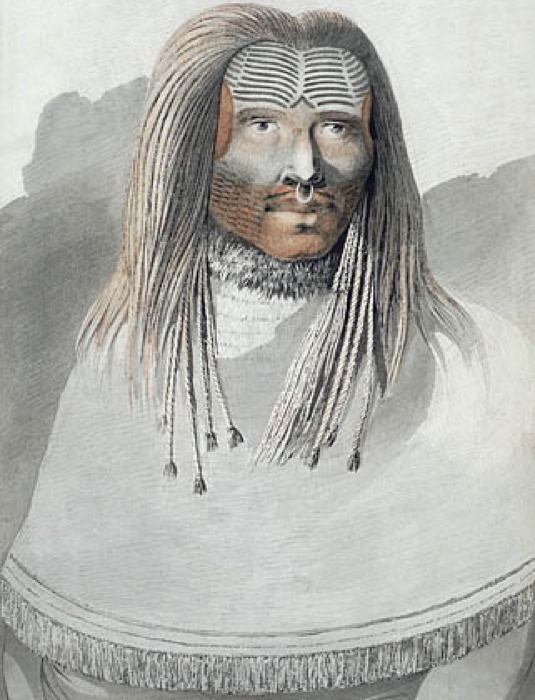
A Man of Nootka Sound, 1778. LAC Acc. No. 1991-265-232, John Webber
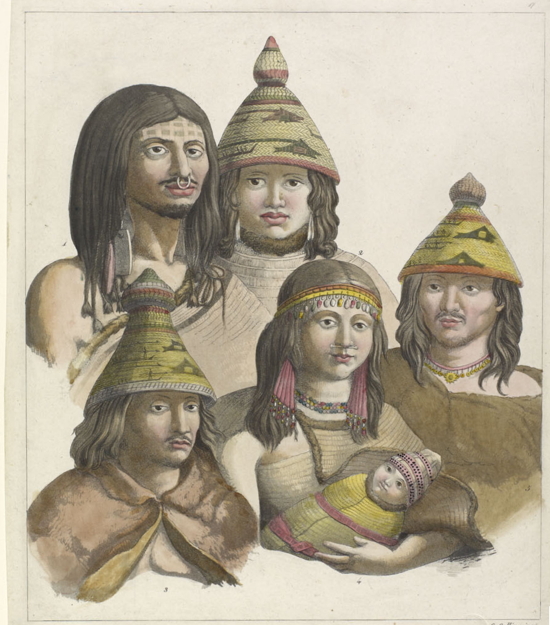
Inhabitants of Nootka. LAC C-033614, Gallo Gallina
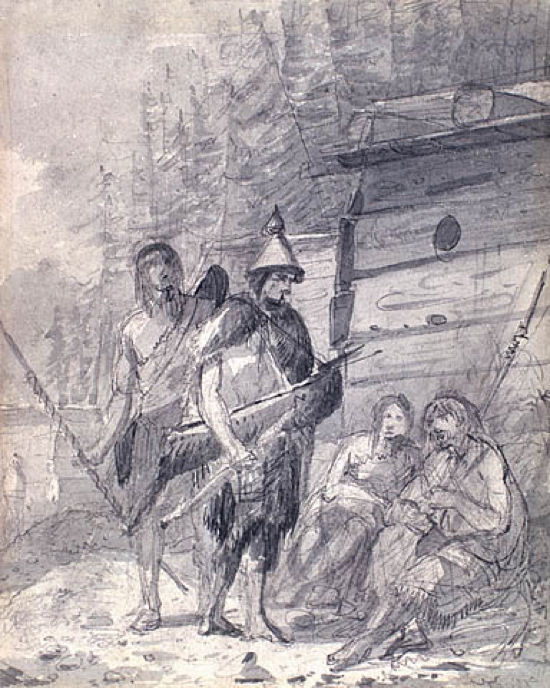
Natives Outside a Communal House, Nootka / Indiens à l'extérieur d'une loge communale à Nootka. LAC C-002822, John Webber, March 29-April 26, 1778
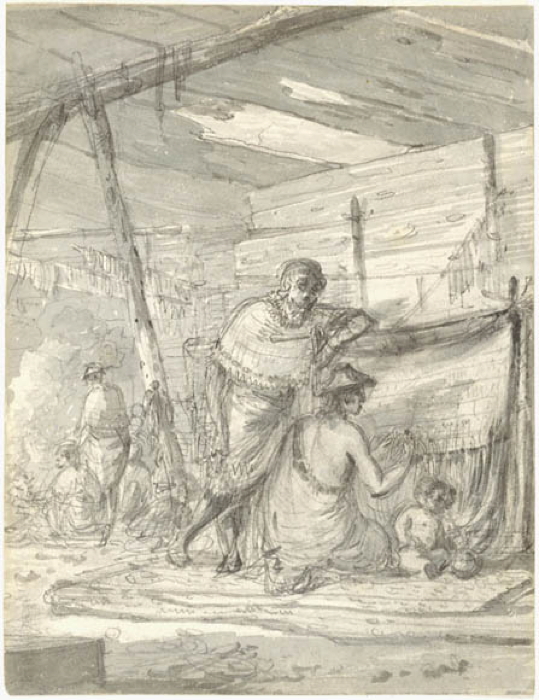
Interior of a House with Women Weaving, Nootka Sound / Femmes en train de tisser dans une habitation du détroit de Nootka. Acc. No. 1991-265-234, John Webber, March 29-April 26, 1778
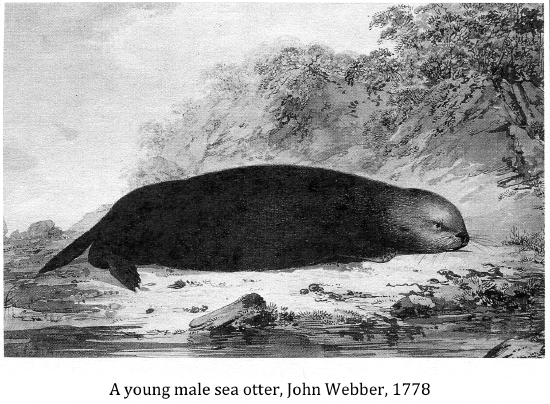
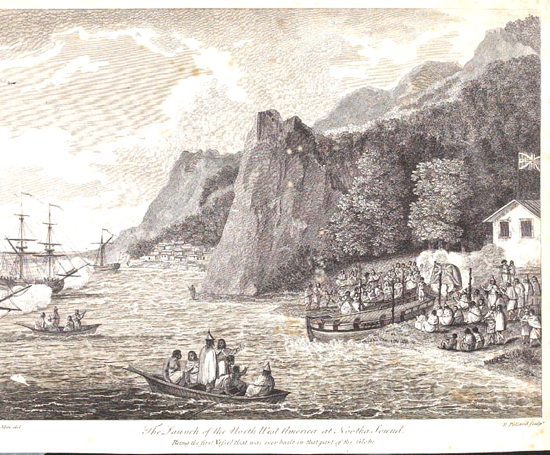
The Launch of the North West America at Nootka Sound. La mise à l'eau du North West America à la baie Nootka. LAC Acc. No. R9266-3477 Collection de Canadiana Peter Winkworth, Conrad Martin Metz, ca. 1790

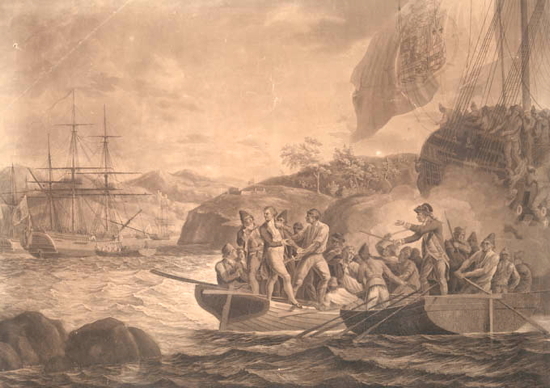
The Spanish Insult to the British Flag at Nootka Sound, 1789. LAC Acc. No. R9266-3257 Peter Winkworth Collection of Canadiana, Robert Dodd, 1748-1816

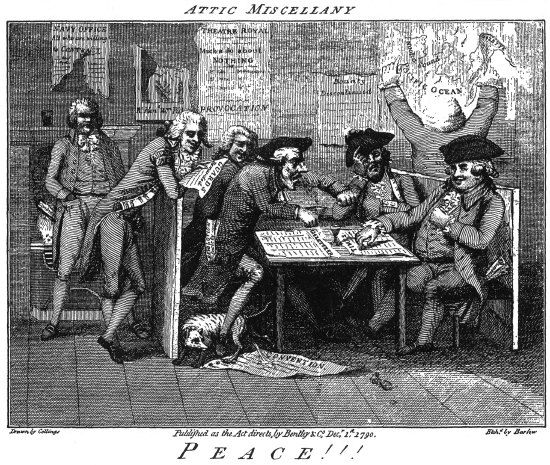
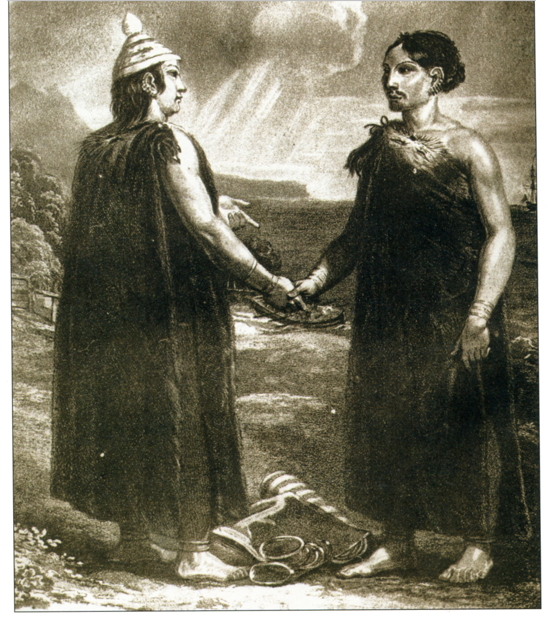
Callicum and Maquilla. Chiefs of Nootka Sound. LAC C-027699, 1790
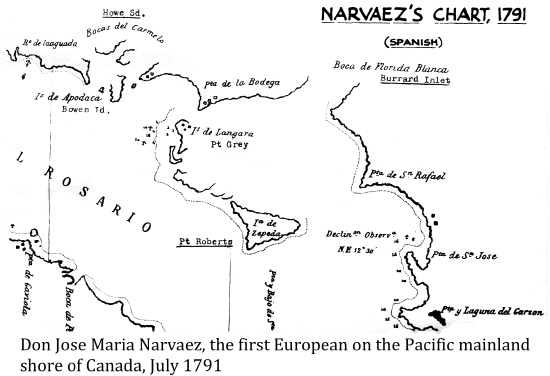
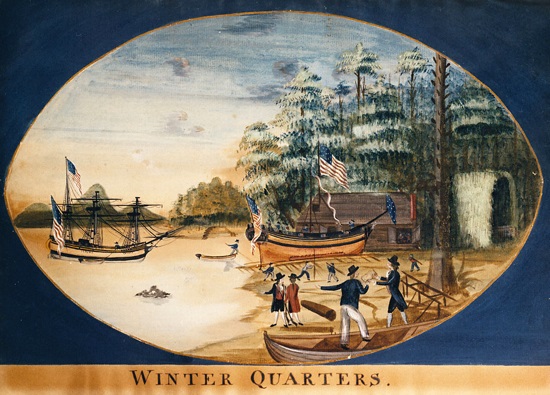
[Boston fur trader Robert Gray, captain of the ship Columbia, wintered near Tofino in 1791-92. In May 1792, just 200 miles south, he discovered the river Britain's George Vancouver had missed, and named it the Columbia.]
George Davidson, artist, public domain, Wikimedia Commons
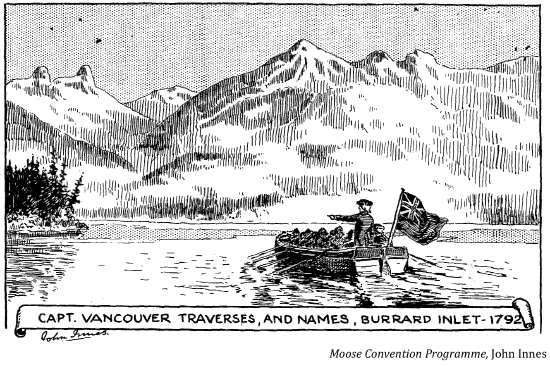
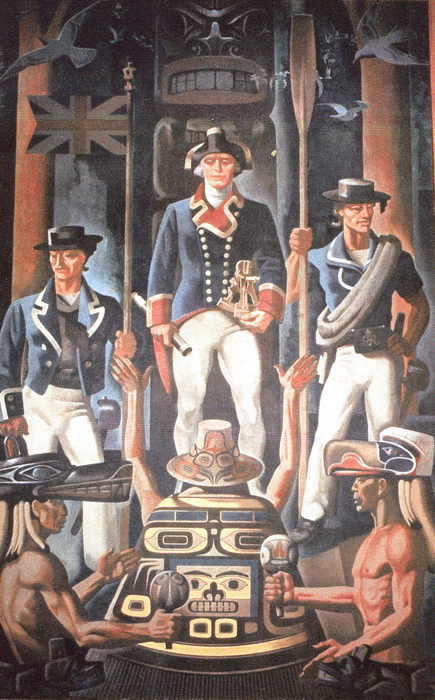
Captain George Vancouver's arrival on the West Coast, June 1792, Dr. Charles Comfort, 1939
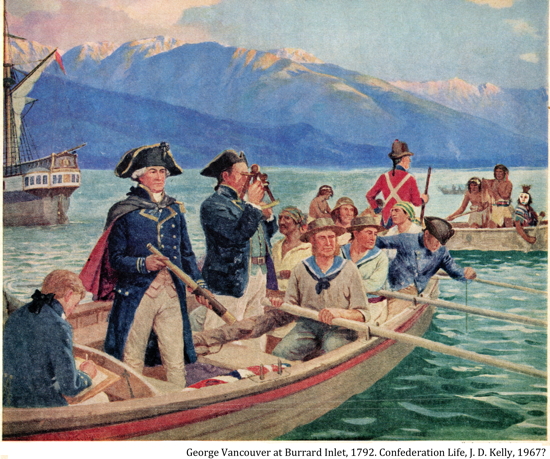
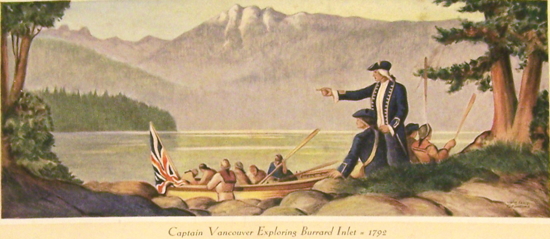
Captain George Vancouver Exploring Burrard Inlet, 1792, John Innes and George Southwell, 1925
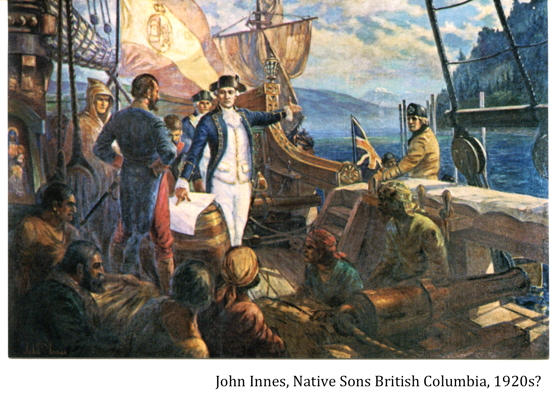
Commander Vancouver Meeting the Spanish off Point Grey, 1792, John Innes, 1925
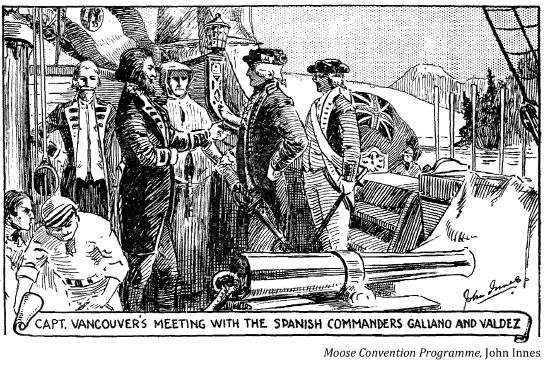
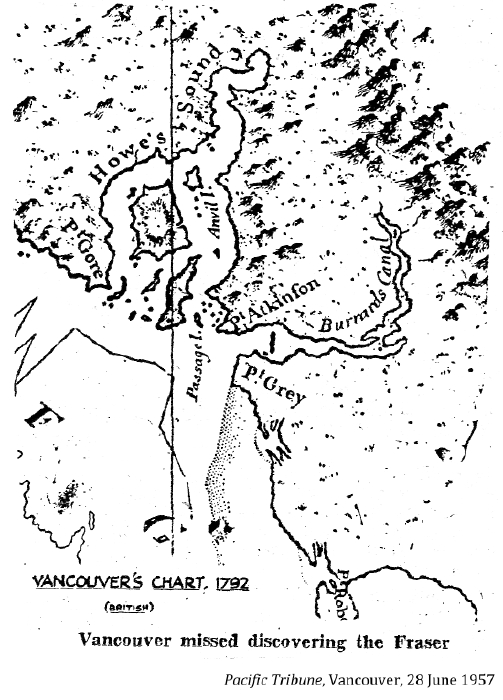
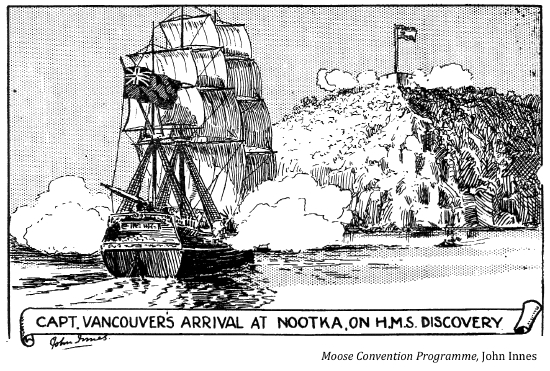
August 1792
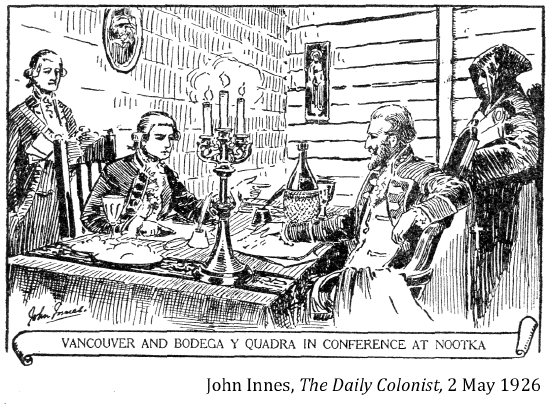
COURAGE
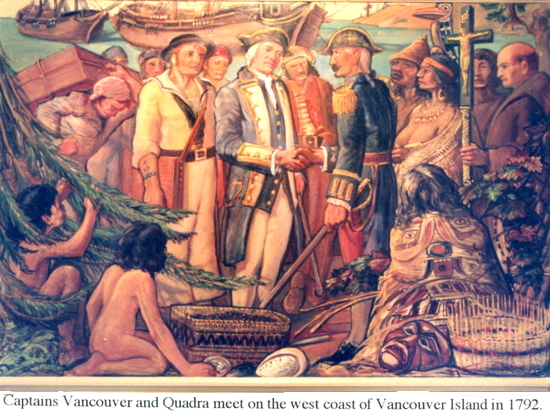
Murals prepared for the rotunda at the BC Legisture by George Southwell in 1933. He was asked to illustrate "the historical qualities necessary for the establishment of a civilization [Courage 1792, Enterprise 1843, Labour 1843 and Justice 1874]."
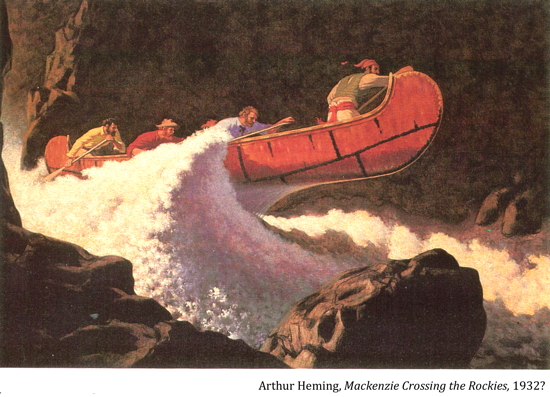
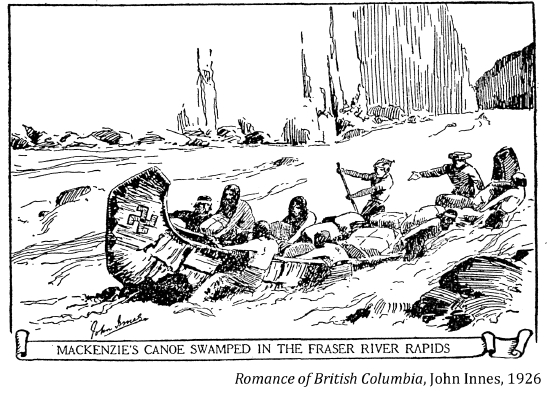
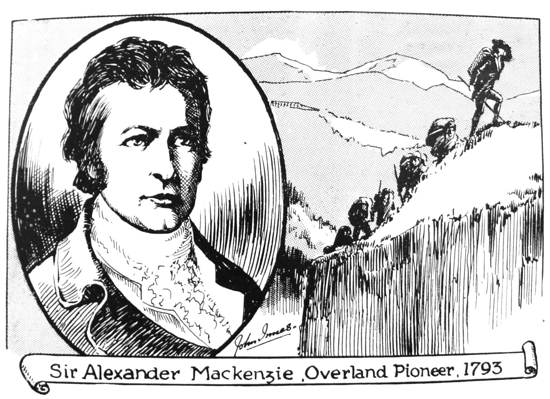
Grease trail followed by Alexander Mackenzie
http://www.quesnelmuseum.ca/FootprintsInStone/History/Grease-Trail.html
http://www.bcfoodhistory.ca/ooligan-grease-by-gale-smith/
"What constitutes geographical exploration and discovery? It doesn't seem that an individual being led through a land by the land's occupants should count on discovering it, except in a personal sense. Mackenzie and his team should more accurately be called travelers. They were not exploring a land devoid of inhabitants; they were touring distant, populated lands for eastern economic interests."
Stephen R. Brown, The Company The Rise and Fall of the Hudson's Bay Company.
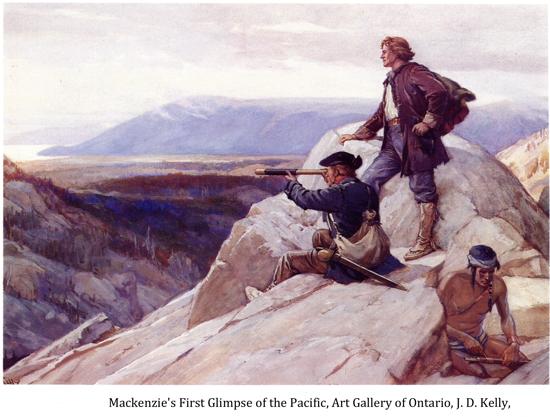
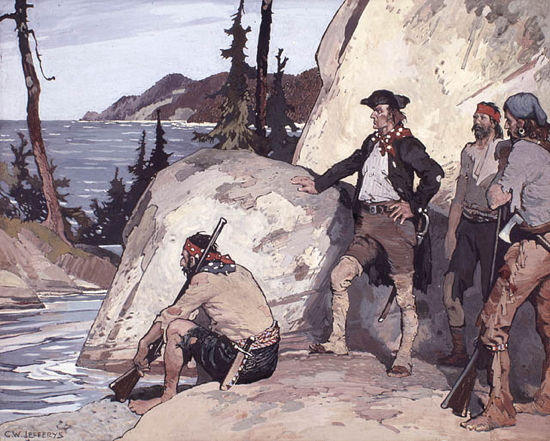
Charles W Jefferys 1920s or 1930s

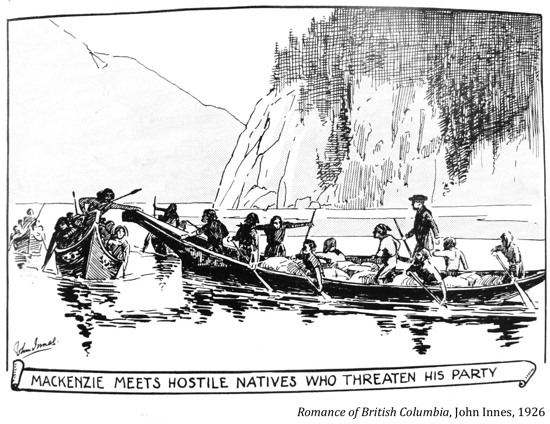
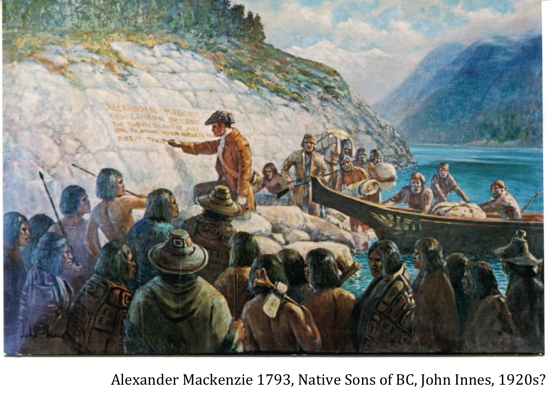
Alexander Mackenzie Recording his Arrival at the Pacific, 1793, John Innes, 1925
John Innes depicted highlights of the province's romantic history. His pictures are heroic in conception – of great events and 'men with empires in their bosoms.'
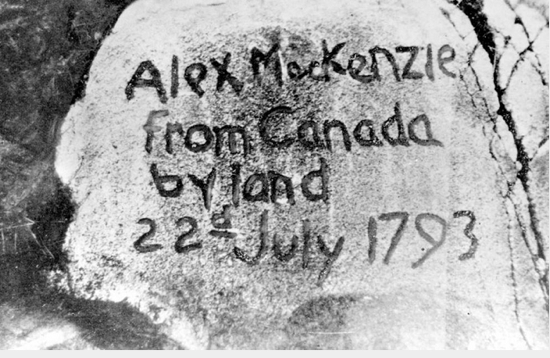
1793 Inscription by Sir Alexander Mackenzie on a rock in Dean Channel, near Bella Coola, BC, Archives A-02312
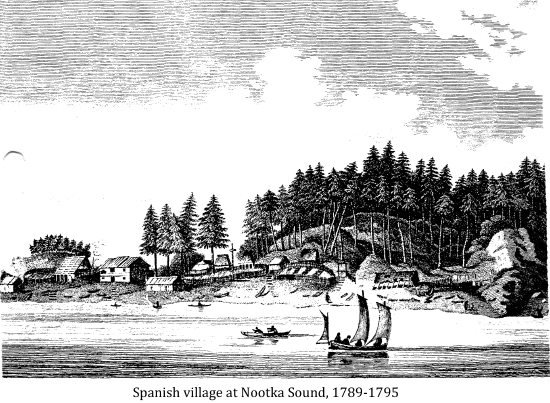
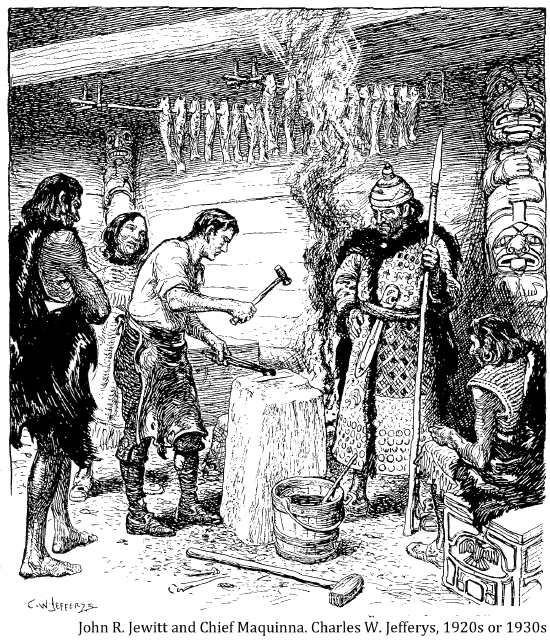
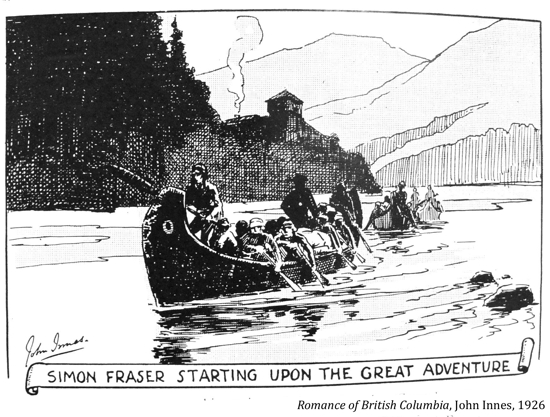
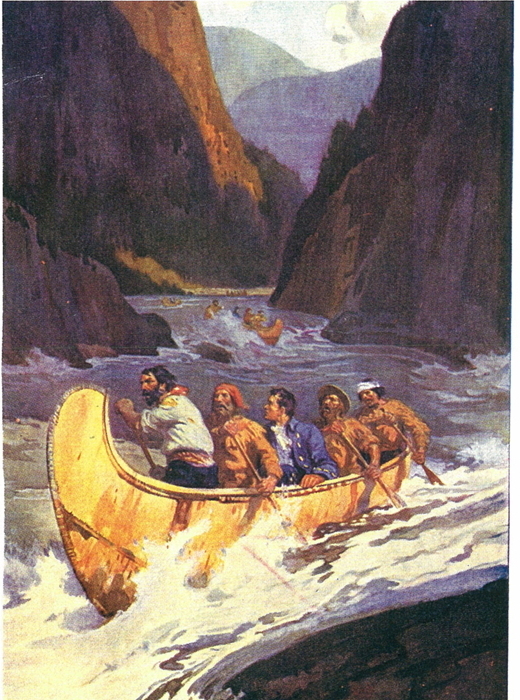
Simon Fraser Descending the Fraser River, 1808. Simon Fraser descend le fleuve Fraser, 1808. LAC Acc. No. 1972-26-6, Charles William Jefferys, 1920s or 1930s?
"Had it not been for Aboriginal guides, Aboriginal food supplies, Aboriginal transportation methods, Aboriginal medicines, and Aboriginal technology to mend canoes, Simon Fraser probably would have never achieved his goal. It is well established in our oral history that Logshom guided Simon Fraser more than three hundred kilometers through Secwepemc territory and turned him over to the Stl'al'imx (Lillooet) people to guide him further."
Bev Sellars, Price Paid The Fight for First Nations Survival

Simon Fraser’s Canoes Descending the Fraser River, John Innes & G.H. Southwell, 1925

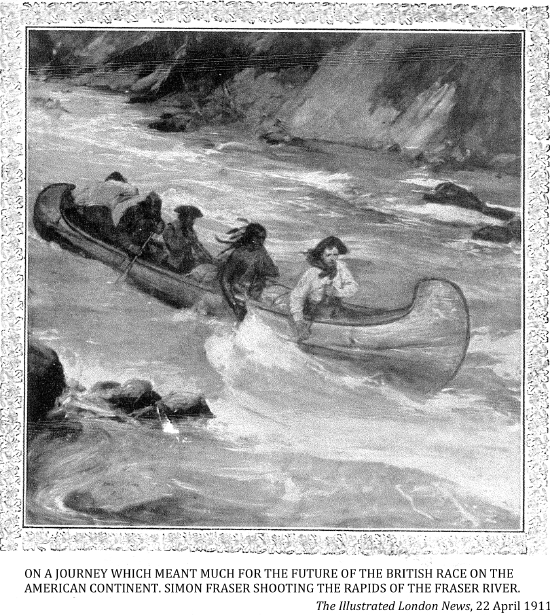
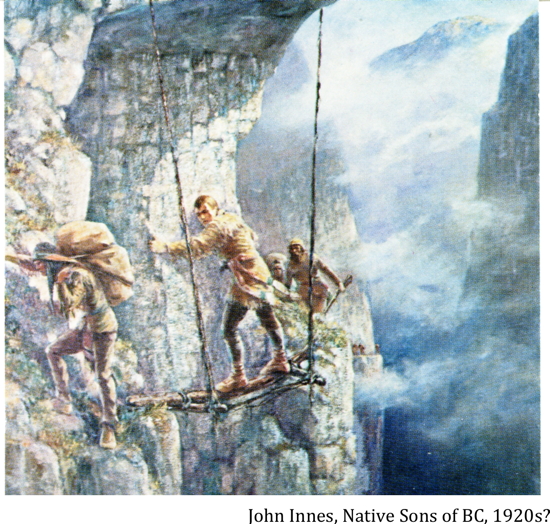
Simon Fraser in the Black Canyon, 1808, John Innes, 1925
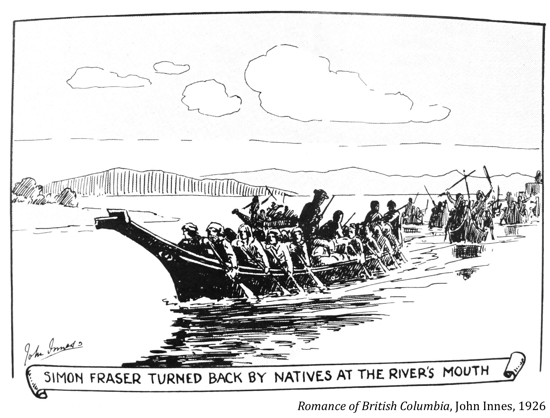
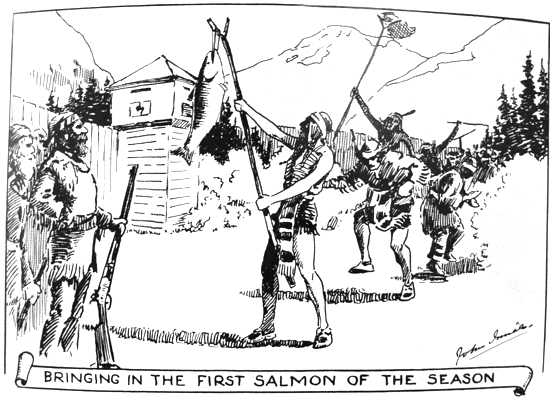
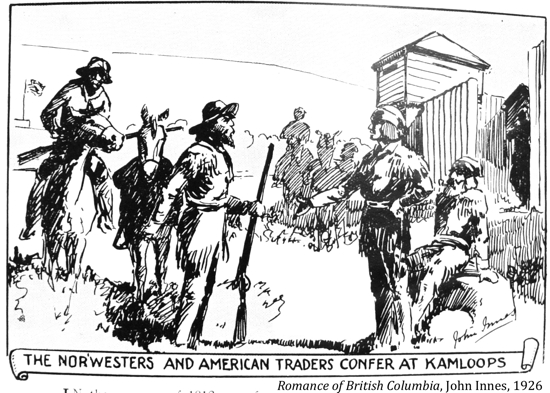

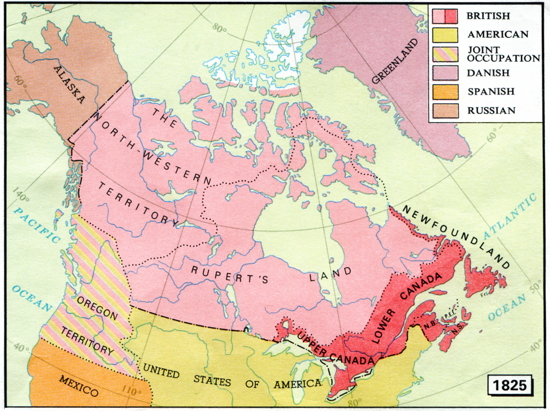
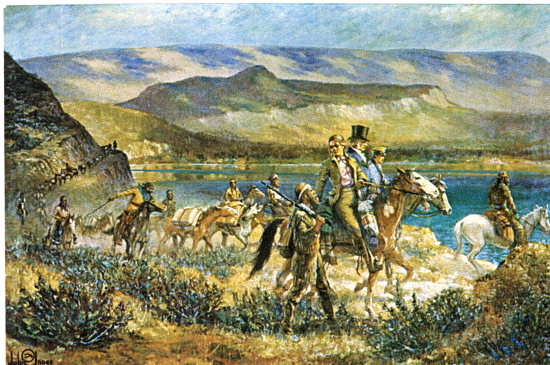
The Hudson's Bay Company Fur Brigade Passing Down the Okanagan, 1825-1847, John Innes, 1925 (see Fur Brigade theme)
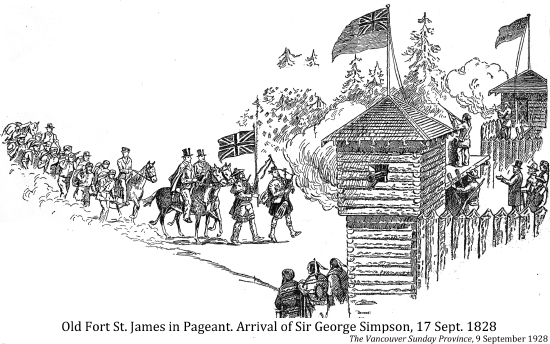
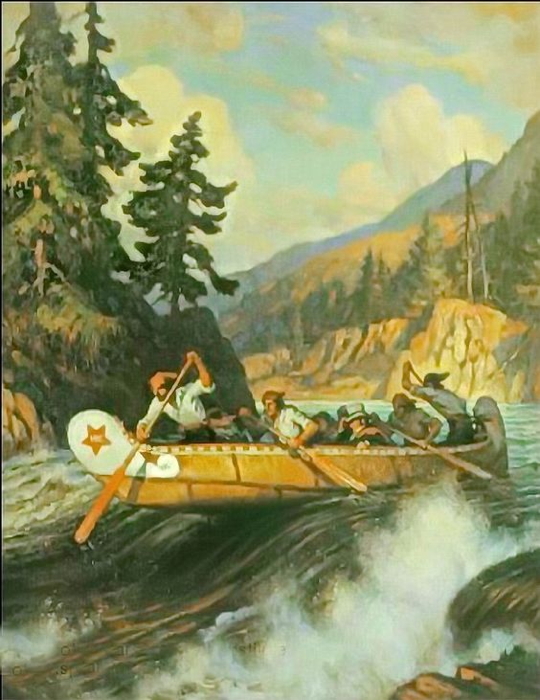
Chief Trader Archibald McDonald and George Simpson descending the Fraser River, 1828, Hudson's Bay Company Archives, Adam Sherriff Scott, ca. 1942
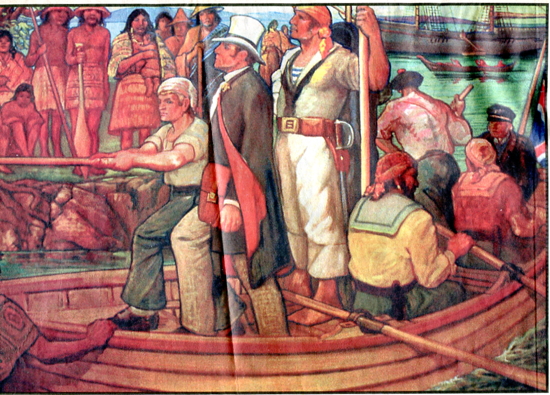
Enterprise - Hudson's Bay Company Chief Factor, James Douglas, landing from the Cadboro at Clover Point to select site for Fort Victoria, 1843, George Southwell, 1935
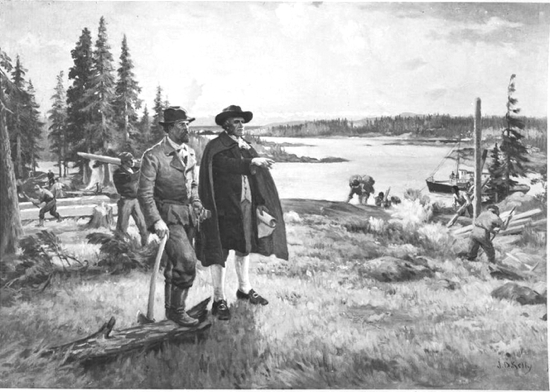
1843 A painting of James Douglas marking location for Fort Victoria, John David Kelly, BC Archives B-00245
LABOUR

Murals prepared for the rotunda at the BC Legisture by George Southwell in 1933. He was asked to illustrate "the historical qualities necessary for the establishment of a civilization [Courage 1792, Enterprise 1843, Labour 1843 and Justice 1874]."
"The notion implied in these murals ¬— that colonial power was established here with a dab of ceremony and no subsequent heartache, loss, dislocation, political danger, set-back or risk for any of the participants — is simply childish."
Michael Scott, "A critic's advice: Take the murals down," The Vancouver Sun, 20 April 2001
[The depictions of colonial times are] "highly offensive, demeaning and degrading."
Criticism by aboriginal leaders, The Vancouver Sun, 20 April 2001
"They [the murals] are fables, in a way. They are historical events that happened, but not that way. They are scenes that were invented [interpretations]. . . Southwell is believed to have been sympathetic to aboriginals, and his depiction of them in murals in the legislature was progressive. Until that time, the only aboriginal representation on the grounds was a statue of the Indian chief Maquinna. I think in their day, [the murals] were a brave statement about bringing British Columbians together in their historical and cultural context."
Art historian Martin Segger
"[The murals] may be reflective of attitudes of white people at the time, but that doesn't make them right . . . [they] depict a relationship with aboriginal people that – if it ever existed – is over."
Bill Wilson of the First Nations Summit Task Force
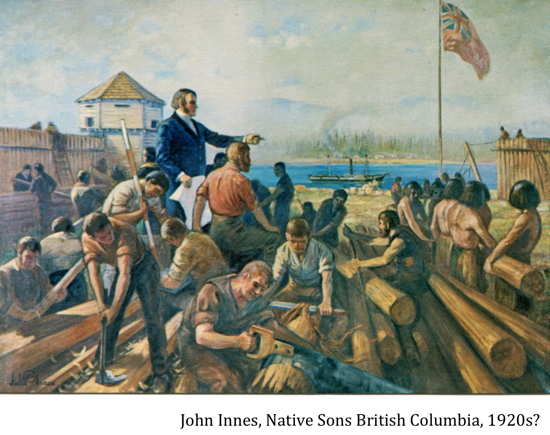
James Douglas Building the Hudson's Bay Post at Victoria, 1843, John Innes, 1925
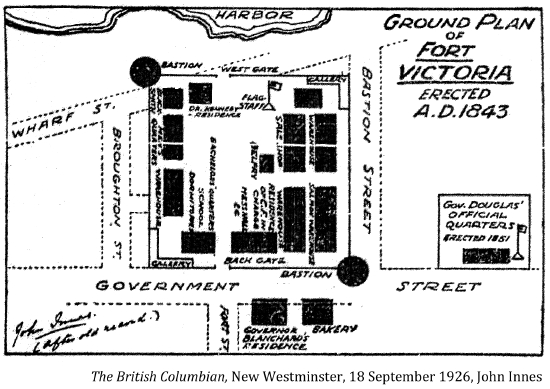
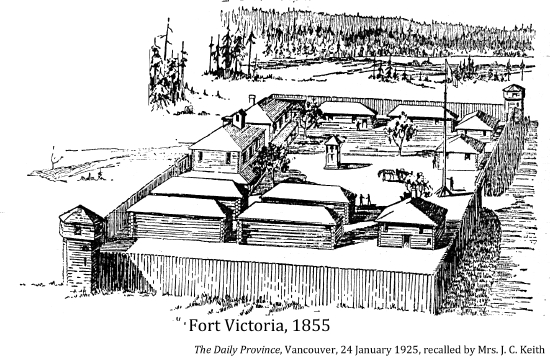
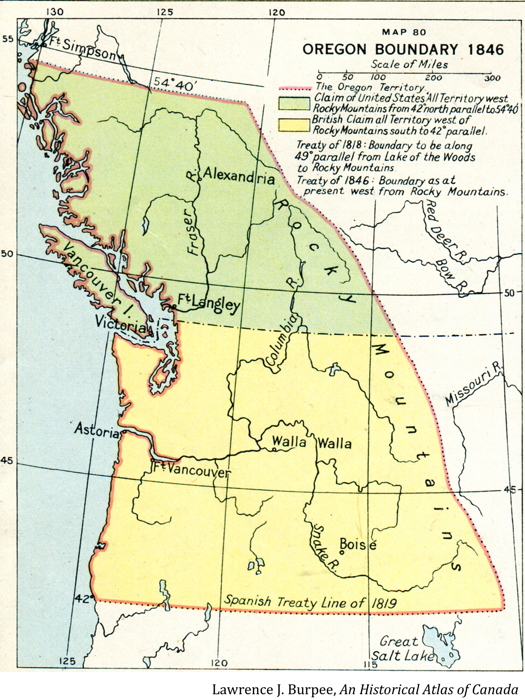
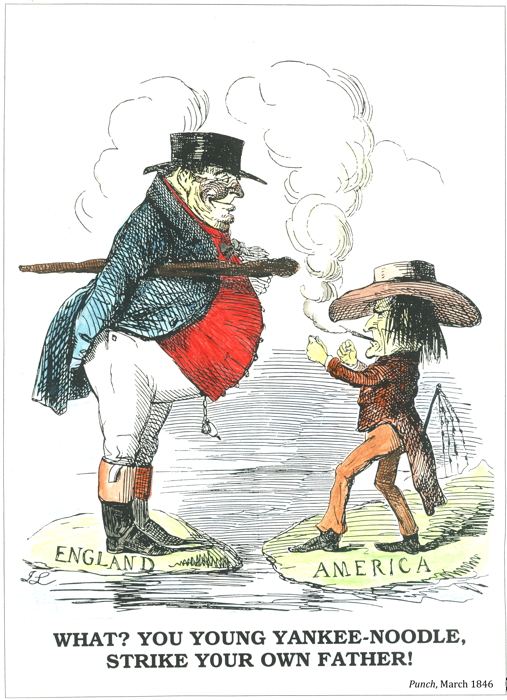
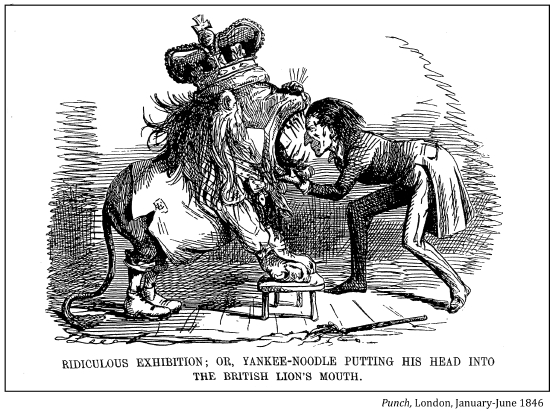
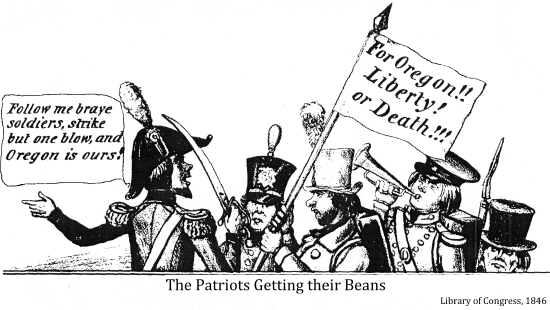
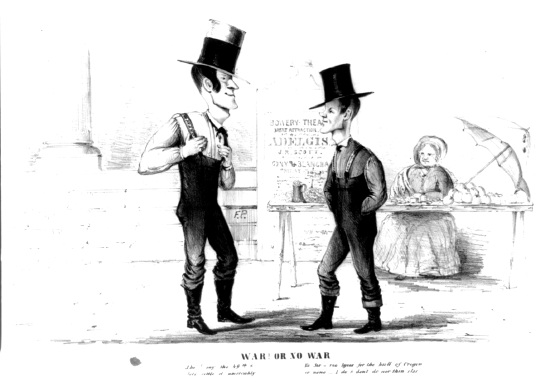
War or No War
MAN ON THE LEFT:"Ike! say the 49th & let's settle it amercably."
THE OTHER RESPONDS: "No Sir-ree I goes for the hull of Oregon or none--I do & don't do nor-thin else."
Odham, Thomas.; Palmer, F. (Fanny), 1812-1876.; F. & S. Palmer (Firm), 1846, Public domain, via Wikimedia Commons
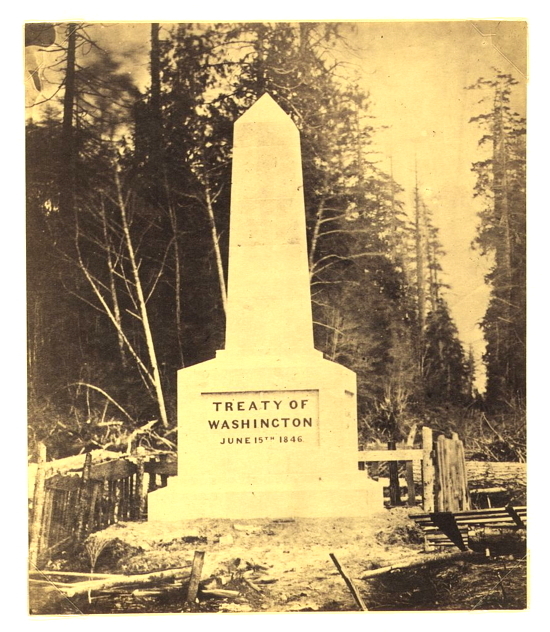
Boundary monument at Point Roberts, Treaty of Washington 15th June 1846, created 1861, LC2005680441
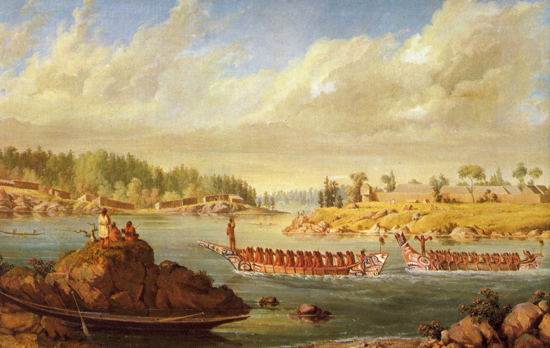
Return of a war party, Fort Victoria, Paul Kane, 1847
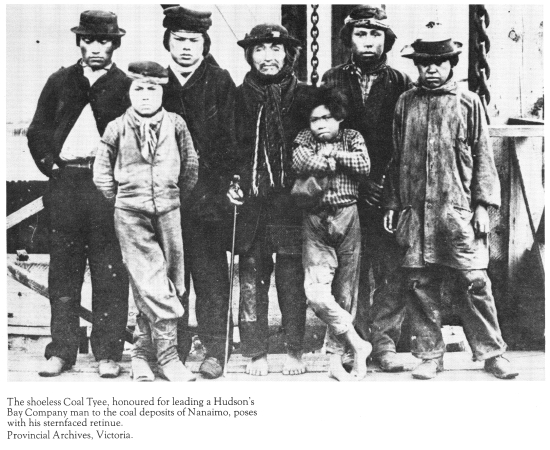
1849
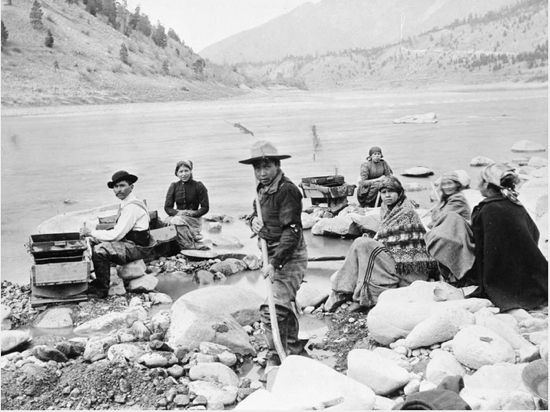
A First Nations family placer mining with sluice boxes and gold pans at the confluence of the Thompson and Fraser River near Lytton, British Columbia Archives, D-06815, 1890
"Gold was first found on Thompson's River by an Indian ¼ of a mile below Nicomin [sic]. The Indian was taking a drink out of the river. Having no vessel, he was quaffing from the stream when he perceived a shining pebble which he picked up and it proved to be gold. The whole tribe forthwith began to collect the glittering metal."
Governor James Douglas
"I have . . . sent a supply of shovels, washing pans and picks to the Indian diggers who will receive every encouragement at our hands to induce them to work the auriferous streams."
Governor James Douglas, 1857-58
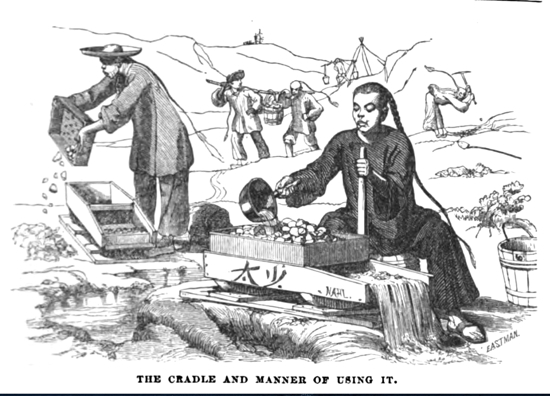
Hutching's California Magazine, San Francisco, July 1857
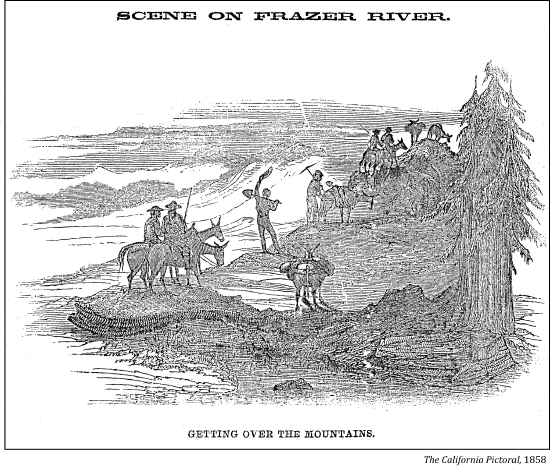
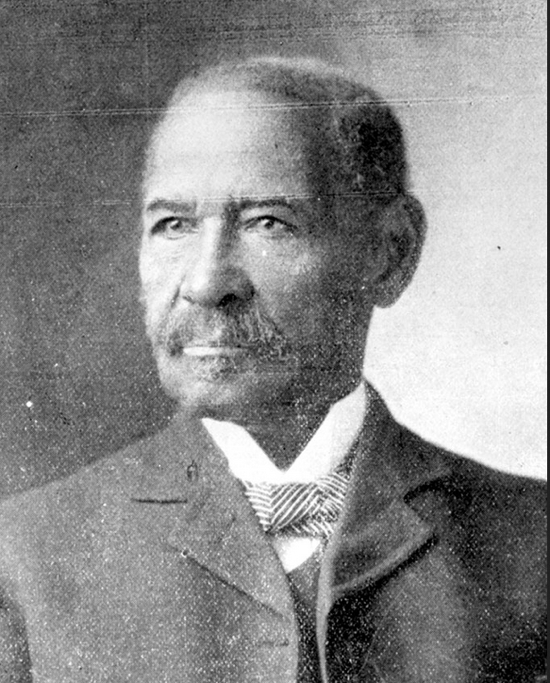
Mifflin Gibbs, BC Archives B-01601
At the invitation of Governor James Douglas, Mifflin Gibbs brought 600 black families from California to Victoria in 1858 Gibbs was a successful black activist, businessman and politician.
Lee Marvin, Wand'rin Star from Paint Your Wagon
https://www.youtube.com/watch?v=X5kq12xf1Uk
I'm On My Way, Paint Your Wagon
https://www.youtube.com/watch?v=qaUm38Vs_kc

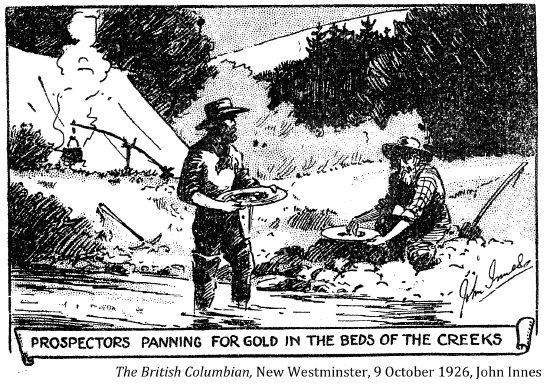
MINERS' SONG ON FRAZER RIVER. BY W. H. D.
Where mighty waters foam and boil,
And rushing torrents roar,
In Frazer River's northern soil,
Lies hid the golden ore.
CHORUS.
Far from home, far from home,
On Fraser River's shore,
We labor hard, so does our bard,
To dig the golden ore.
Far, from home we miners roam,
We feel its joys no more;
These we have sold for shining gold
On Frazer River's shore.
Each mountain height is shrouded white
From the Snow-King's icy store;
At them we gaze, thro' storms and haze,
And wish the winter o'er.
In cabins rude, our daily food
Is quickly counted o'er,
When home we come at set of sun.
To greet us at the door.
At night we smoke, then crack the joke,
Try cards till found a bore:
Our good-night said, we go to bed,
To dream of home once more.
With luck at last, our hardships past,
We'll start for home once more,
And greet the sight, with wild delight,
Of California's shore.
And when on shore, we never more
Will roam through all our lives;
A home we'll find, just to our mind,
And make our sweethearts––wives.
LAST CHORUS.
Then home again, home again,
From a foreign shore,
We'll sing how sweet our heart's delight
With our dear friends once more.
Emory's Bar, Fraser River, July 1859. Hutching's California Magazine, San Francisco.
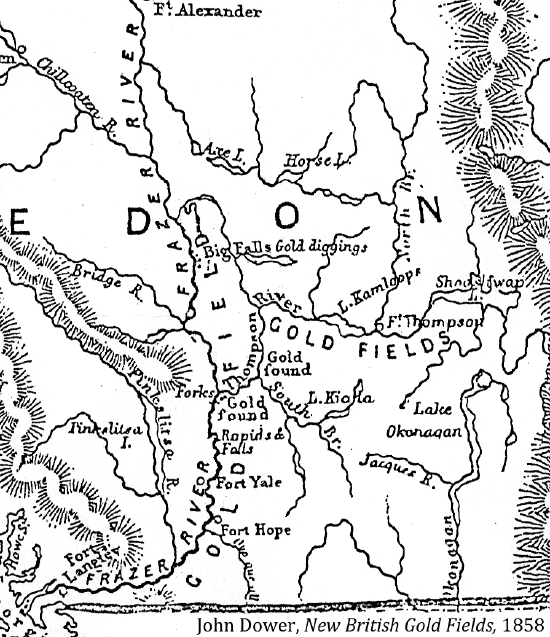
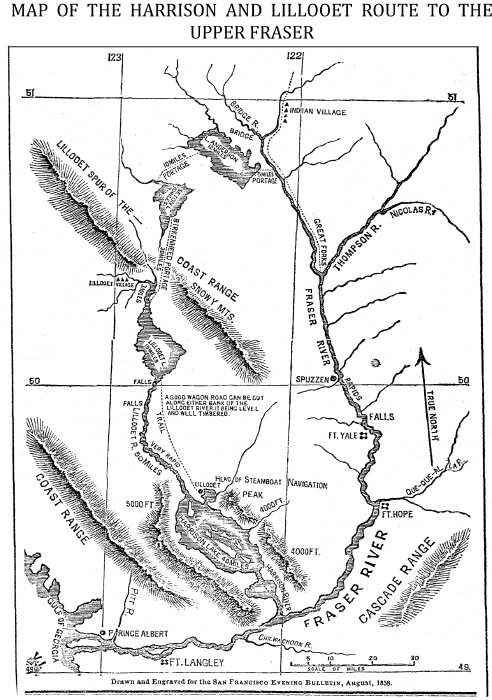
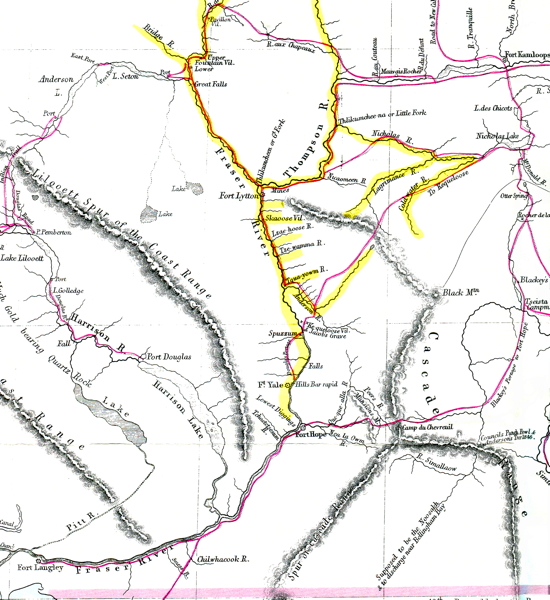

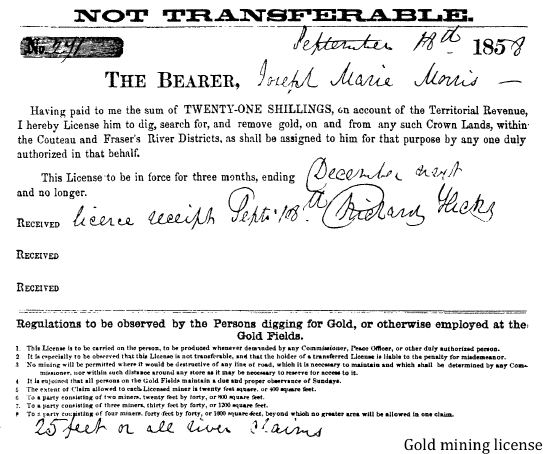
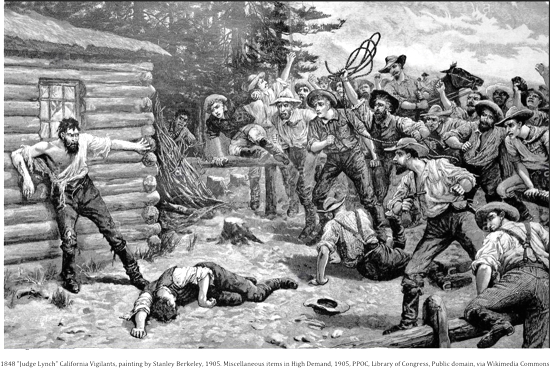
1848 "Judge Lynch" California Vigilants, painting by Stanley Berkeley, 1905. Miscellaneous items in High Demand, 1905, PPOC, Library of Congress, Public domain, via Wikimedia Commons
"From the beginning of the gold rush, British Columbia's Native Peoples, particularly those along the Cariboo Trail (Okanagan) and in the Fraser Canyon, were confronted with an influx of miners, packers, cattle drovers (cowboys), and settlers that could only be seen as an invasion of their territory. The majority of these incomers were from California or other areas of the Pacific Northwest, where the attitude toward the Native Peoples was distinctly racist. . . inevitably incidents arose in British Columbia from a lack of appreciation on the part of newcomers from the south that the Native Peoples were regarded as equals under British law."
Ken Mather, Trail North The Okanagan Trail of 1858-68 and it Origins in British Columbia and Washington
"[Speaking to the miners near Yale Governor Douglas says he] spoke with great plainness of speech to the white miners, who were nearly all foreigners . . . [that] they were permitted to remain there merely on sufferance; that no abuses would be tolerated; and that the laws would protect the rights of the Indian, no less than those of the white man."
Governor Douglas to Lord Stanley, 1858

John Ross Brown, "Protecting the Settlers", The Indians of California, 1864
[The handiwork of these well armed death squads combined with the widespread and random killing of Indians by miners resulted in the death of thousands of Indians in the first year of the California gold rush. - California Indian History, State of California.]

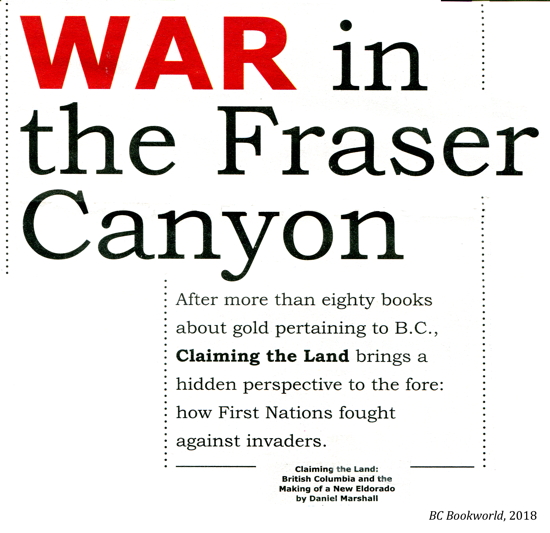
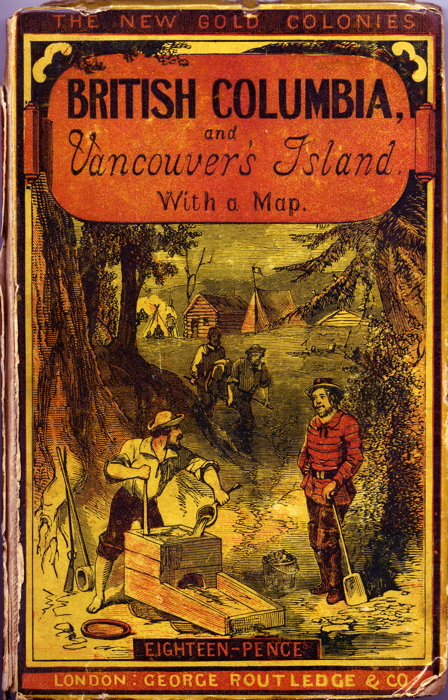
Rare books and special collection UBC
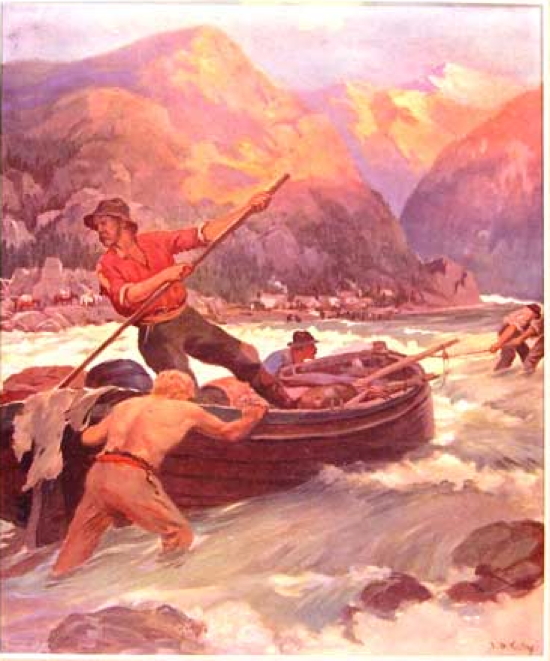
On the Old Cariboo Trail, J. D. Kelly

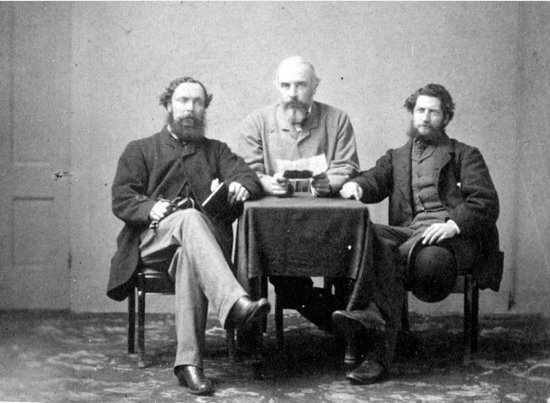
1859 Judge Peter O'Reilly, Chief Justice Matthew Baillie Begbie, and Captain H.M. Ball, Gold Commissioner. G.R. Fardon, BC Archives, A-01102

James Douglas taking the oath as First Governor of BC, Fort Langley, 19 November 1858, John Innes, 1925
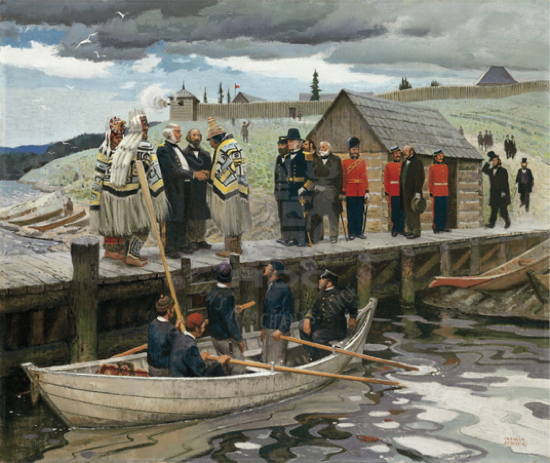
British Columbia becomes a colony, 19 November 1858
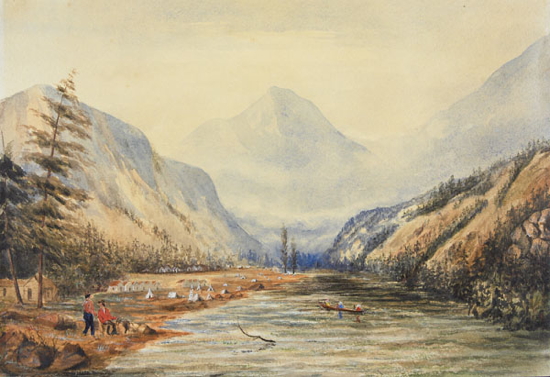
Marines Camp, Fraser River. LAC Acc. No. 1989-171-29, William Willis, 1859
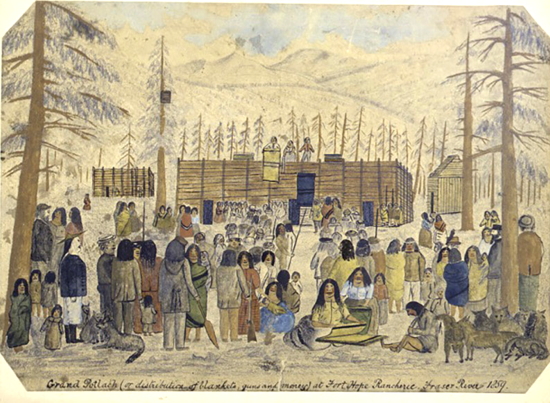
Grand Potlatch, Fort Hope, 1859
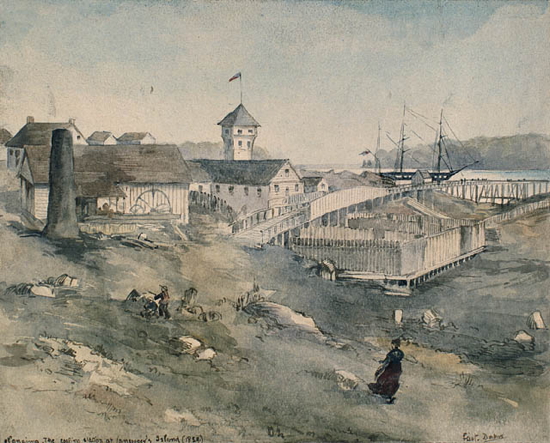
Nanaimo, The Coaling Station at Vancouver Island, 1859. LAC C-009561, Edward D. Panter-Downes, 1859
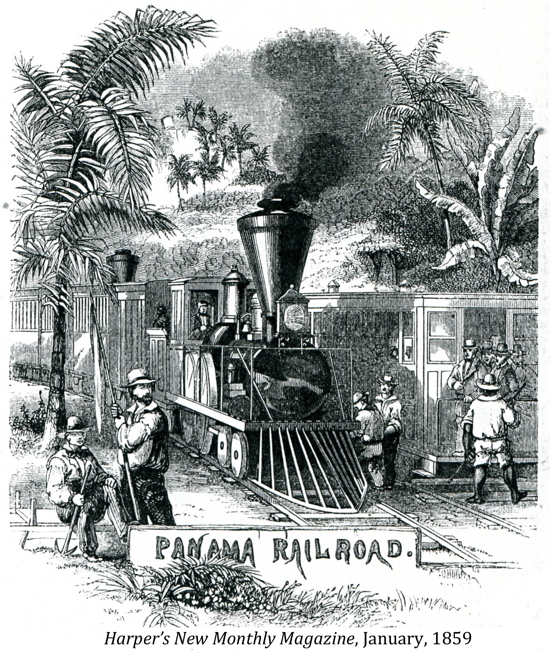
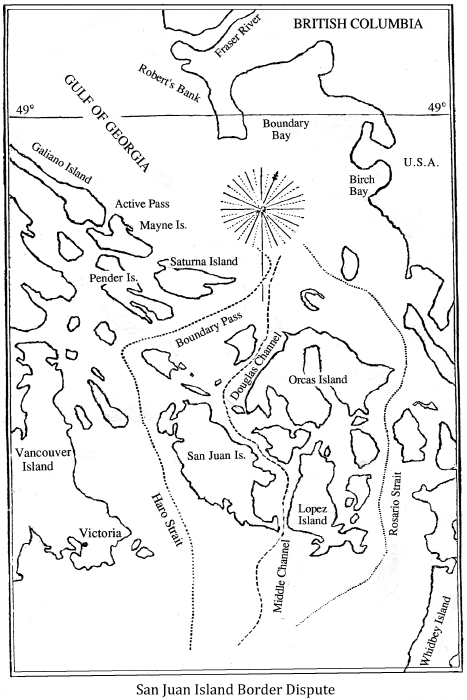
"Soon our banner will be streaming––
Soon the eagle will be screaming,
And the lion––see it cowers,
Hurrah, boys, the river's ours.
Now, hurrah, nor wait for calling,
For the Fraser river's falling."
Pioneer and Democrat, Olympia, Washington, 5 November 1859
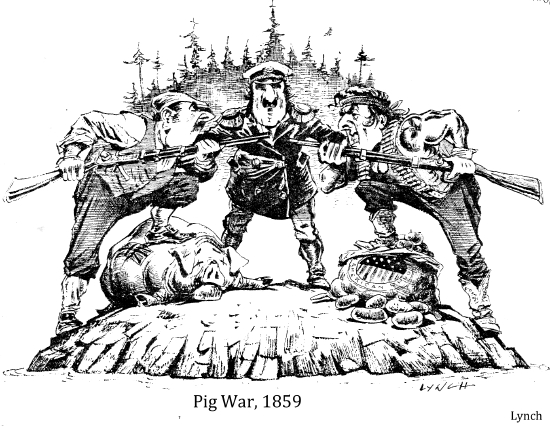
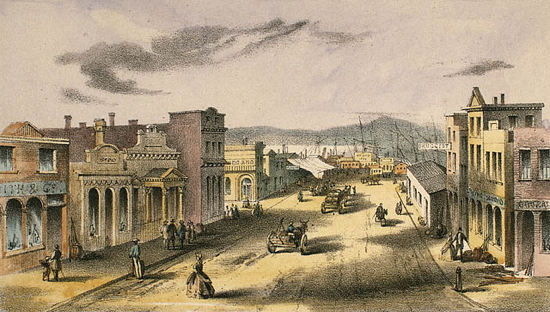
View of Victoria. Vue de Victoria, LAC C-001893, 1860?
"Settlement is the land grab we know as settler colonialism."
Jean Barman
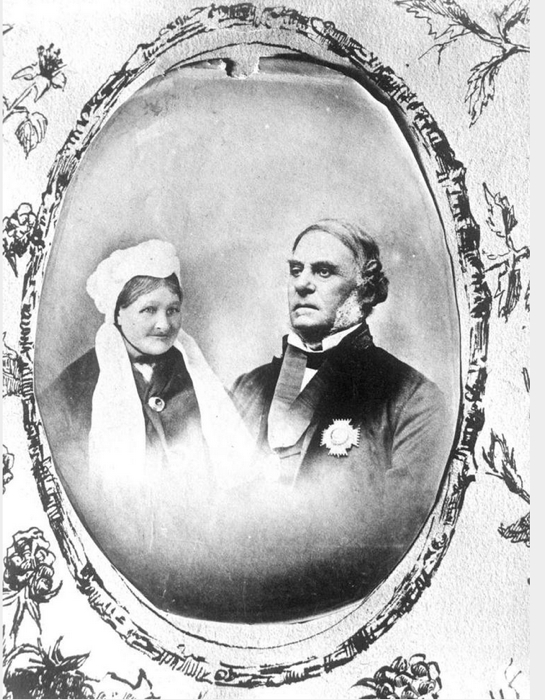
Sir James and Lady Douglas; composite photo ca. 1880 based on 1860s photos, BC Archives A-01230
[Governor James Douglas was born in British Guiana. His father was a Scottish planter and merchant from Glasgow. His mother was a Barbadian Creole (someone of mixed African and European ancestry who was not a slave), making him a "Scotch West Indian". Douglas married Amelia Connolly, the half Indian daughter of the chief factor of Fort St. James (Cree and Metis).]

Fort Yale and the Gold Hunters' Camp, Frazer's River. LAC Acc. No. R9266-1550 Peter Winkworth Collection of Canadiana, ca. 1860
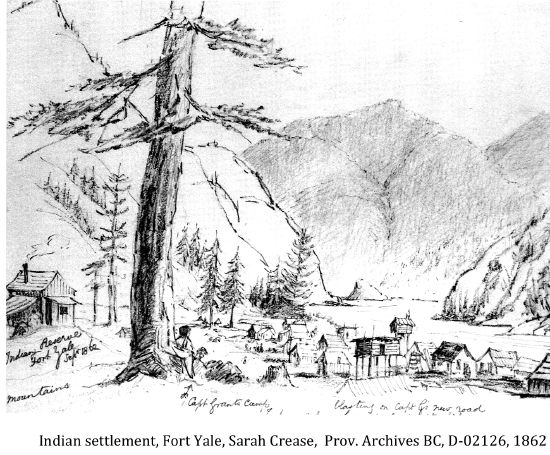
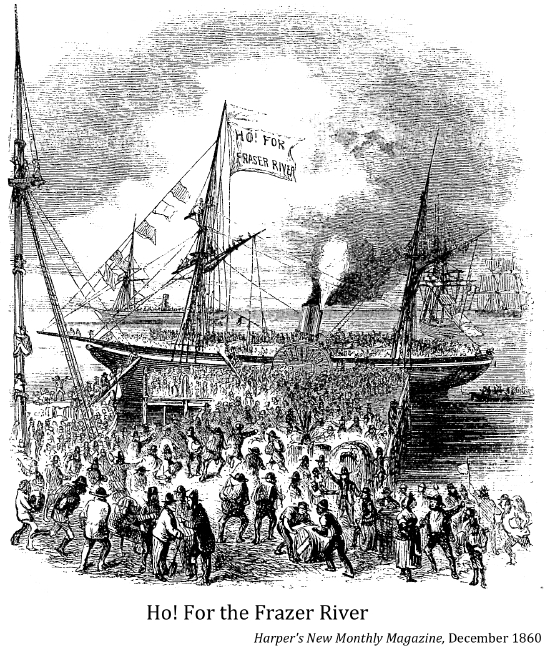

Negro Volunteer Military Company [Victoria Pioneer Rifles] formed between 1860 - 1862, disbanded in 1863 – 1864, LAC C-022626, Charles Gentile, ca. 1860-1864
[The black Volunteer Military Company [Victoria Pioneer Rifle Corps] was formed at the time of a war scare with the Americans over the San Juan border dispute. They were officially sworn in soon after the start of the American civil war in 1861. Blacks at the time were excluded from membership in the fire brigade. The corps were discouraged when prominent black colonists were refused tickets to a banquet honouring Governor Douglas on the eve of his retirement and when they were not allowed to march in a parade welcoming the new governor to the colony in 1864. LAC C-022626, Charles Gentile, ca. 1860-1864]
https://www.blackpast.org/global-african-history/victoria-pioneer-rifle-corps-1861-1865/
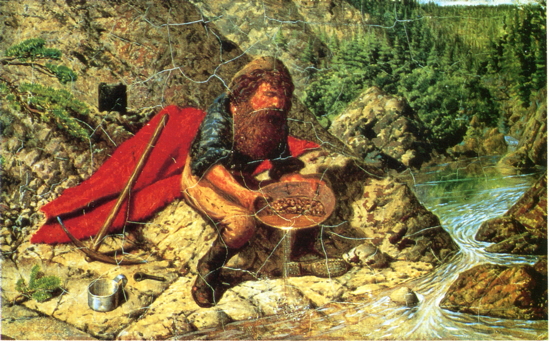
Panning for gold, Provincial Archives of BC, William Hind, 1864?
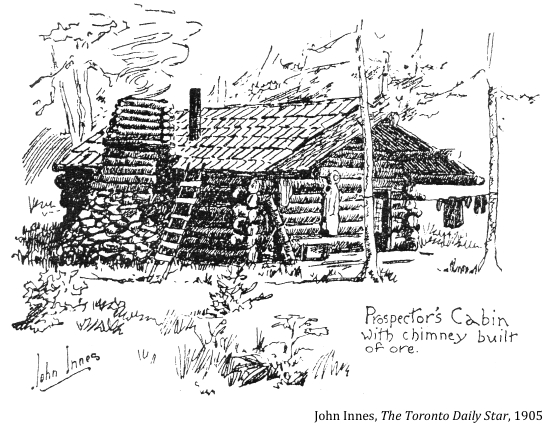
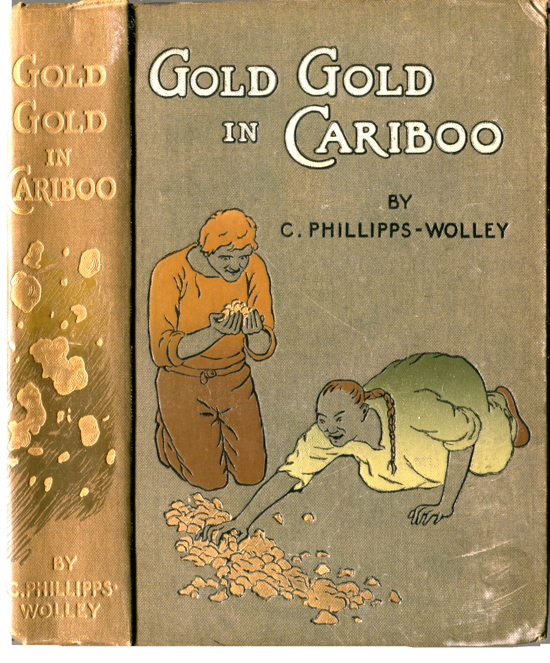
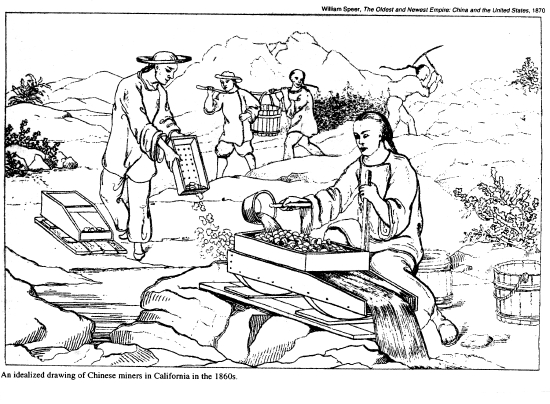
Miner's Own Book, 1858
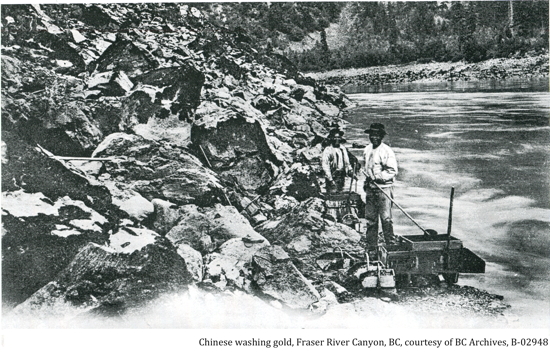

New Westminster, The Capital of British Columbia. LAC Acc. No. R9266-1554 Peter Winkworth Collection of Canadiana, F. L. Pope
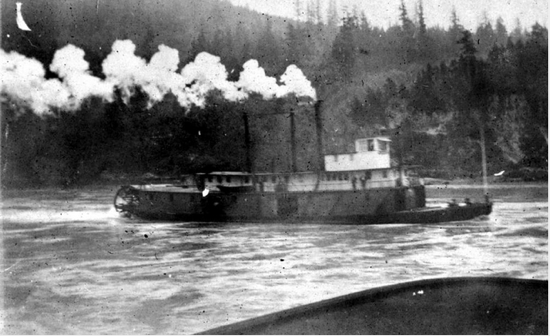
Sternwheeler Near Hope, 186-, BC Archives D-01083
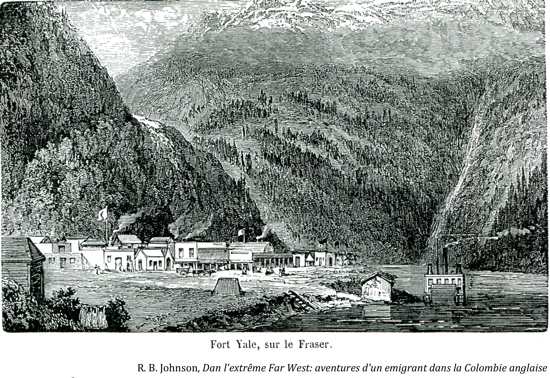
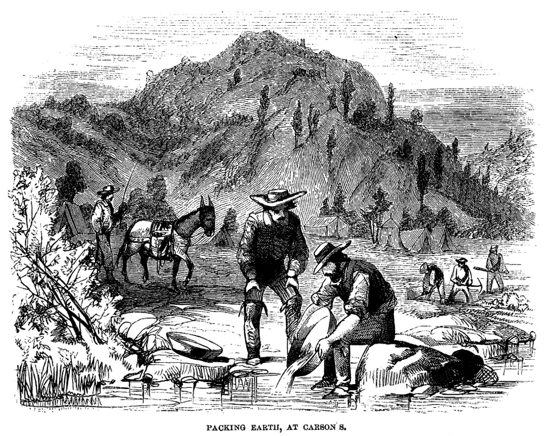
Packing earth, Harper's New Monthly Magazine, April 1860
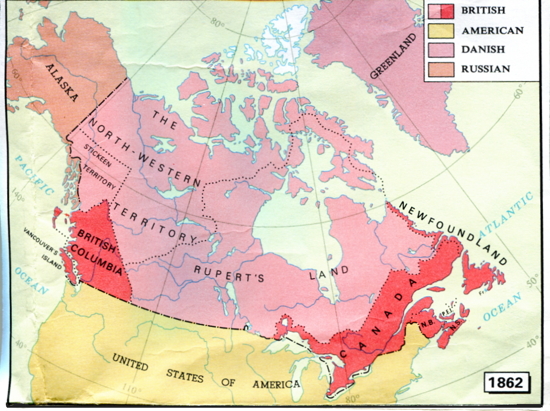
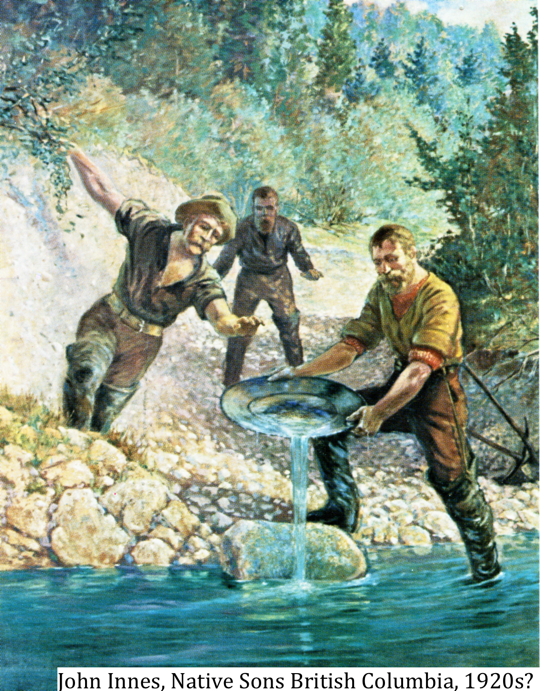
Finding Placer Gold by Pioneer Miners in the Cariboo, 1858, John Innes, 1925
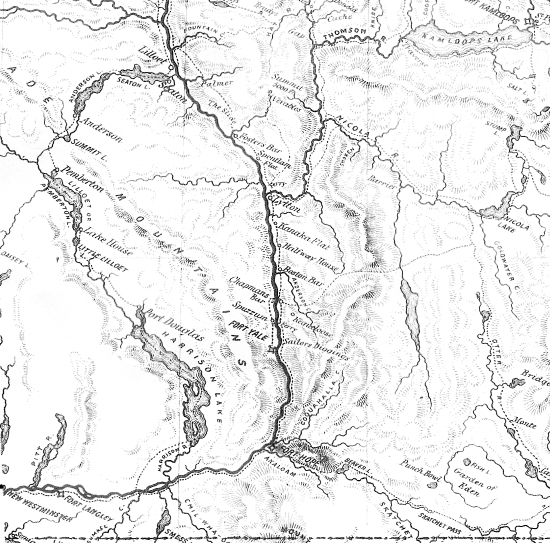
Gold Regions British Columbia, Compiled from Sketches and information by His Excellency James Douglas, C.B. Governor of British Columbia and Vancouver Island, -and from data obtained from the most intelligent and reliable Miners, Gust. Epner, San Francisco, 1862
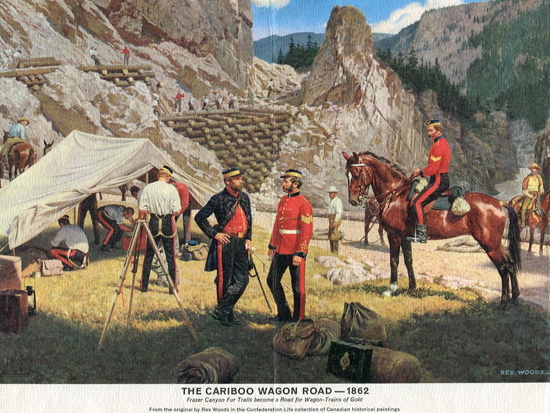

The British Colonist, Victoria, 18 March 1862
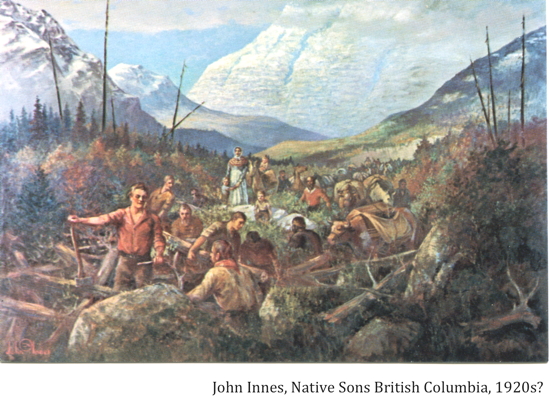
The Overland Pioneers Journeying Through the Rockies, 1862, John Innes, 1925

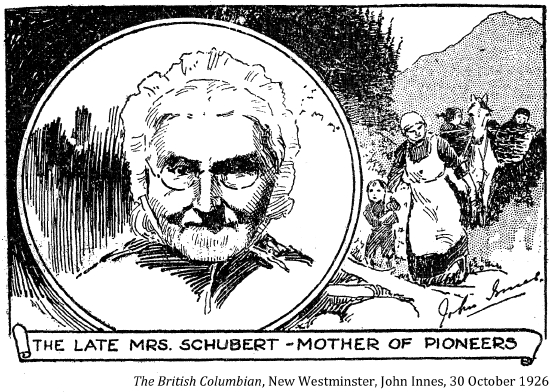
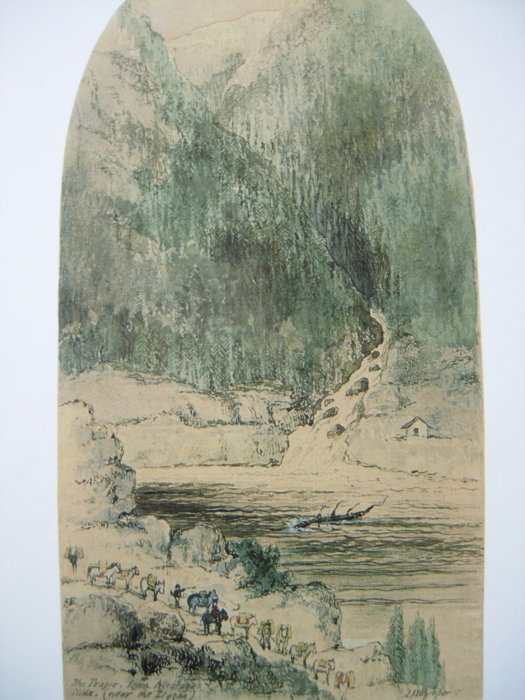
The Fraser Canyon by Frederick Whymper, 1863?, Image PDP00107 courtesy of
Royal BC Museum, BC Archives
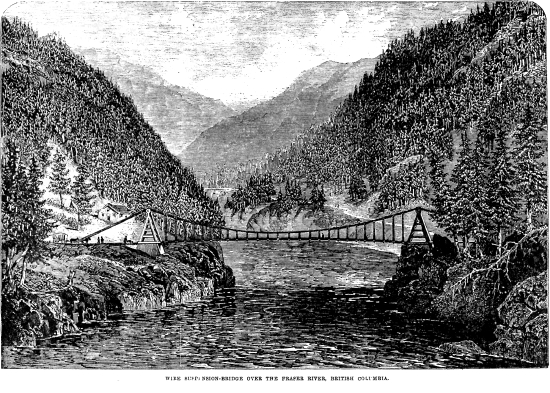
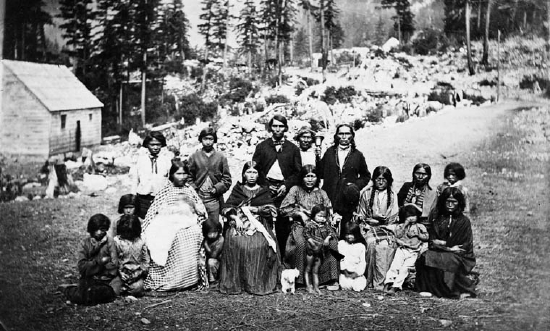
Indian group at Boston Bar. LAC C-088948, 1863-1867
Smallpox epidemic, April 1862 - fall 1863.
"In over the 18 months that began in April of 1862, at least half and perhaps well over half of all the people living in B.C. – most of them first nations – perished in a single event .
During the Spanish Flu pandemic of 1918, . . . the mortality rate in Canada was 6.1 per cent. . . . The mortality rate for the 1862 smallpox epidemic was greater than 60 per cent. . .
Anglican Bishop George Hills visited the Haida and Heiltsuk camps. The sick, burning with fever, threw themselves into the sea. The helpless dying lay packed together. The stench was intolerable. 'I have never witnessed such horrible scenes of death, misery, filth and suffering before,' Hill later wrote. . .
These mass deaths tore irreparable holes in the cultural fabric of societies in which oral traditions were the custodians of the genealogies, laws, histories and literature of entire peoples.
And then settlers moved in to occupy apparently vacant lands in some of the richest regions of the province . . .
Those momentous events . . . shaped the B.C. that we inhabit. Their aftershocks continue to shudder through the political and social bedrock of our present in the form of unresolved land claims, inadequate reserve lands as populations finally rebound from their nadir a century ago, and the legacy of marginalized and impoverished communities that have been alienated from resources and are frequently blamed for their impoverishment."
Stephen Hume, "Titanic disasters, selective memories," The Vancouver Sun,
25 April 2012.
"Over sixty men, women and children of this tribe have already fallen victim to the terrible disease [smallpox]. The propriety or otherwise of extending to these poor creatures some slight government relief has been the cause of great anxiety, but I felt that in the face of disallowances which already reach a very heavy sum, I could not take the responsibility of such a step."
Colonial Correspondence, Elwyn to Young, 27 January 1863, F526/1 BCA
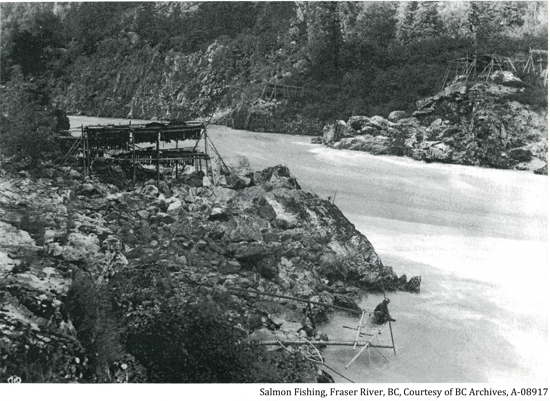
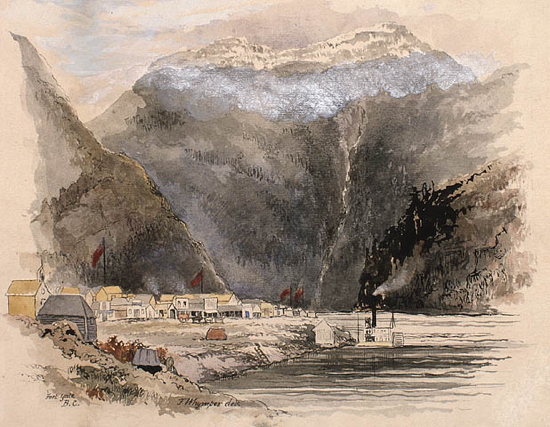
Fort Yale, B.C. LAC Acc. No. 1935-124, Frederick Wymper, ca. 1863
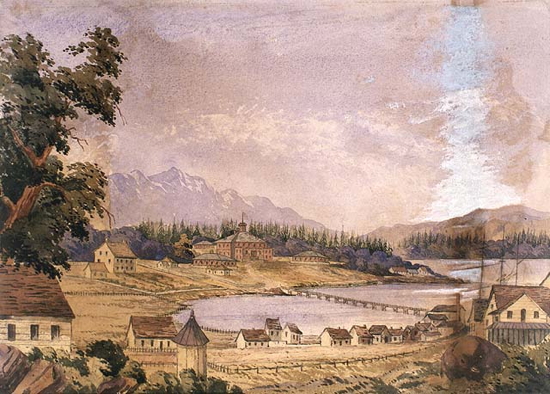
Victoria, Vancouver Island. LAC Acc. No. 1935-125, Frederick Whymper, 1863
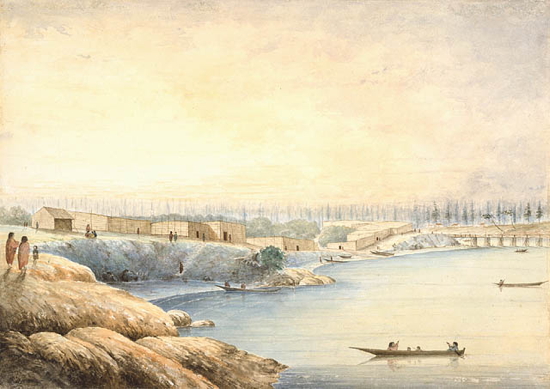
Songish Village Opposite Victoria, Vancouver Island. LAC Acc. No. 1981-55-16 David J. Bushnell Collection, Edward Parker Bedwell, before 1863

Victoria (British Columbia). Acc. No. R9266-342 Peter Winkworth Collection of Canadiana. Edward M. Richardson, 1864
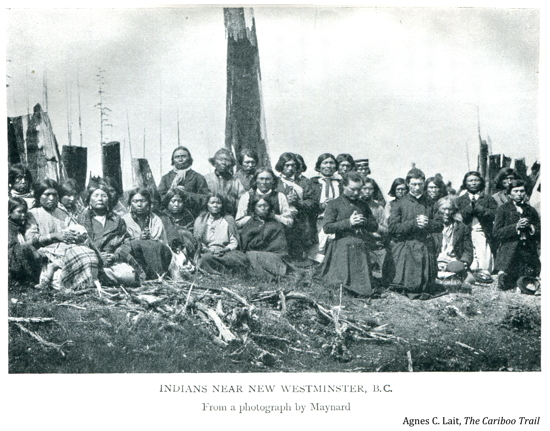
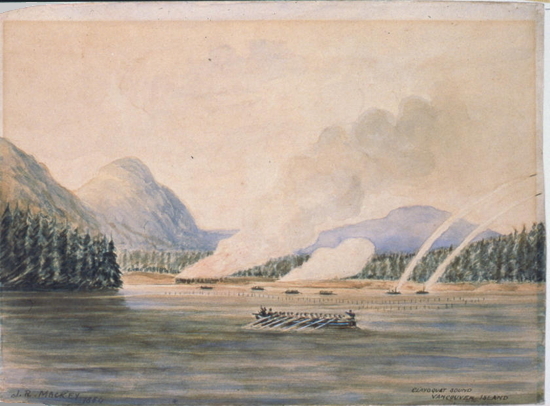
Attack on village in Clayoquot Sound by boats of HMS Sutlej and HMS Devastation, BC Archives, J. R. Mackey, PDP00084¬_141, 1864
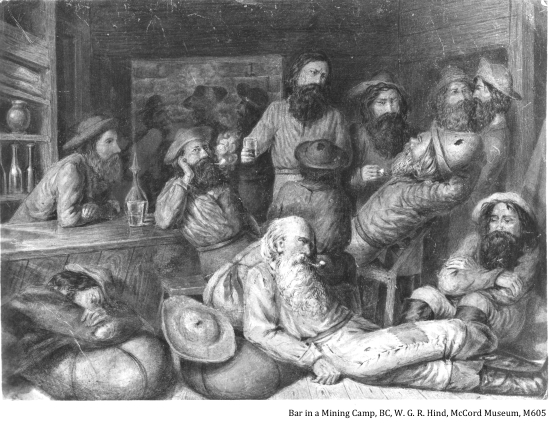
.jpg)
Cabin on the Fraser River, BC, W.G.R. Hind, McCord Museum M471
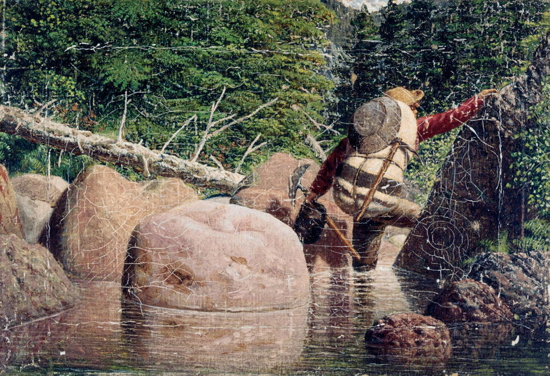
Gold Digger, William Hind, BC Archives PDP00026_141
Far From Home
https://www.youtube.com/watch?v=UbNBKFox3Jg
Young Man From Canada
https://www.youtube.com/watch?v=3NrYUPW9ZZc
Teaming up the Cariboo Road
https://www.youtube.com/watch?v=TahHRipIcqY
http://www.songsforteaching.com/socialstudies/canada/cariboucaribooroadbritishcolumbia.htm
The Lousey Miner
http://twain.lib.virginia.edu/roughingit/map/minlousy.html
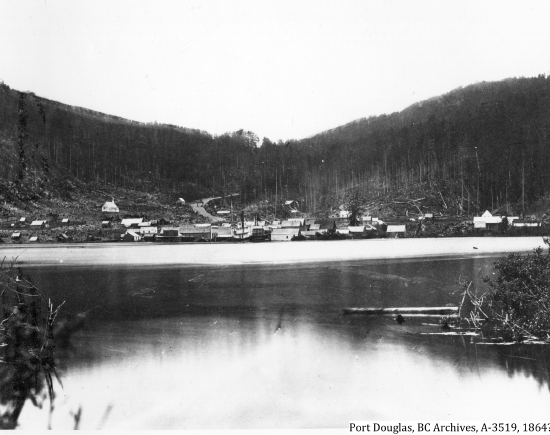
The Population of Port Douglas (1864?)
Coloured men 8
Mexicans and Spaniards 29
Chinese 37
French and Italians 16
Central Europe 4
Northern Europe 4
Citizens of the United States 73
British Subjects 33
Total 206
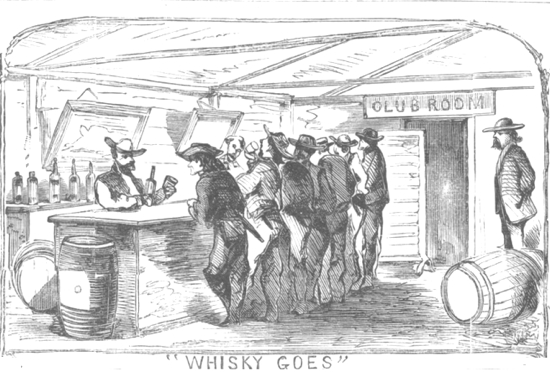
Whiskey, Harper's Weekly, New York, 24 April 1869
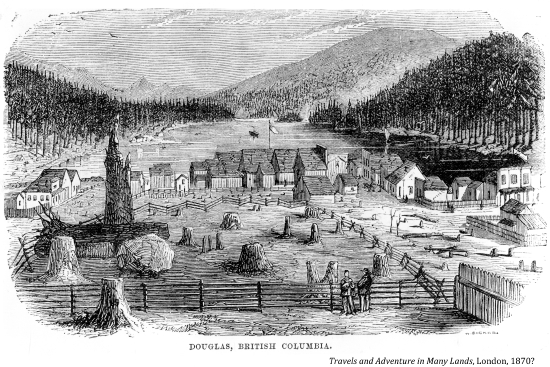
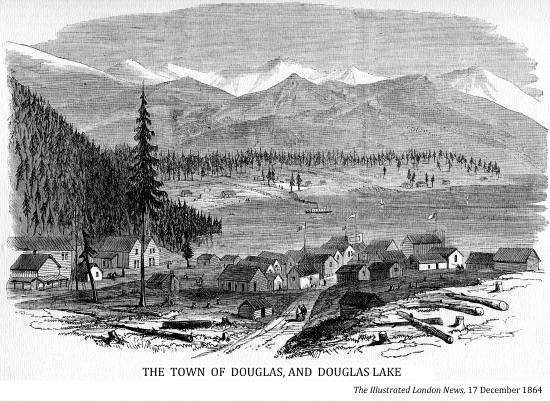
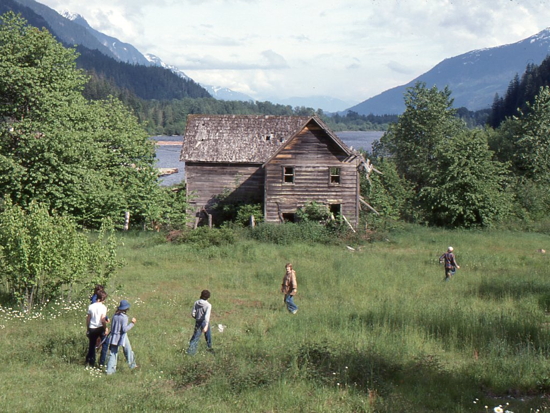
Port Douglas 1976
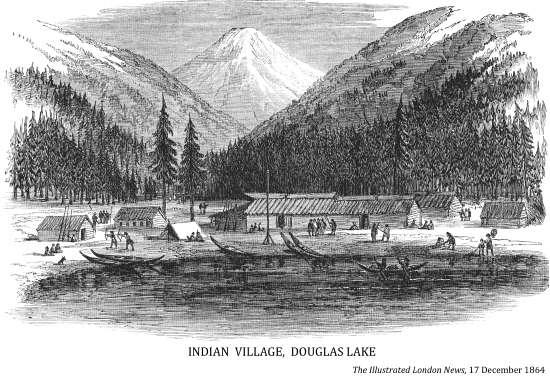
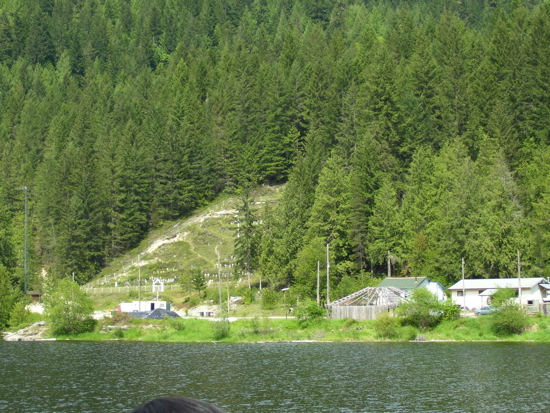
Port Douglas 1995

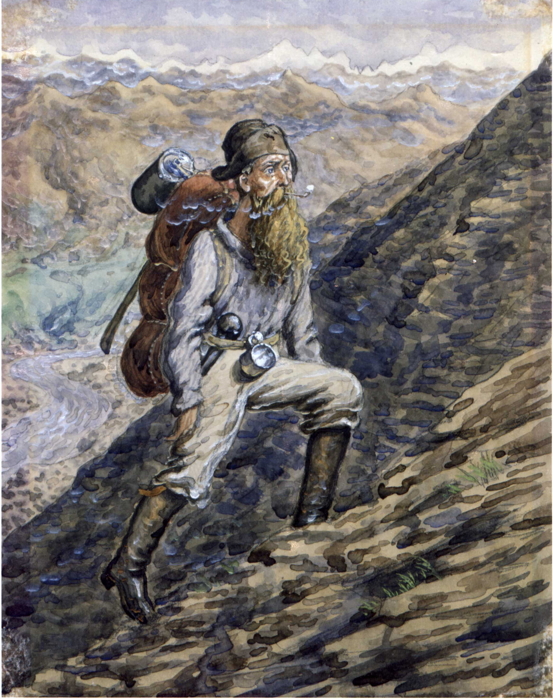
A miner in the Rocky Mountains, by William Hind, 1864. Image PDP00028 courtesy of Royal BC Museum, BC Archives
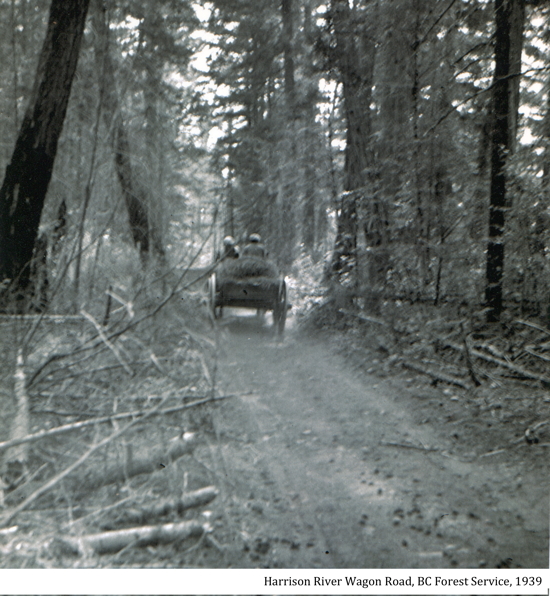
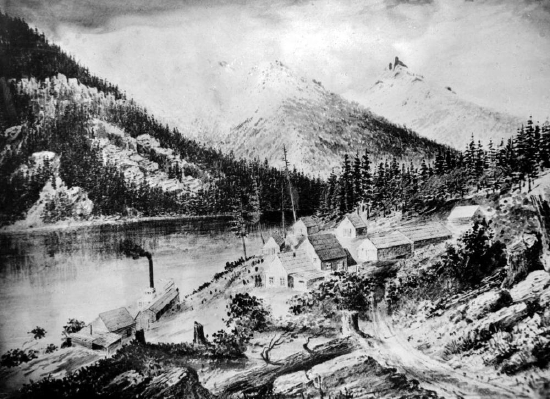
29 Mile House, Tenass Lake
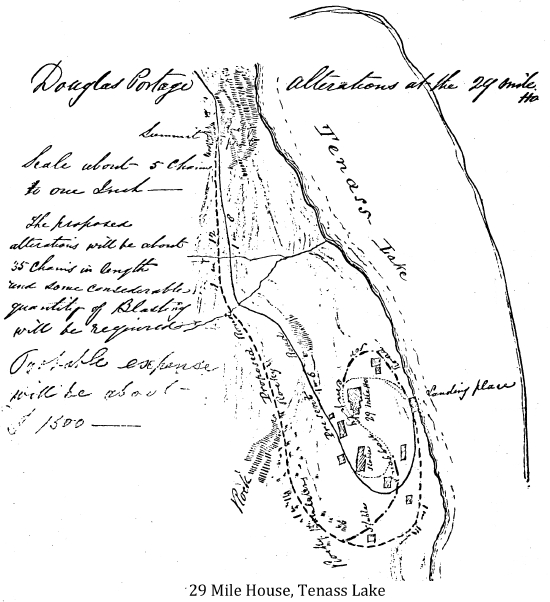
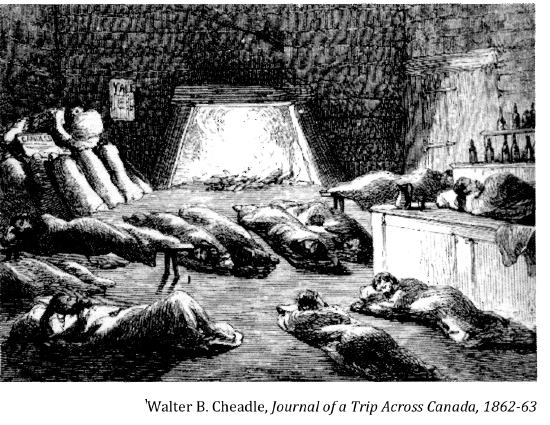
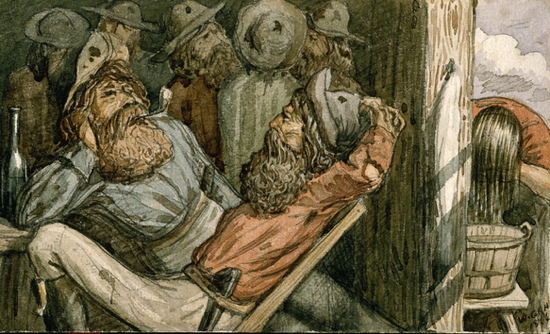
British Columbia Miners, W. G. R. Hind, 1864, BC Archives PDP00014


29 Mile House, 1863 BC Archives D-07905
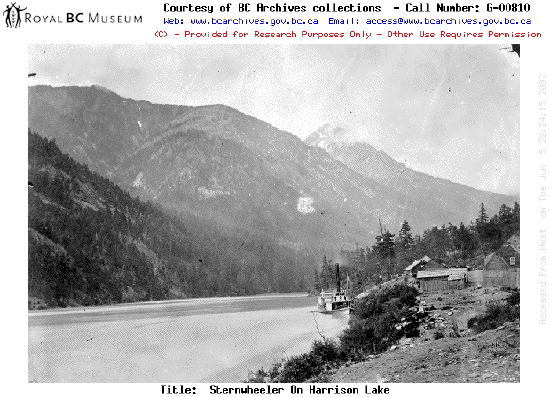
Sternwheeler on Tenass Lake, 29 Mile House
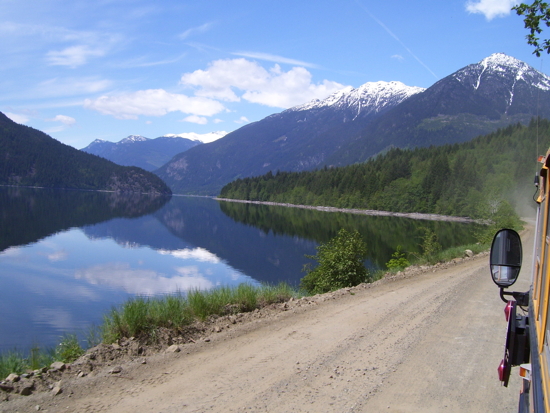
Lillooet Lake 1995

Chinese Gold Washers on the Fraser River, BC, McCord, M609
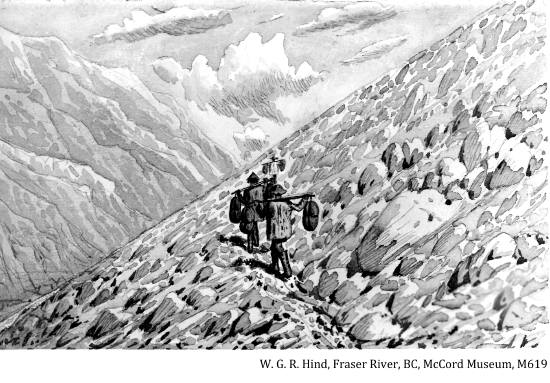
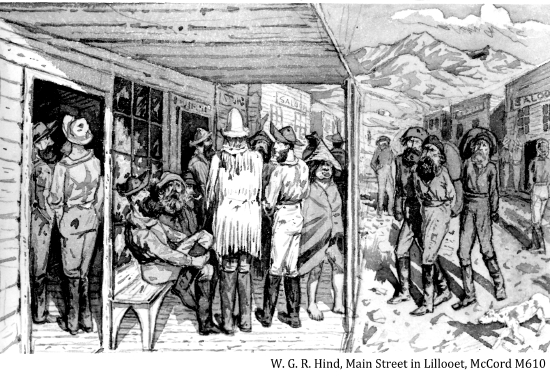
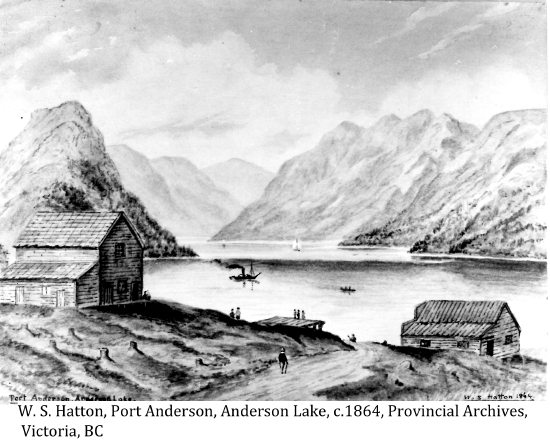
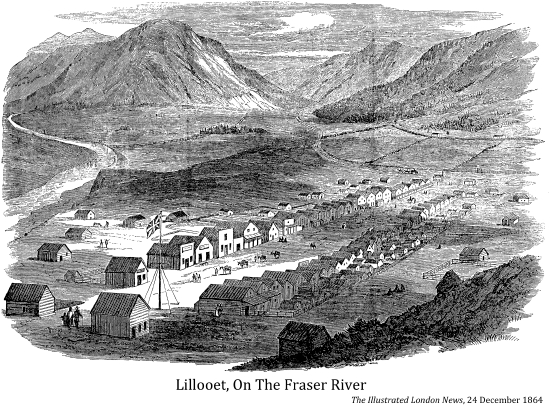
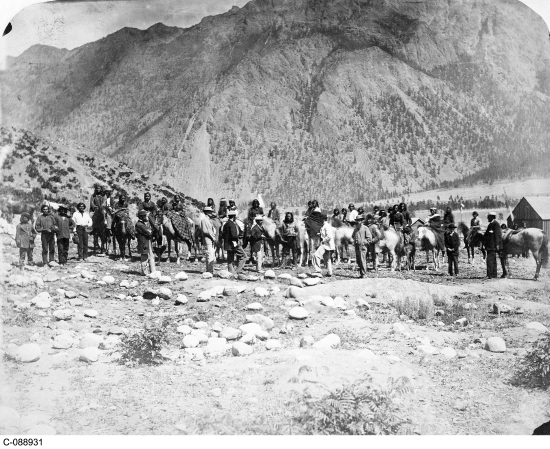
Lillooet Indians., LAC C-088931, Charles Gentile, Lillooet, 1865
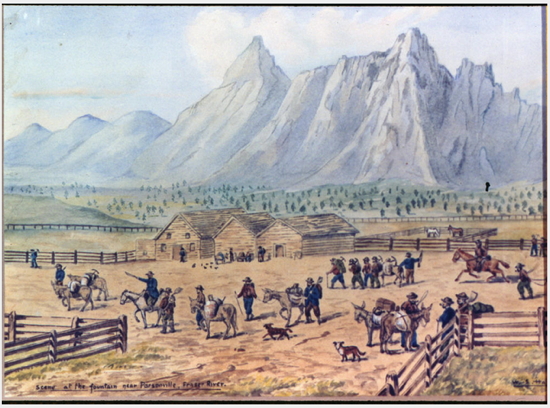
Scene at the Fountain near Parsonville, Fraser River, The London Illustrated News, 17 December 1864, BC Archives PDP02610
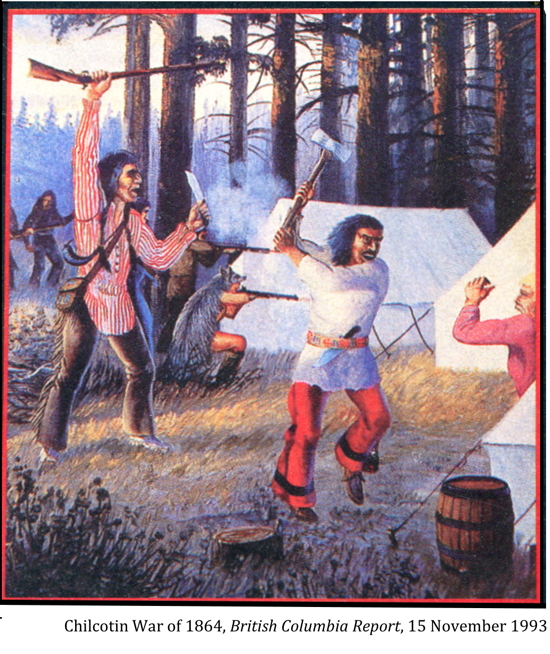
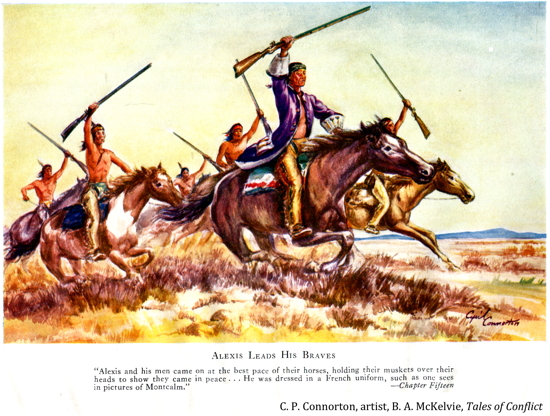
"Klatassin claimed that they were at war with the invaders, and that it was the threat of smallpox the drove their action."
Stephen Bown, Dominion The Railway and the Rise of Canada
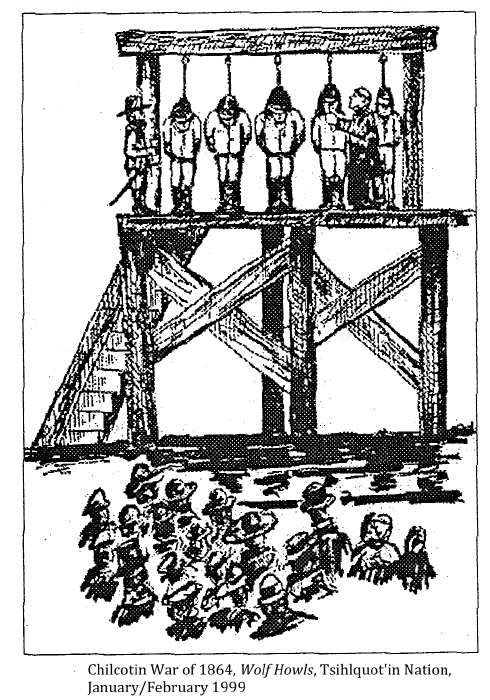
Chilcotin War
https://nationalpost.com/news/canada/what-really-happened-in-the-chilcotin-war-the-1864-conflict-that-just-prompted-an-exoneration-from-trudeau
https://en.wikipedia.org/wiki/Fraser_Canyon_War
"In the summer and fall of 1862 the Tsilhqot'in people died by the thousands. At least 70 percent of the whole population perished from one cause alone [smallpox]. . . This was a truly great calamity. . . Native people universally believed settlers had imported and spread smallpox among them for their land. . . The British Crown hung five Tsilhqot'in officials. This was one of the most dramatic moments in all Canadian history. BC Colonial officials had chosen to pretend these Tsilhqot'in were common criminals. Murderers. The Tsilhqot'in people knew them instead as martyrs. True noble men who died serving their people by faithfully following the established law and by honorably defending the people in a just war against a proven aggressor."
Tom Swanky, The True Story of Canada's "War" of Extermination On the Pacific plus The Tsilhqot'in and other First Nations Resistance
"We meant war not murder."
War leader defence
"The Tsilhqot'in were induced by a false promise [a peace conference with the Governor]."
Matthew Baillie Begbie
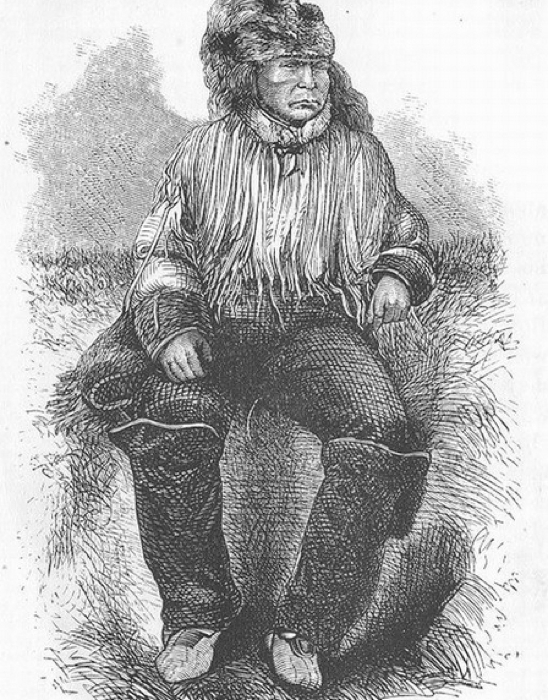
[Klatassine was one of the Tsilhqot'in leaders hung in 1864. Drawn by the missionary Robert Christopher Lundin Brown in 1873].
"Madame Speaker, I stand here today in this Legislature, 150 years later, to say that the province of British Columbia is profoundly sorry for the wrongful arrest, trial and hanging of the six chiefs and for the many wrongs inflicted by past governments. . . Smallpox, which by some reliable historical accounts there is indication was spread intentionally. . . To the extent that it falls within the power of the province of British Columbia, we confirm without reservation that these six Tsilhqot’in chiefs are fully exonerated of any crime or wrongdoing."
Premier Christy Clark, 2014
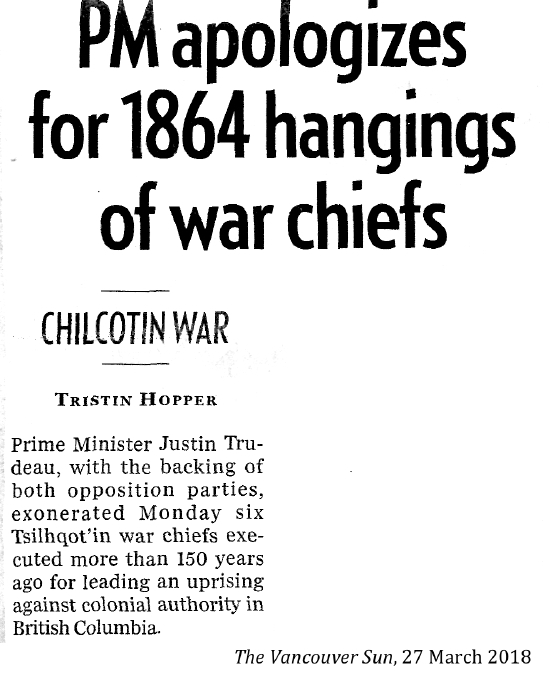
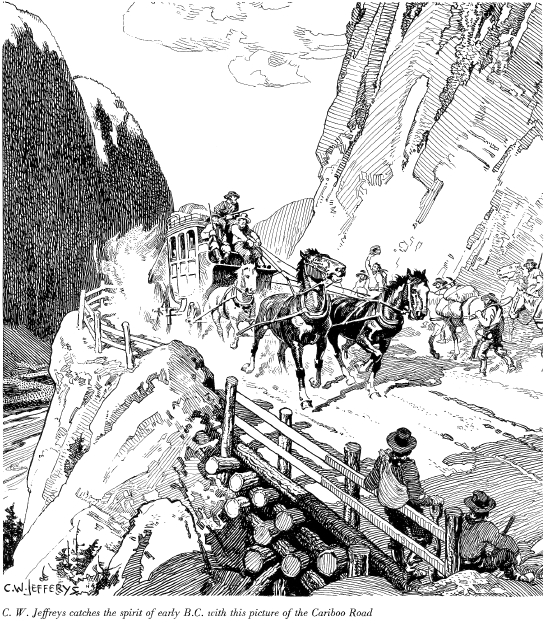
Teaming Up the Cariboo Road
https://www.youtube.com/watch?v=TahHRipIcqY

John Innes
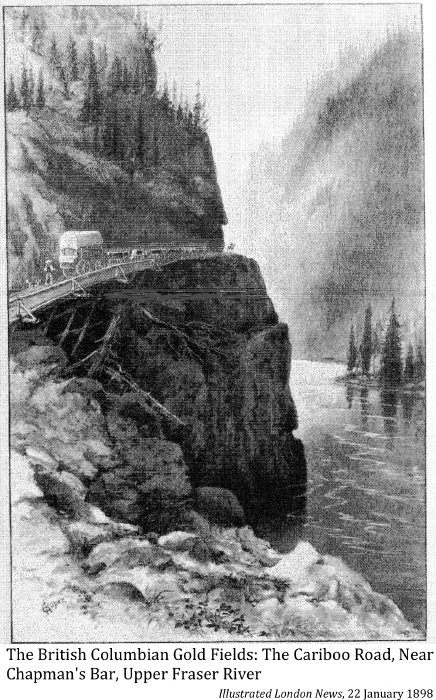
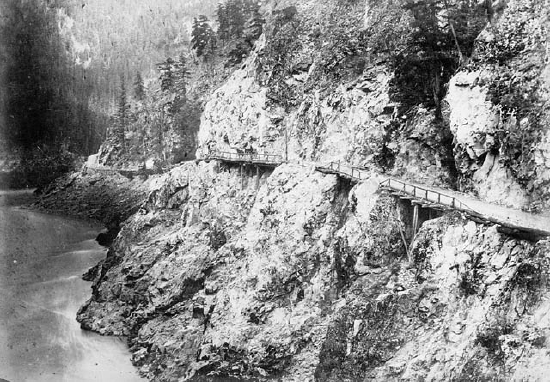
Cariboo - wagon road 17 miles above Yale River. LAC PA-023270
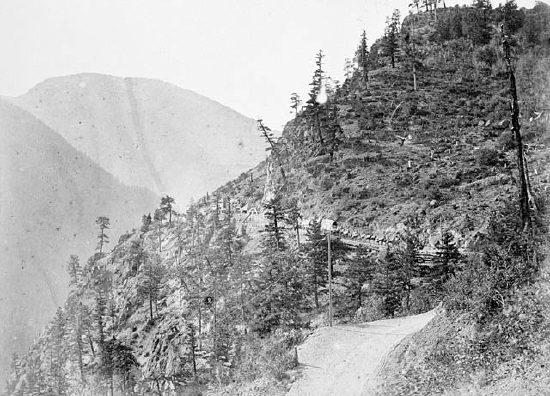
On the Cariboo Road, Jackass Mountain. 1867-68, LAC C-037836
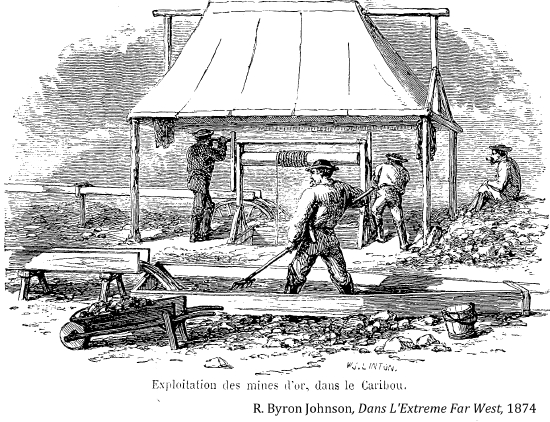
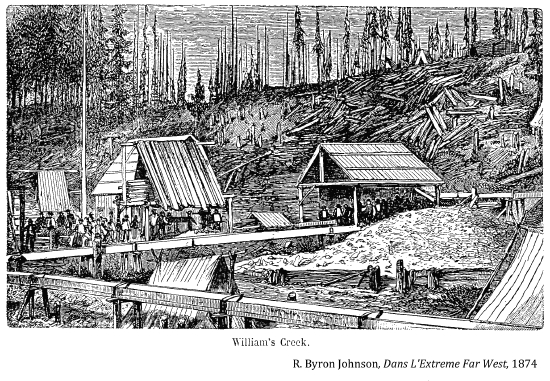
%20June%20native%20land.jpg)
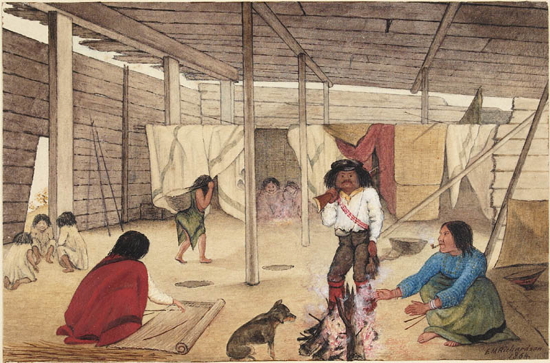
Interior of a Salish Longhouse. LAC Acc. No. R9266-343 Peter Winkworth Collection of Canadiana, Edward M. Richardson, 1864
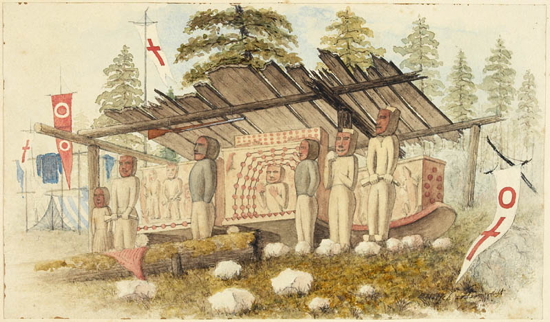
A Salish Grave, British Columbia. Une tombe Salish. LAC R9266-344 Collection de Canadiana Peter Winkworth, Edward M. Richardson, ca.1864
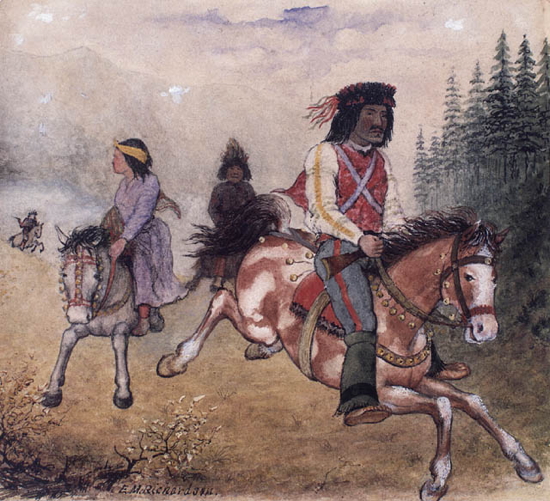
Williams Lake Indians. Les indiens du lac Williams. LAC Acc. No. 1937-133-1, Edward M. Richardson
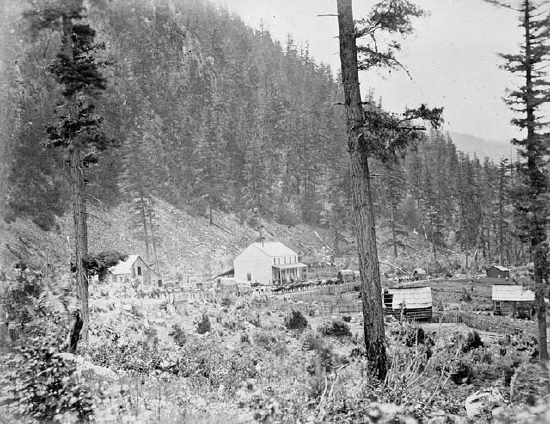
Drink shop on road to Cariboo Mines. Mule and bullock teams stopping. (Alexandra Lodge at Chapman's Bar) LAC C-034945, 1866?
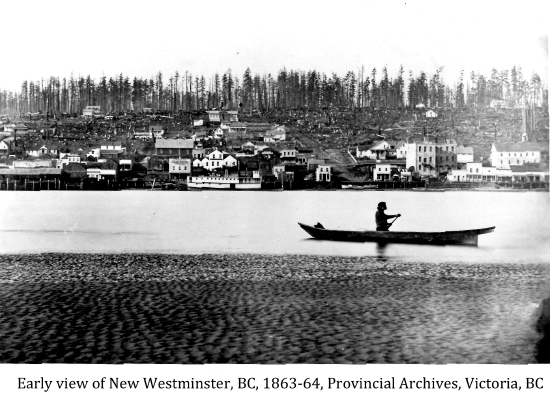

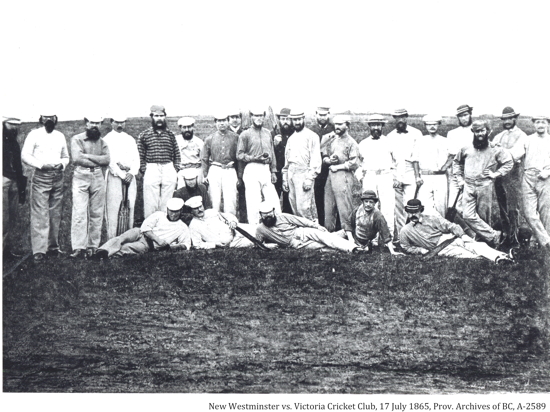
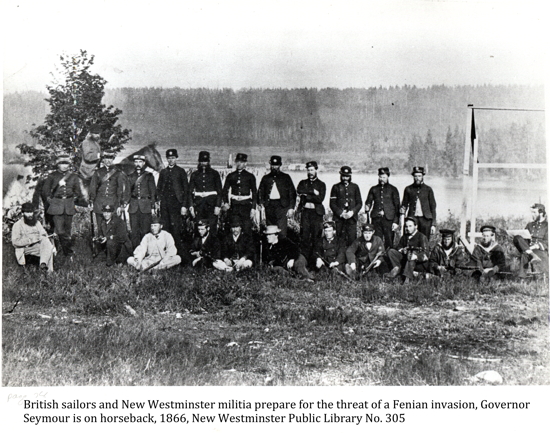
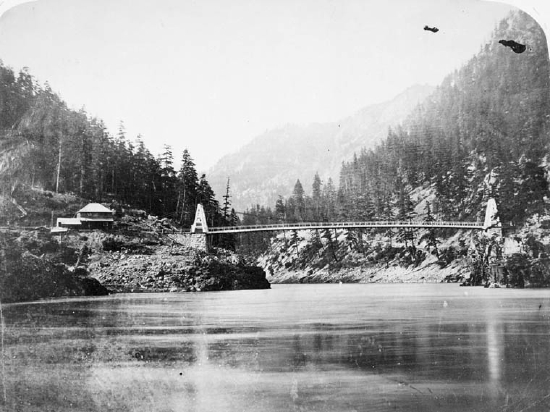
Alexandra Suspension Bridger over Fraser Rivern the Fraser River, 14 miles above Yale. C-088889, Charles Gentile, 1864-67

Part of Cariboo Road B.C. LAC Francis McLennan C-029180, 1867-68
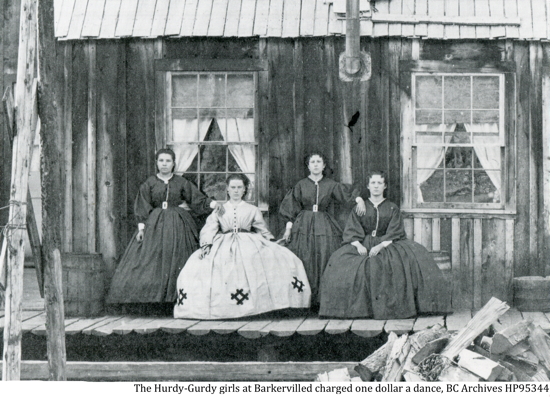
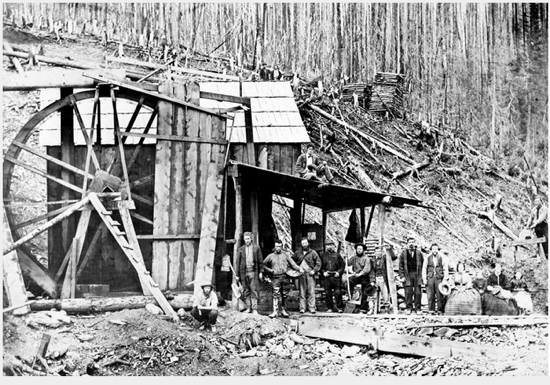
Alturas Gold Mining Co. in Stout's Gulch, near Barkerville, Frederick Daily, ca. 1868,
BC Archives A-04919
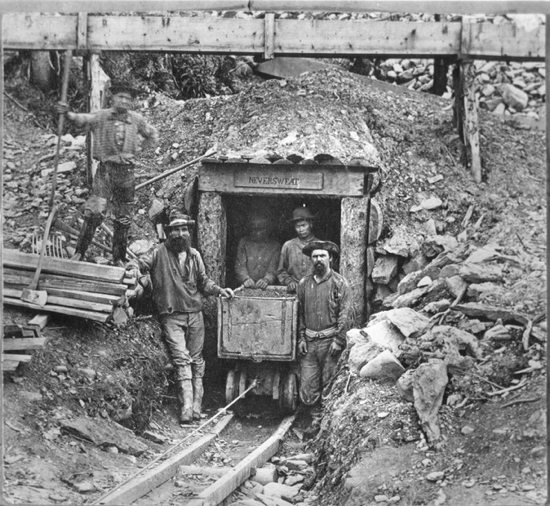
Shaft Entrance Of Neversweat Tunnel Co. Claim, Williams Creek, 1868?, BC Archives A-00937
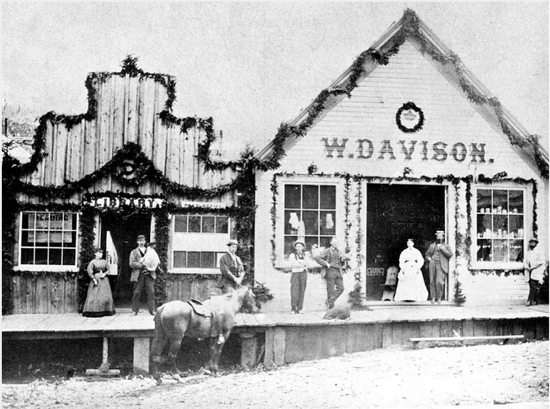
Barkerville Library, with Mr. and Mrs. John Bowron in the doorway, Mr. and Mrs. D. Davison in door of grocery shop, 1 July 1871, BC Archives, A-03770
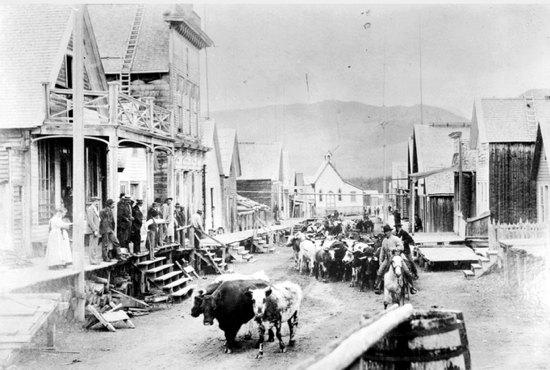
Main Street, Barkerville; cattle drive, 1875, BC Archives A-03787
[Over 22,000 cattle were driven north from California, Oregon and Washington, via the Okanagan Valley, to the upper Fraser River and Barkerville. between 1859 and1868. Other supplies came this way until the Cariboo Wagon Road was completed.]
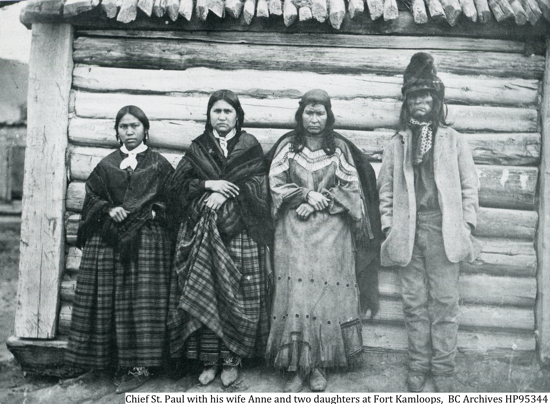
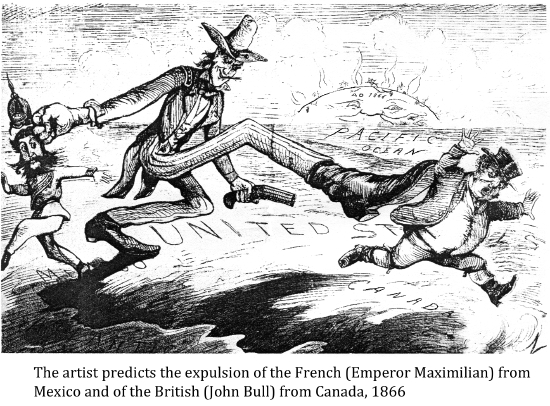
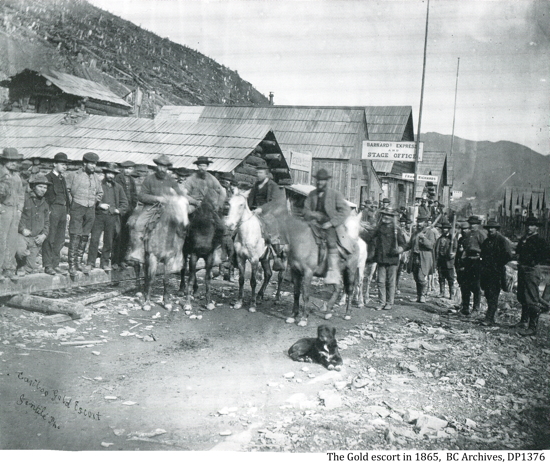
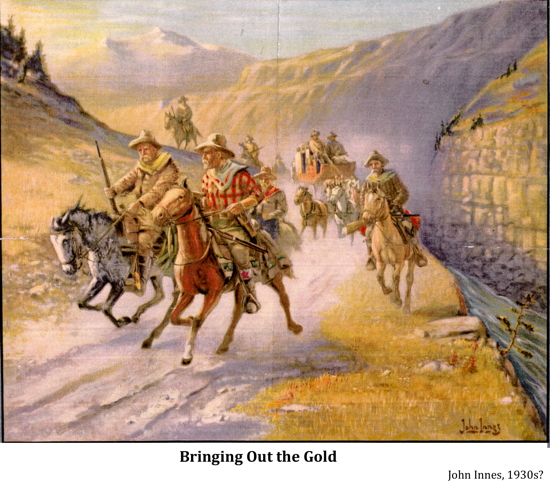
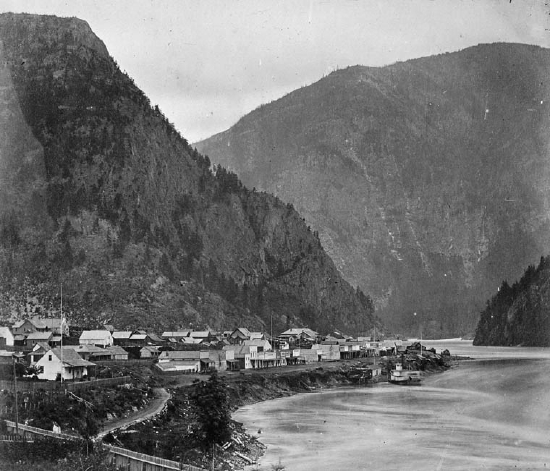
Yale, B.C. LAC Frederick Dally, C-000294, 1867-68
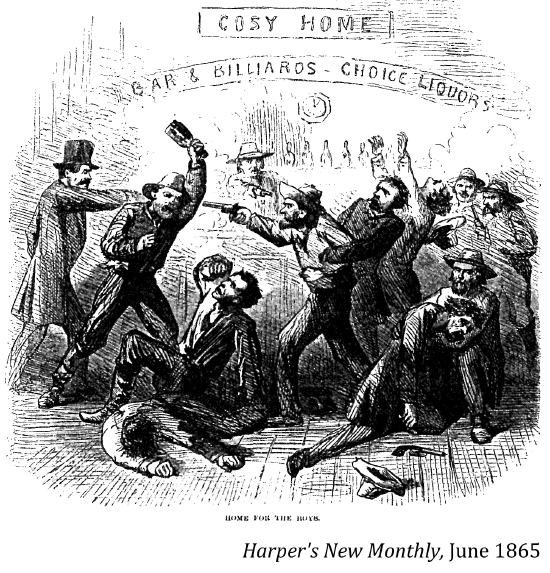
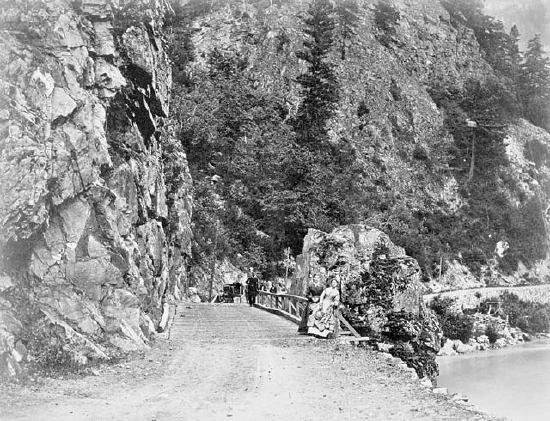
Cariboo Road at Yale showing Miss Irving and Miss Brown. LAC C-034943, Dally Frederick, 1868
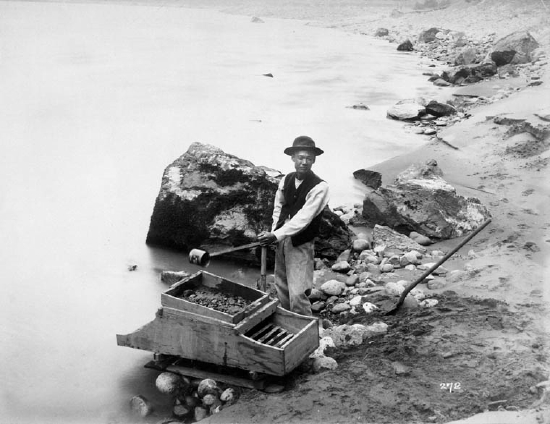
Chinese man washing gold. LAC PA-125990, Chinese man washing gold. LAC PA-125990, 1875
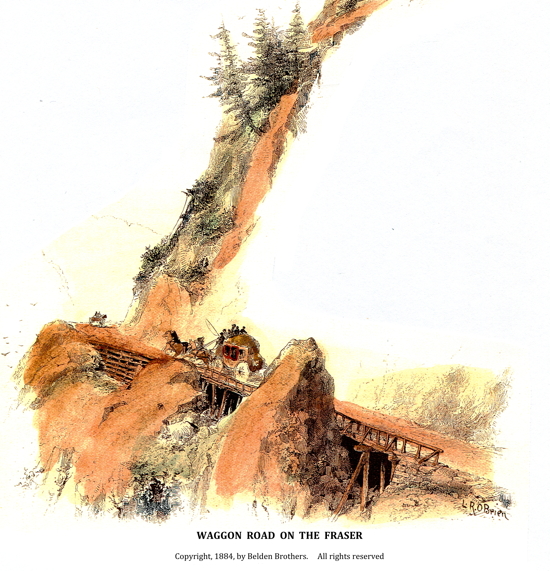

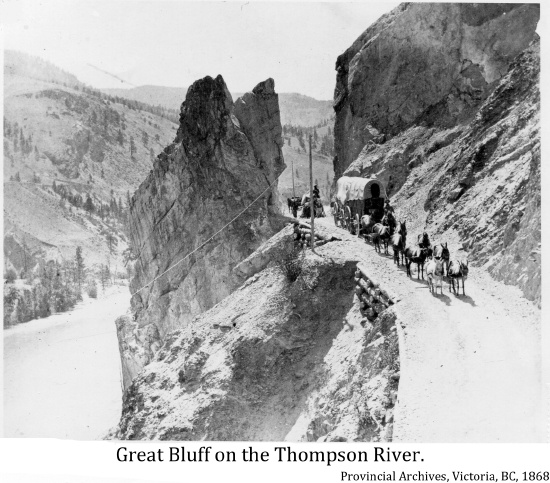

(see Alaska Boundary Dispute theme)
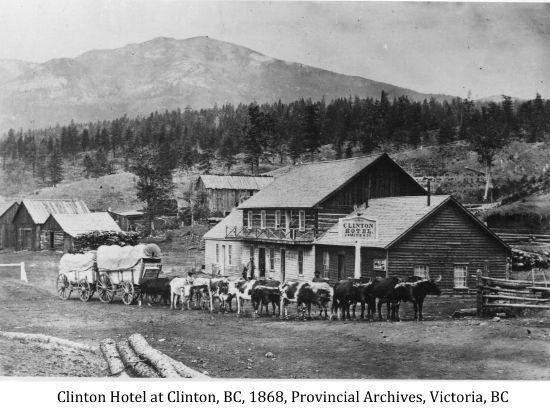
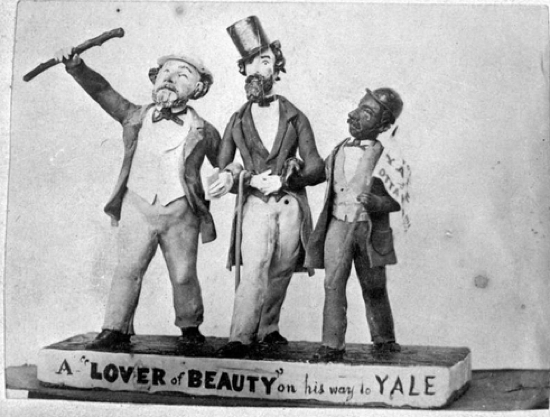
"A Lover of Beauty on his way to Yale:"; a cartoon in sugar of John Gustavus Norris, Amor De Cosmos and Mifflin Wistar Gibbs; delegation to the Confederation League convention in Yale; created by Victoria confectioner Andrew W. Piper. BC Archives, A-01225, 1868
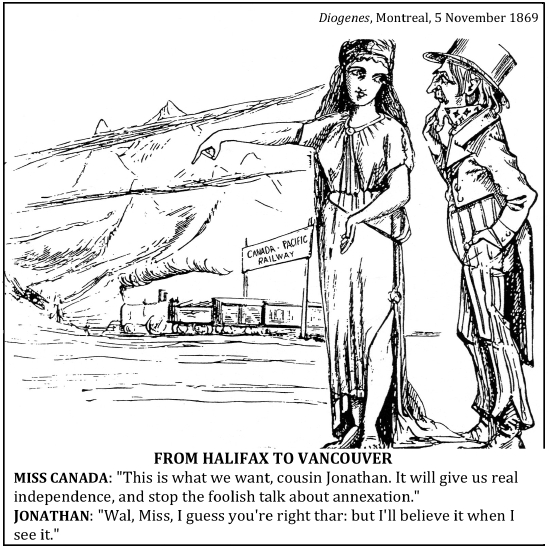
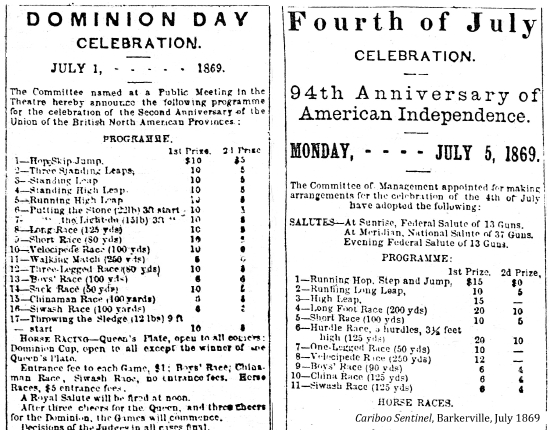
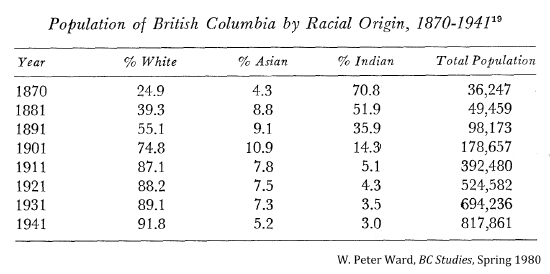
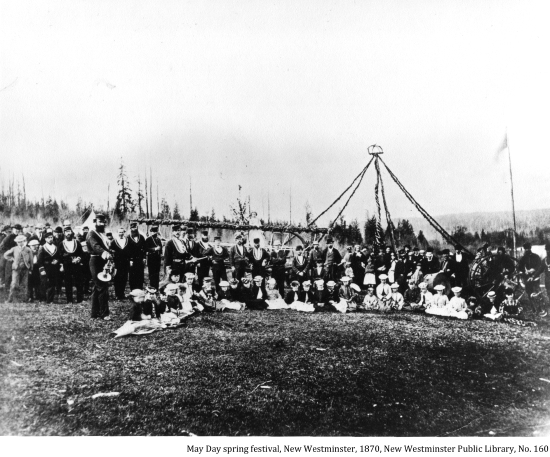
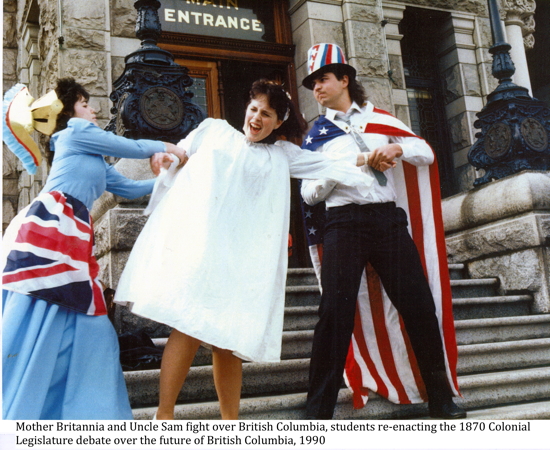
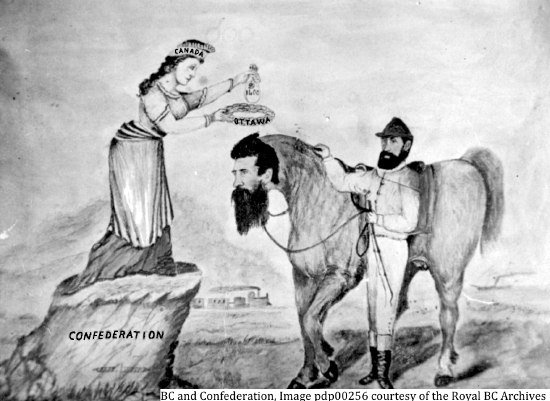
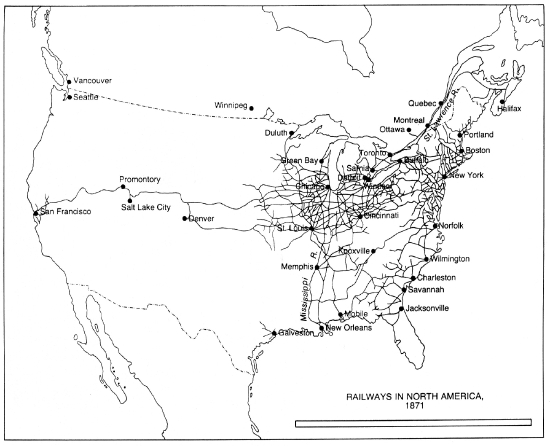
"The early history of British Columbia features San Francisco, Honolulu and Canton (Guangzhou) rather than Ottawa, New York, London or Paris."
Margery Fee
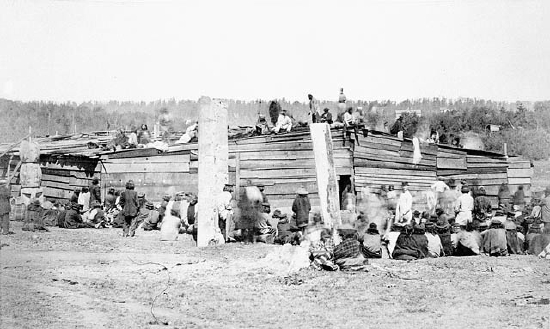
A view of an Indian village. Village indien de la Colombie-Britannique. LAC C-024286, ca. 1870
[In 1872, the first British Columbia Legislative Assembly passed the Qualification and Registration of Voters Act, 1872, preventing both Indigenous and Chinese peoples from voting in provincial elections.]
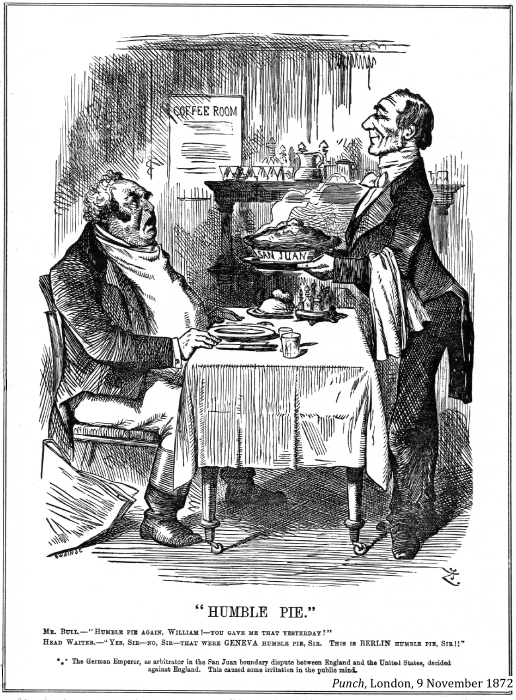
.jpg)
JUSTICE
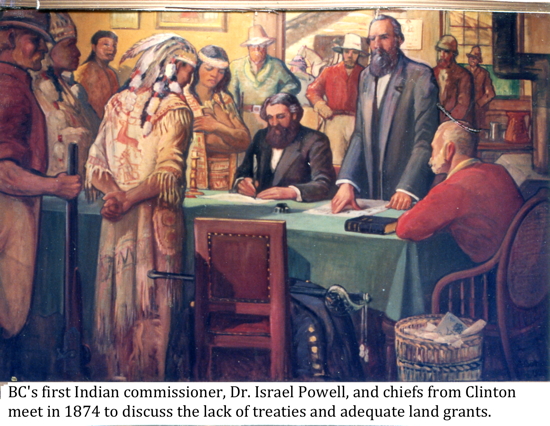
[The man seated at the head of the table in the red uniform is B.C.'s Indian commissioner. It depicts a famous scene from the 1874 meeting of Powell with 12 Clinton-area tribes, where Powell listened to and discussed various issues with each of the chiefs, in particular the lack of treaties and inadequate size of land grants. Matthew Baillie Begbie is standing opposite a chief. Powell unsuccessful championed proper reserves four times the size proposed by the province.]
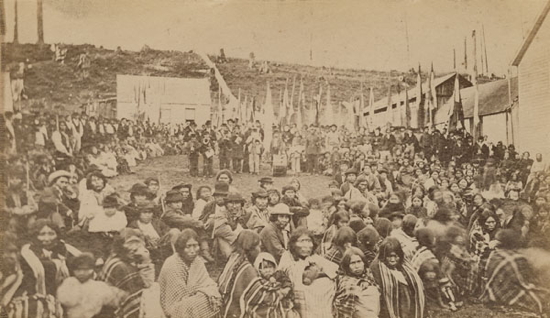
Indian Potlach - Vancouver Indians. LAC e008303330, ca. 1875-1877
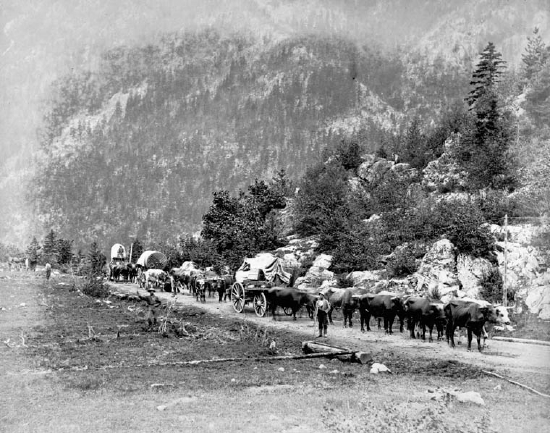
Teaming on Cariboo wagon road. LAC PA-023269, 1878-83
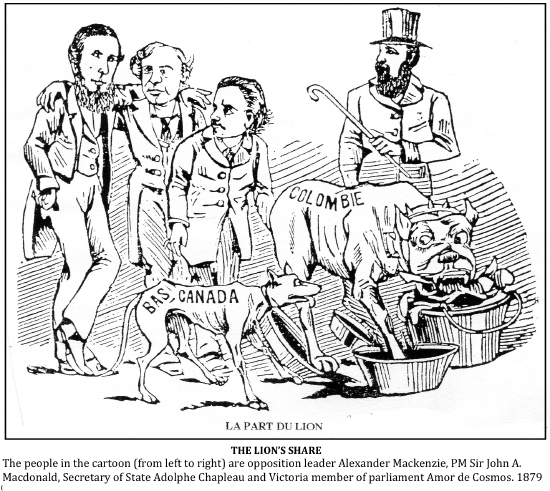
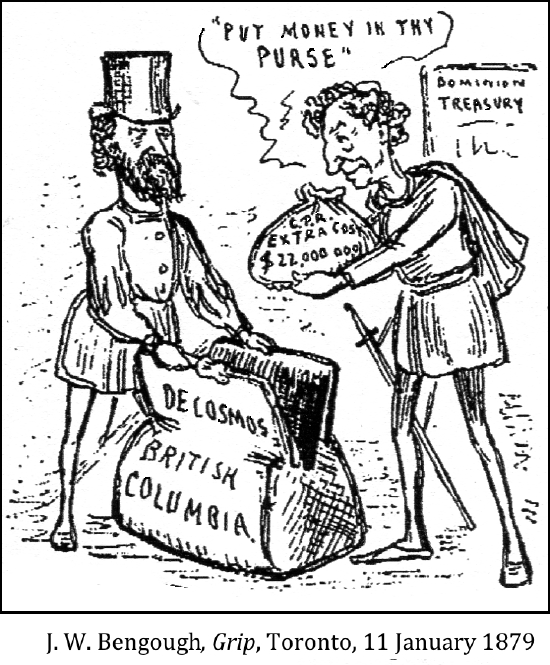
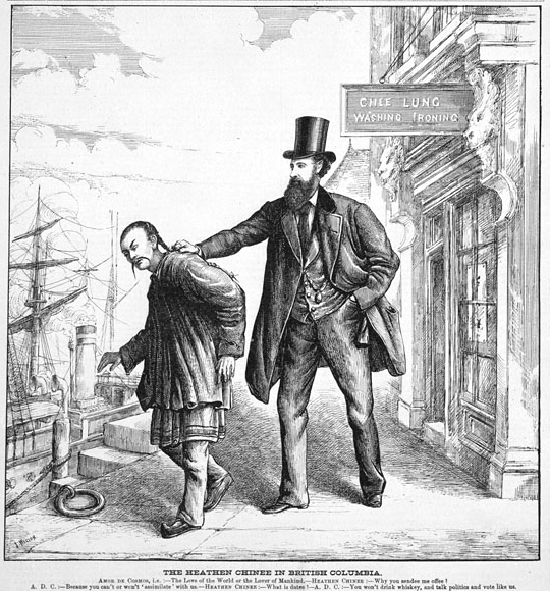
THE HEATHEN CHINESE OF BRITISH COLUMBIA
AMOR DE COSMOS: "The Love of the World or the Lover of Mankind."
HEATHEN CHINEE: "Why you sendee me offee?"
A. D. C.: "Because you can't or won't 'assimilate' with us."
HEATHEN CHINEE: "What is datee?"
A. D. C.: "You won't drink whiskey, and talk politics and vote like us."
LAC, C-072064 J. Weston Canadian Illustrated News, 26 April 1879
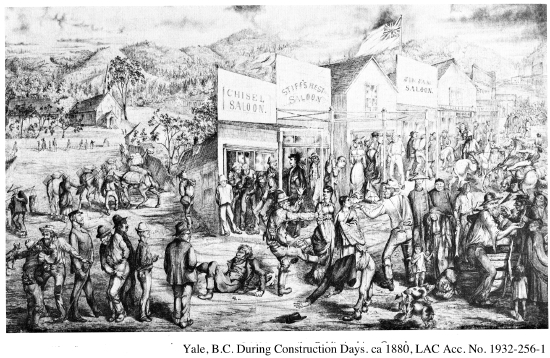
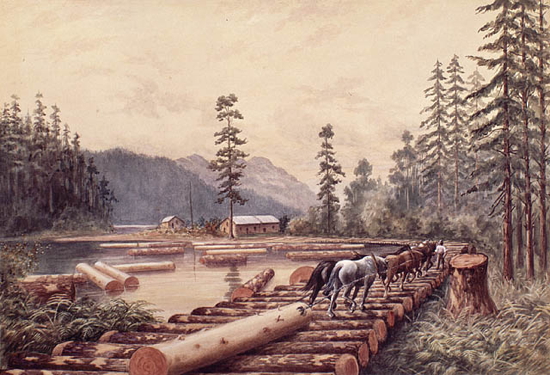
A Logger's Camp on Vancouver Island. LAC Acc. No. 1989-201-32, E. Sandys, 1880-1900

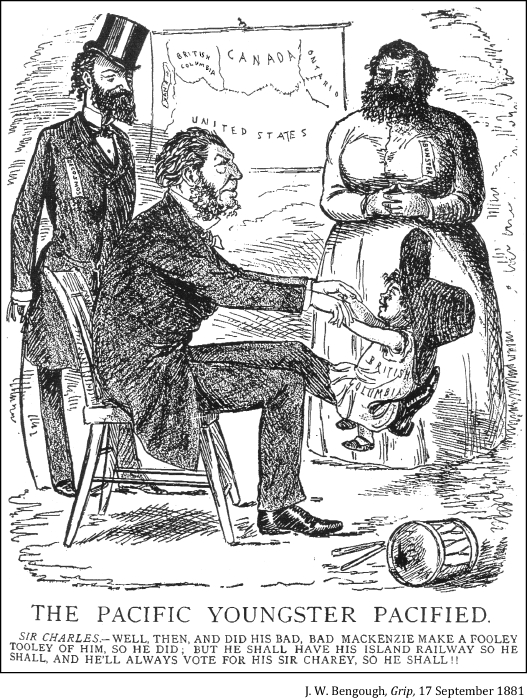
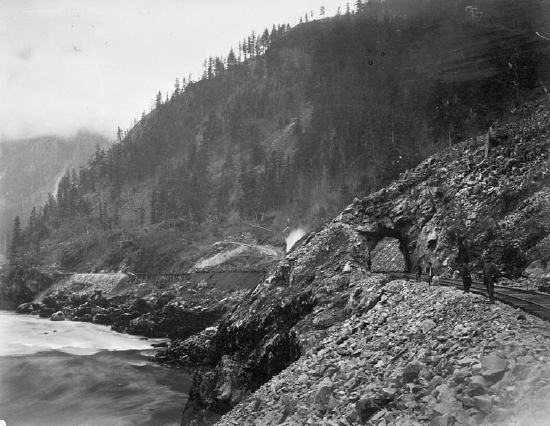
Canadian Pacific Railway construction between Yale and Boston Bar, B.C. Tunnel No. 4, 2 miles above Yale, looking down valley. LAC PA-022531, Richard Maynard, 1881
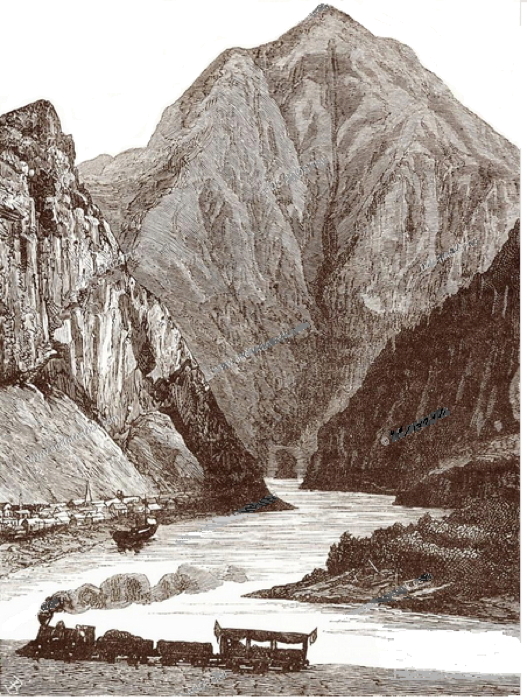
The Graphic, London, 27 January 1883

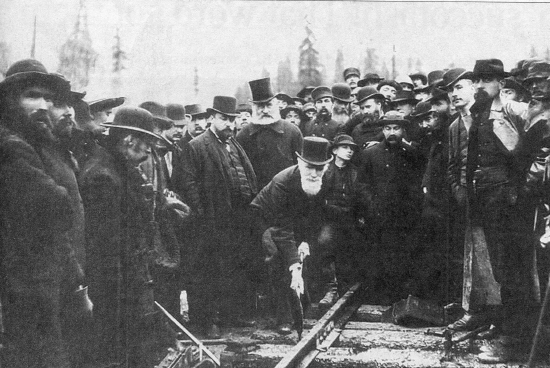
Donald A. Smith driving the last spike to complete the Canadian Pacific Railway, Lac C-003693, Alexander Ross, 7 November 1885
(see CPR theme)
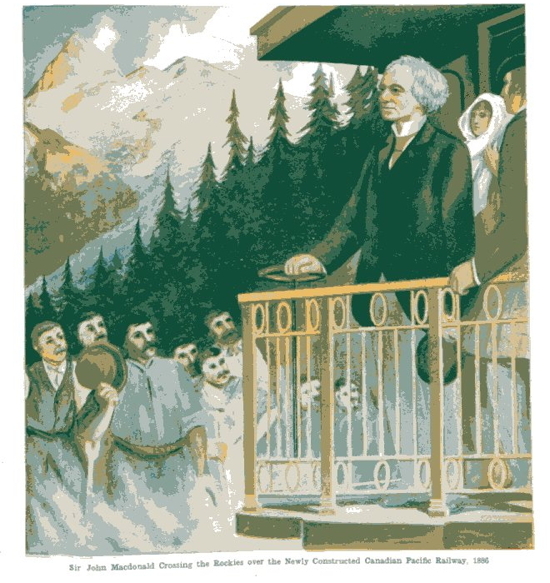
Sir John A. Macdonald Crossing the Rockies Over the Newly Constructed Canadian Pacific Railway, 1886, The Western Home Monthly, Winnipeg, July 1917
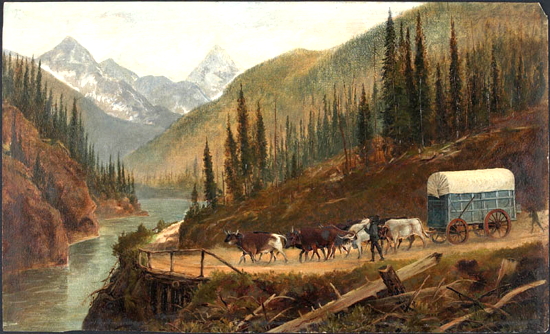
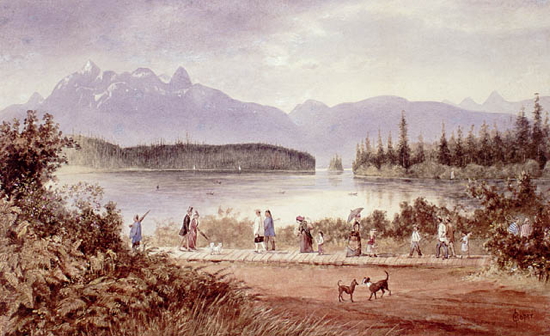
New Westminster, Colombie-Britannique. LAC Acc. No. 1989-446-30, Edward Roper, 1887-1909
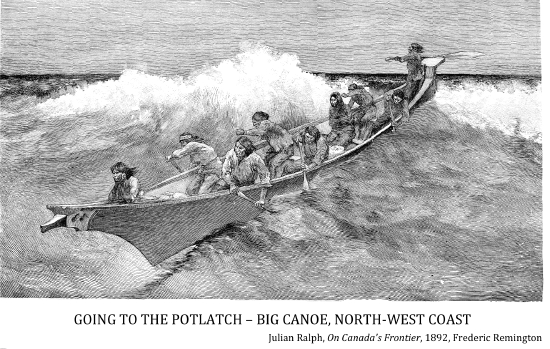

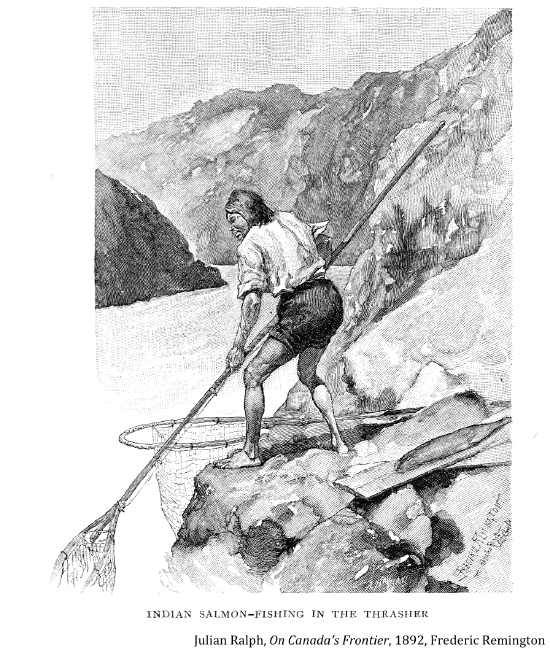
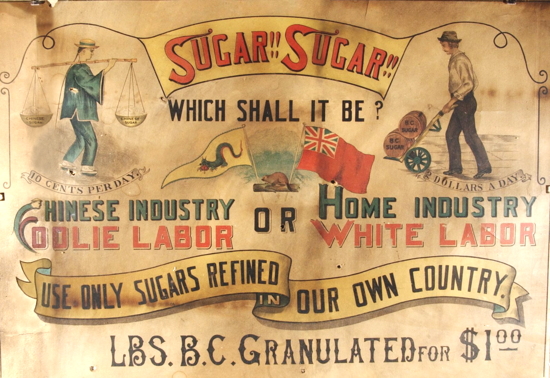
1895, BC Sugar, Courtesy of Brent Axelson

Processing Ooligan Grease on Nass River, ca. 1880s. BC Archives C-07432
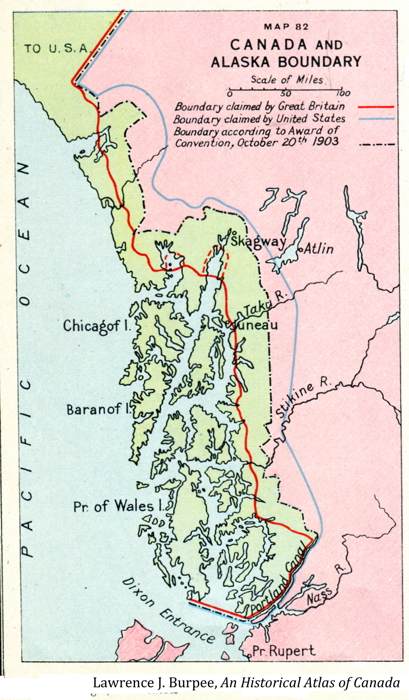
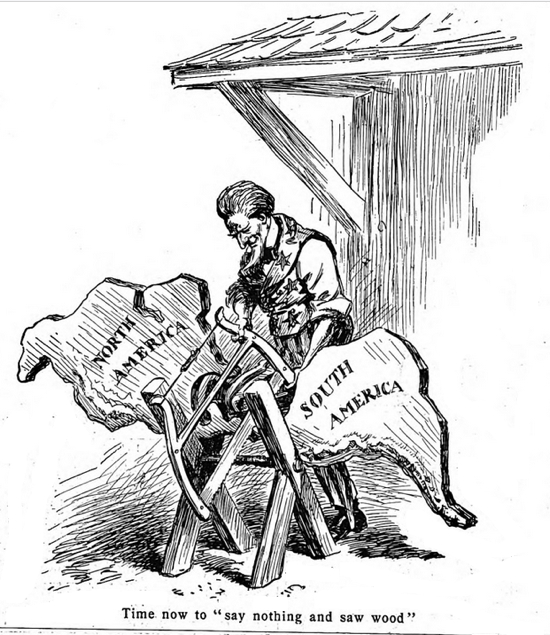
Harper's Weekly, New York, 12 July 1902
[The United States decided to build the Panama Canal in 1902. It was finished in 1914, bringing European markets much closer to BC.]
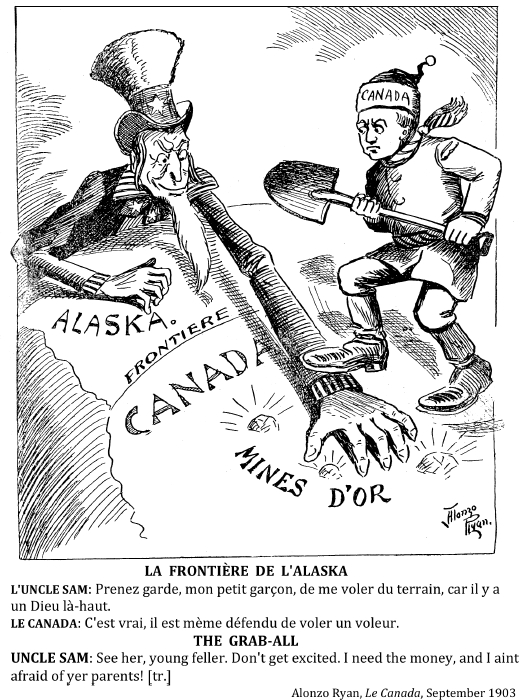
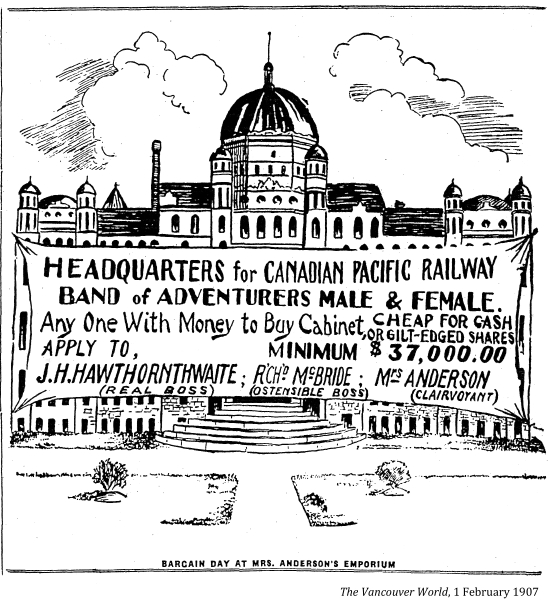
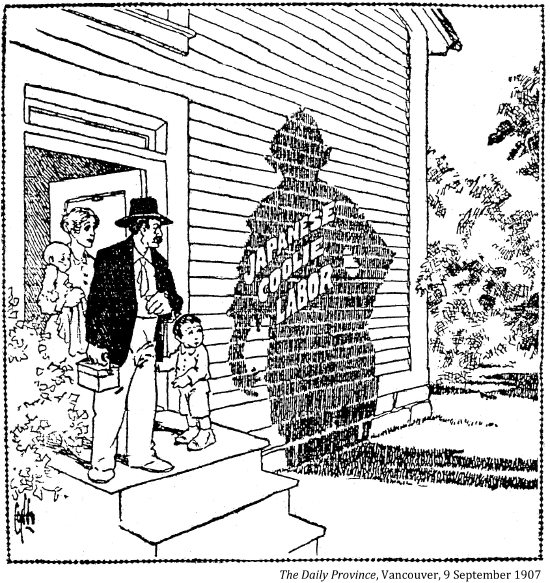
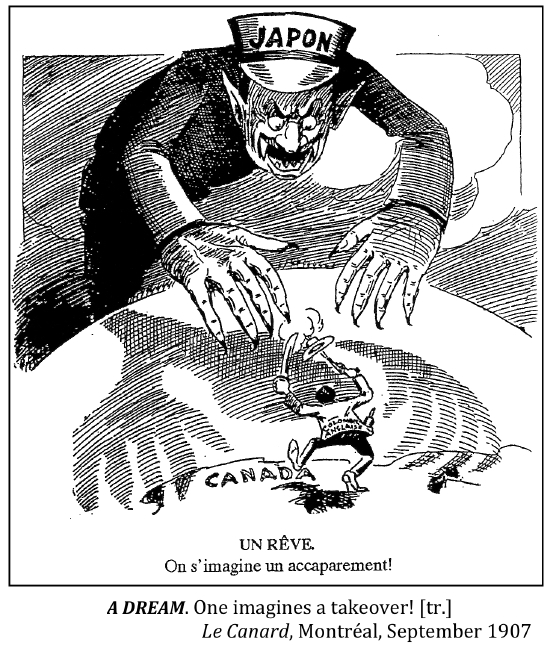
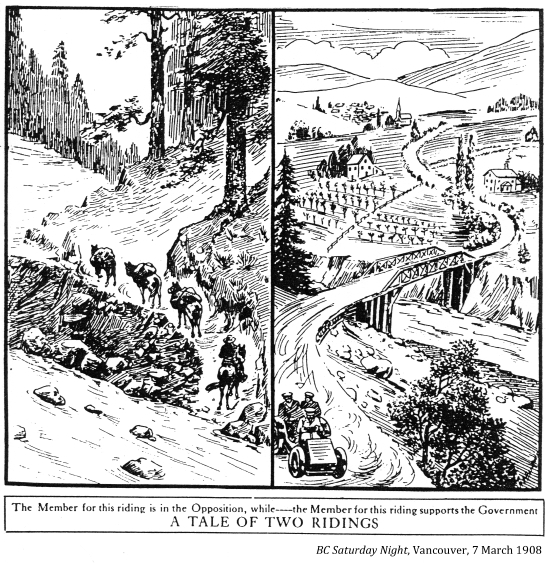
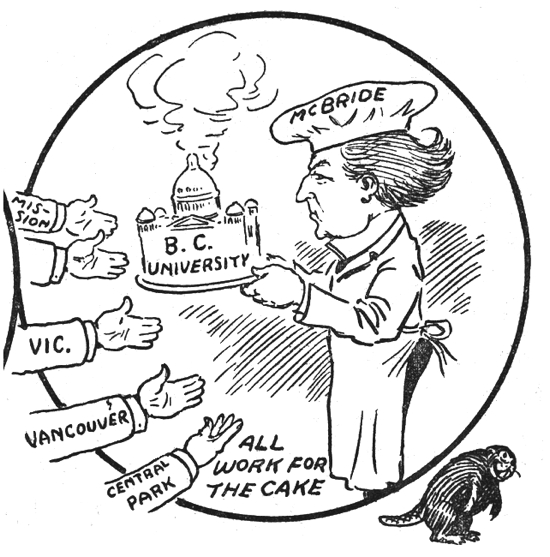
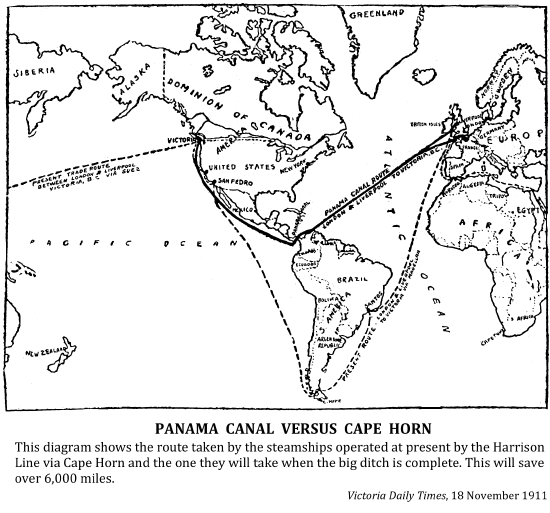
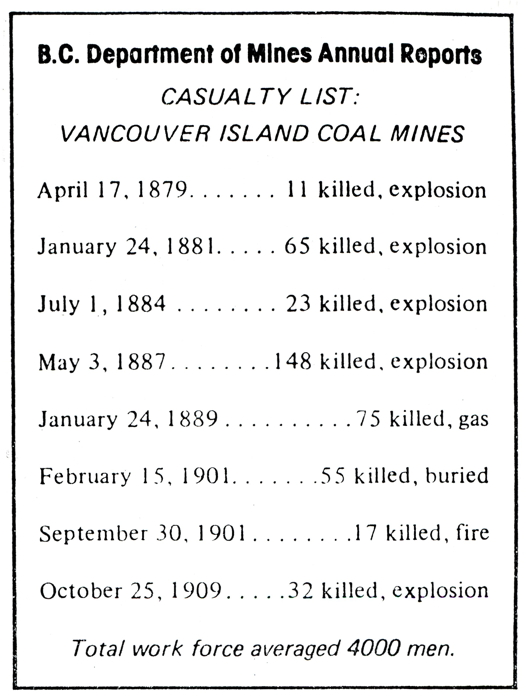
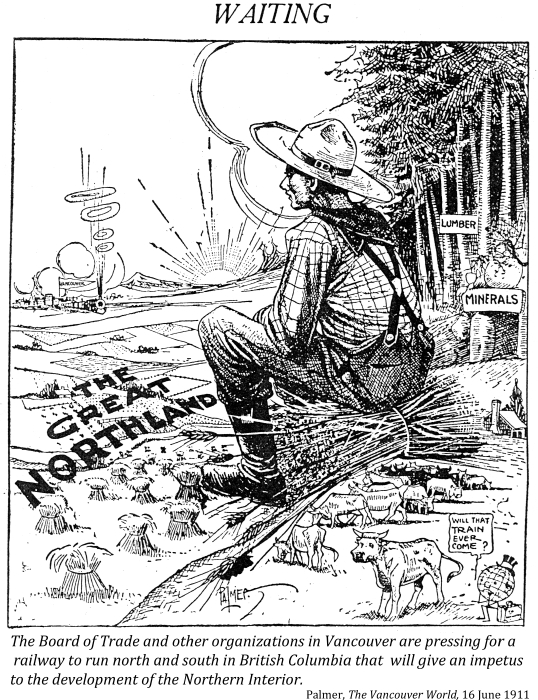
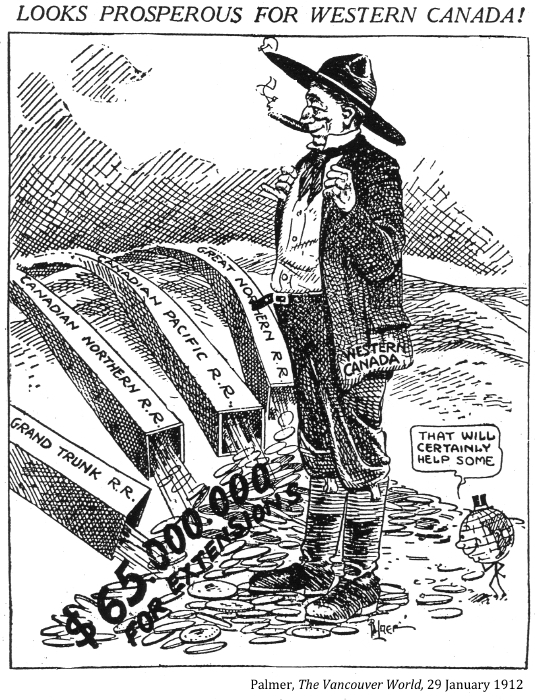
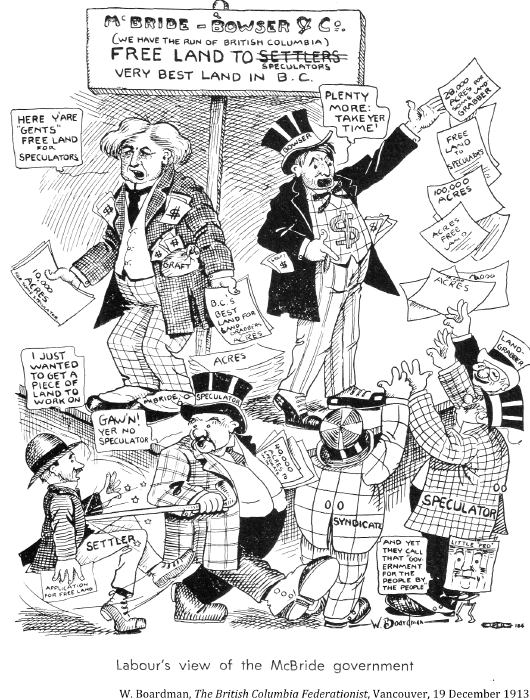
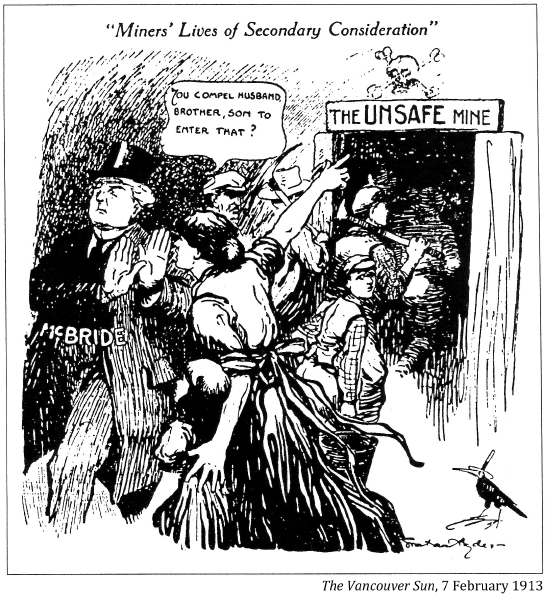
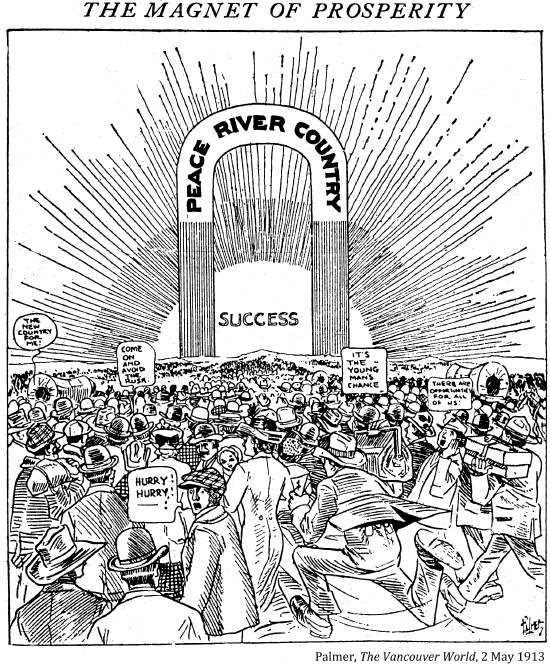
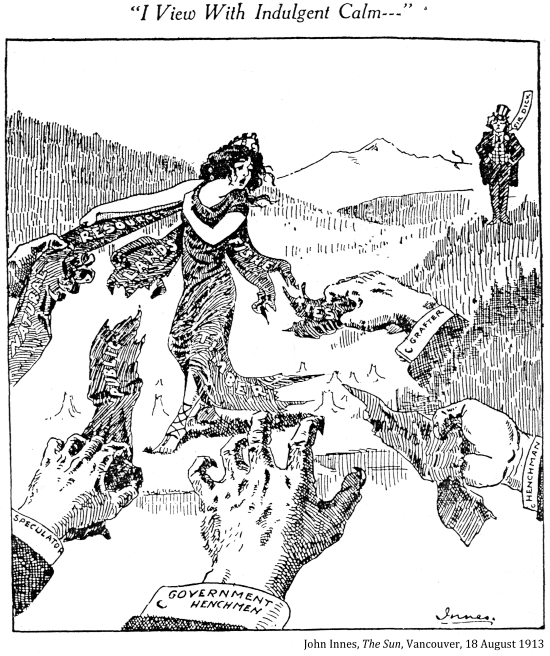
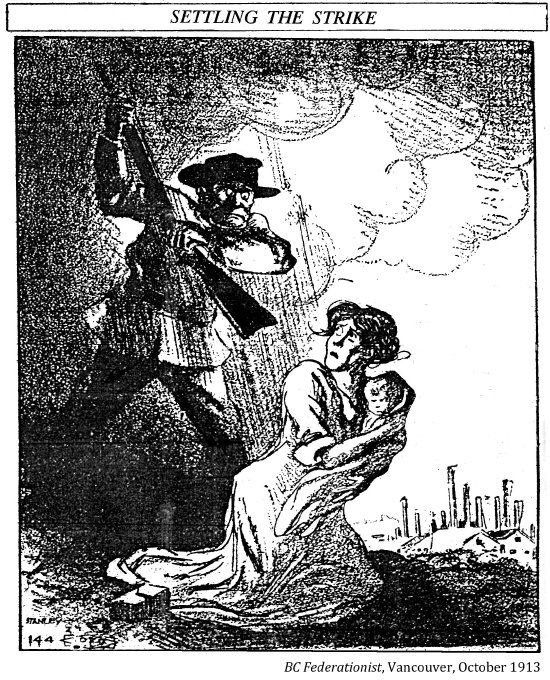
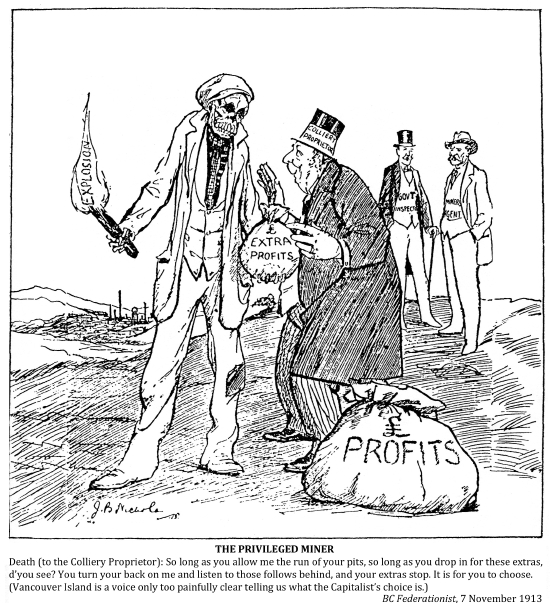

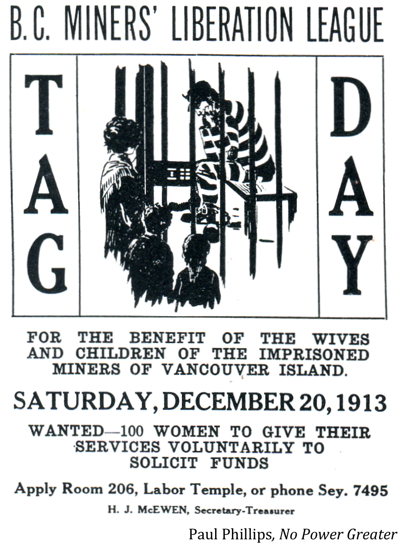
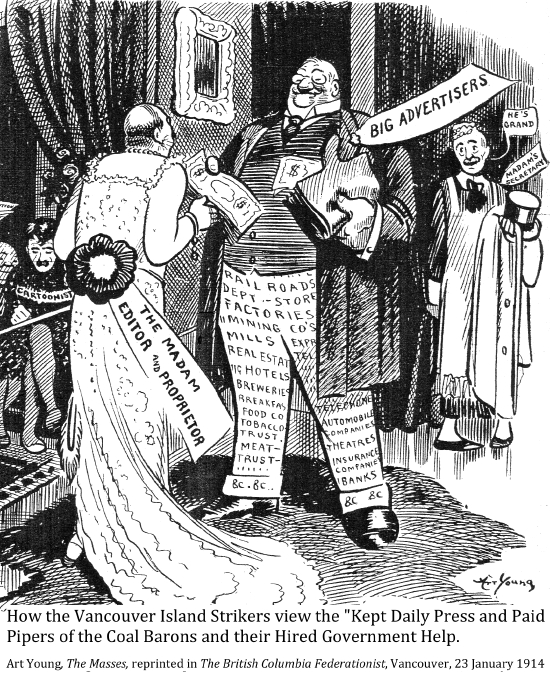
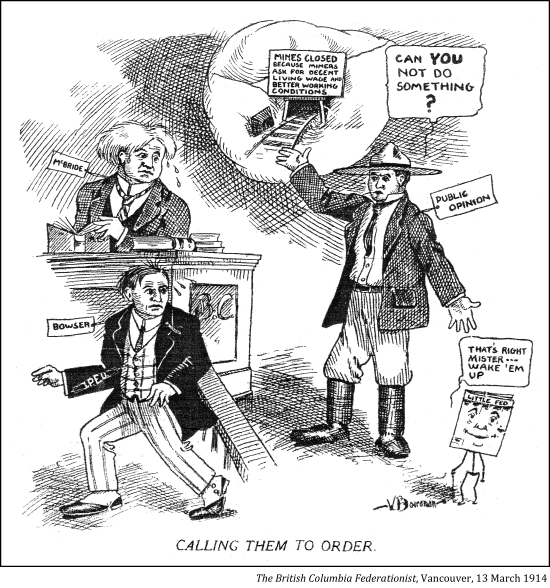
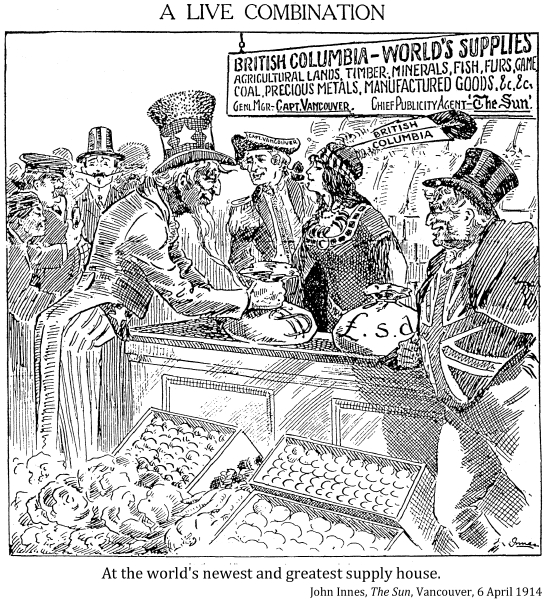

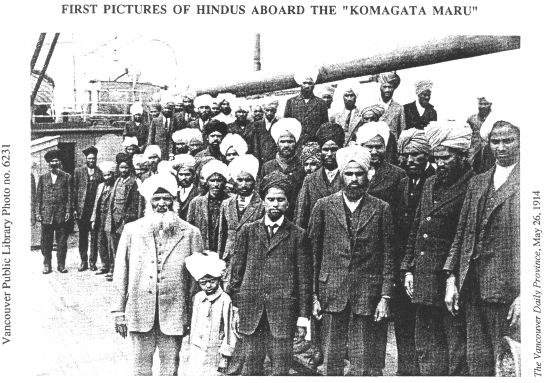
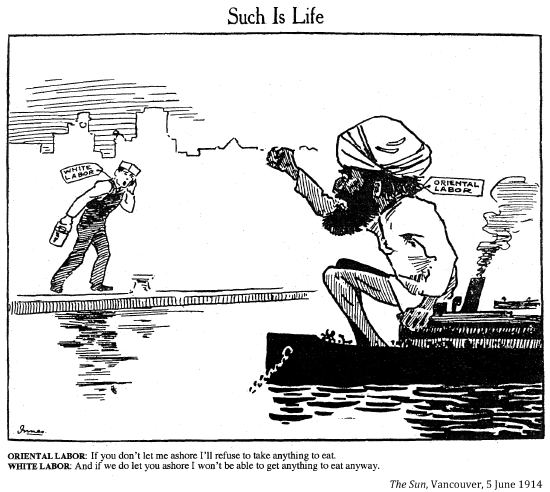
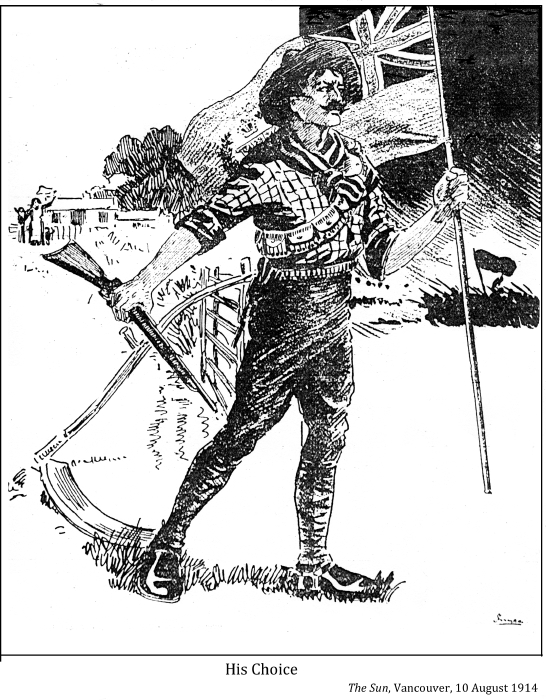
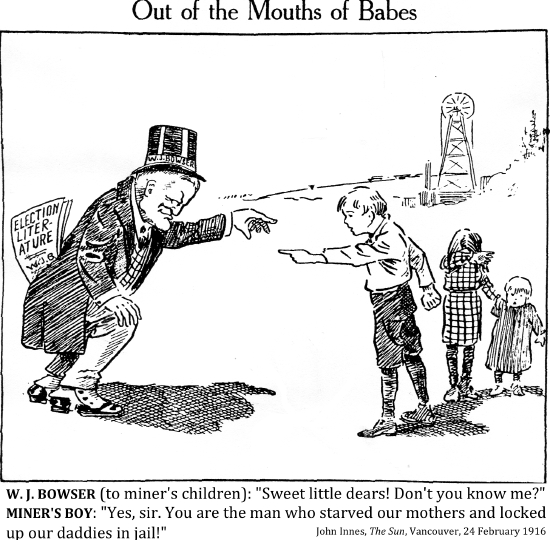
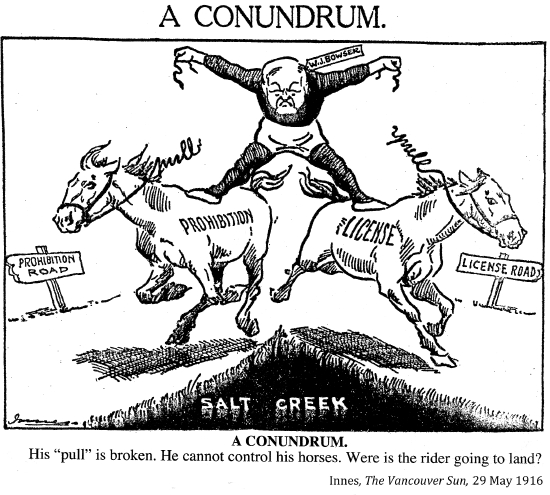
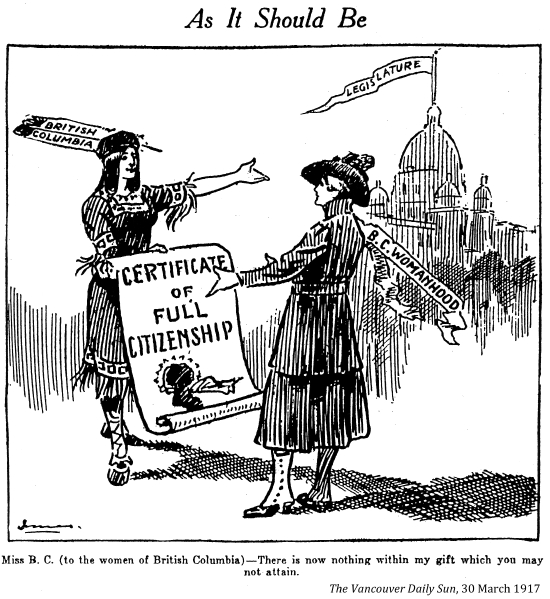
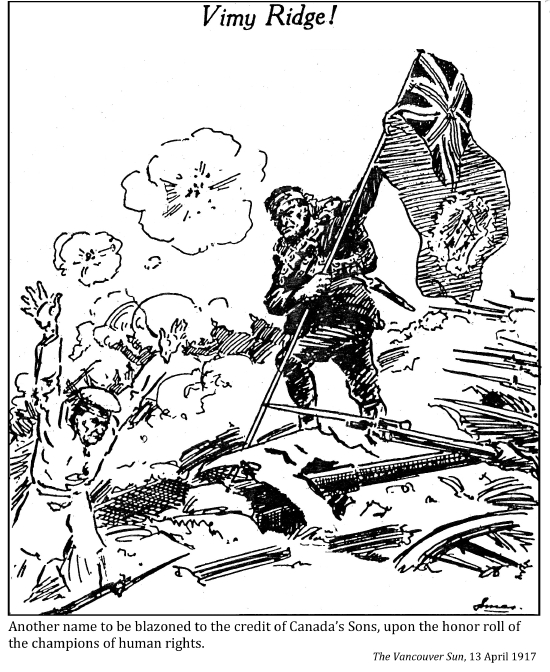
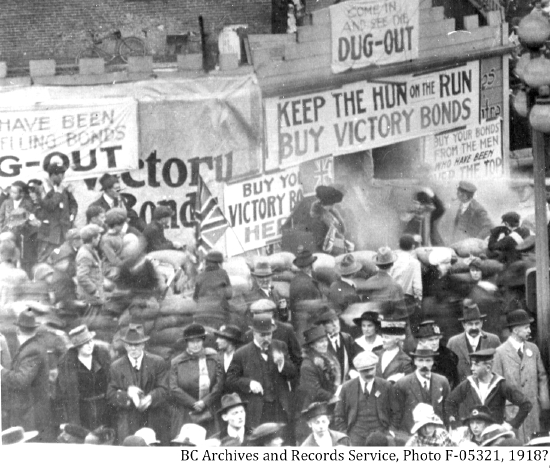
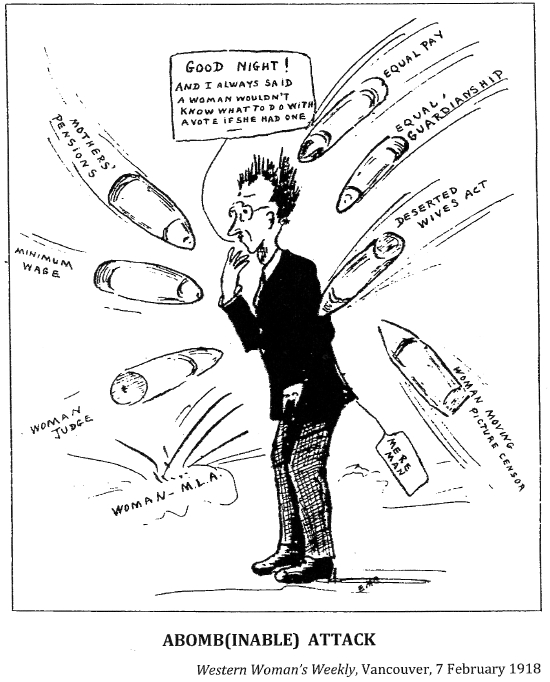
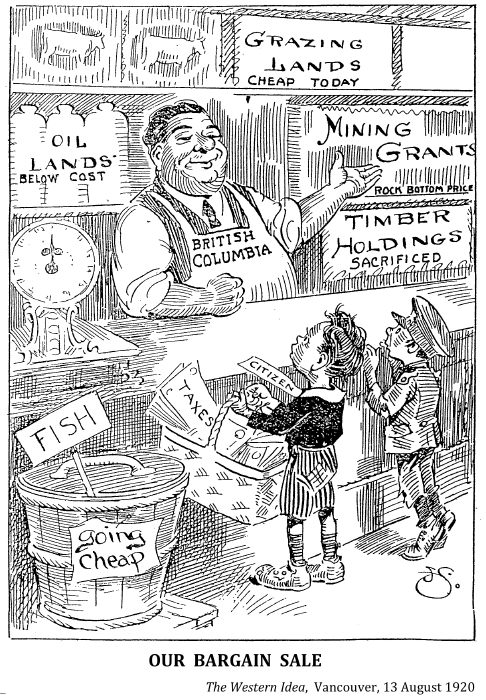
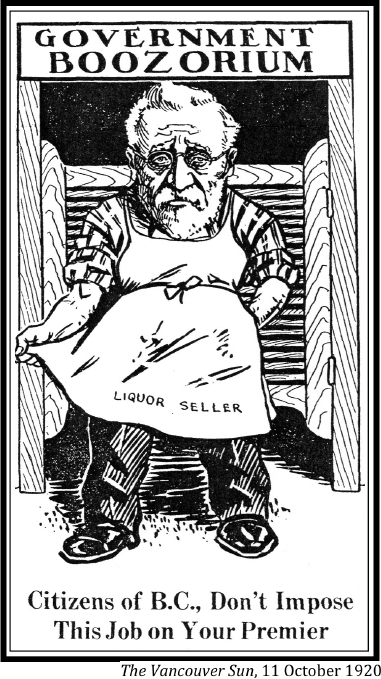
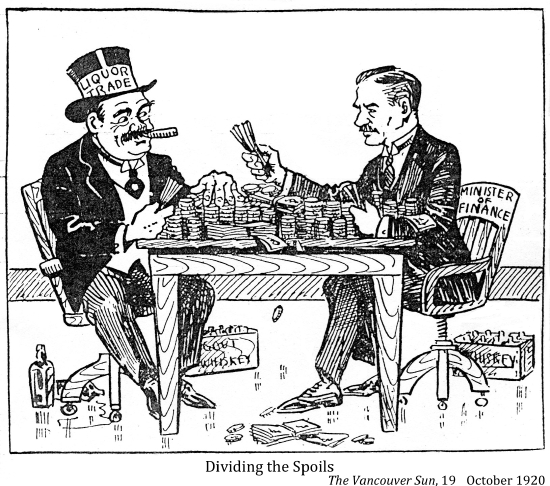

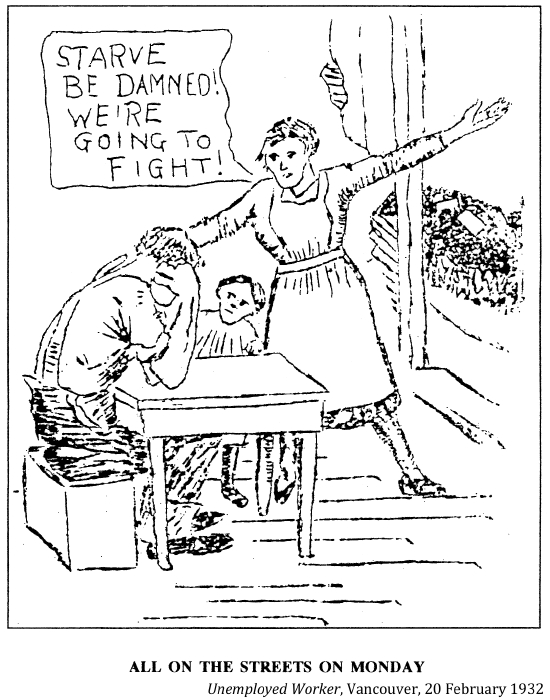
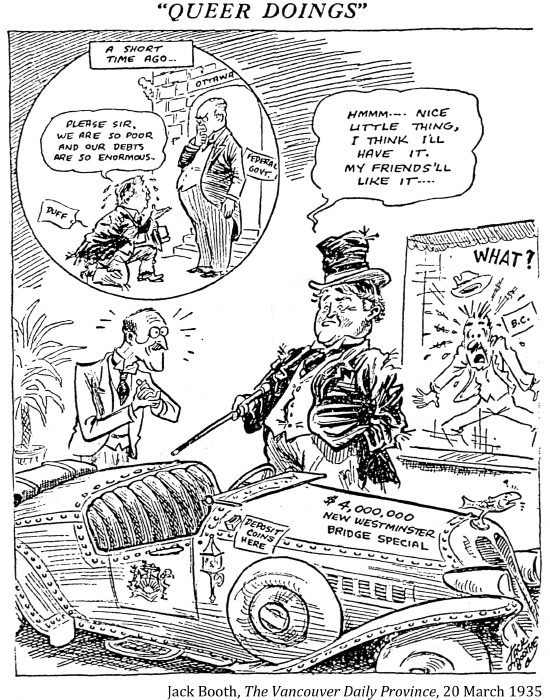
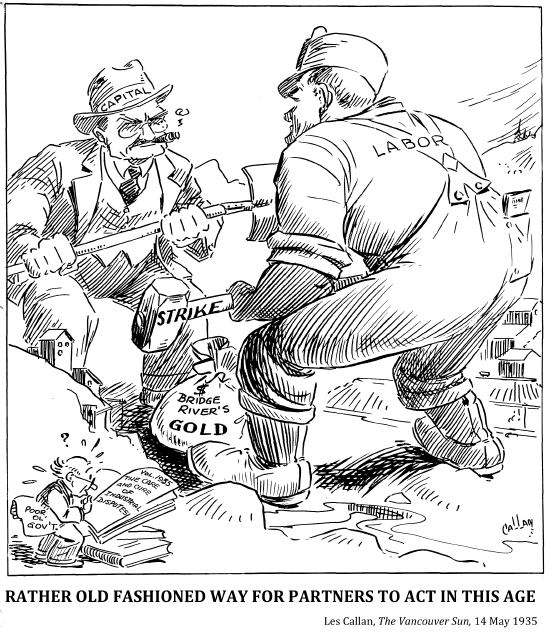
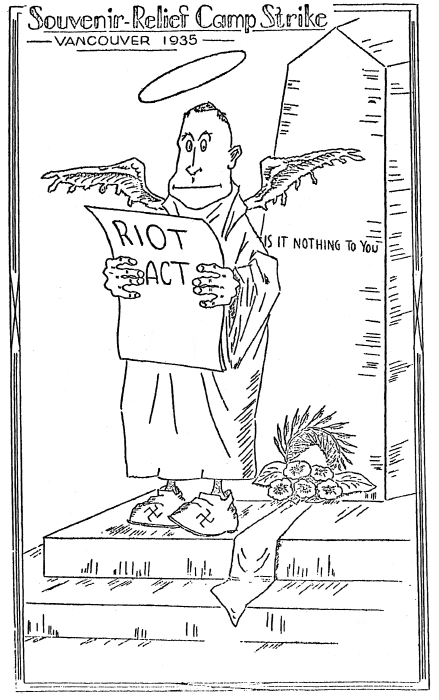
1935
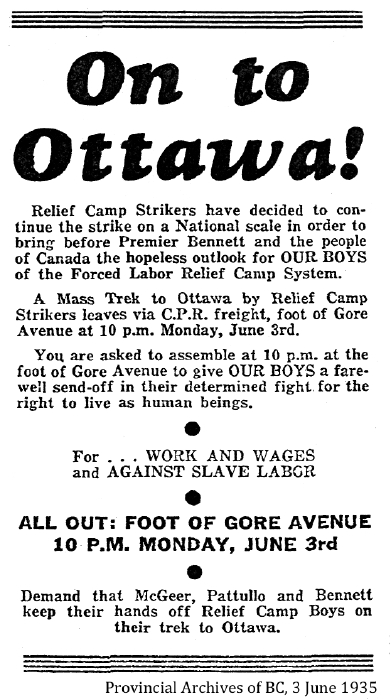

Strikers from unemployment relief camps en route to Eastern Canada during "March on Ottawa". Grévistes de camps d'assistance-chômage en route vers Ottawa durant la " March on Ottawa ". LAC C-029399, June 1935
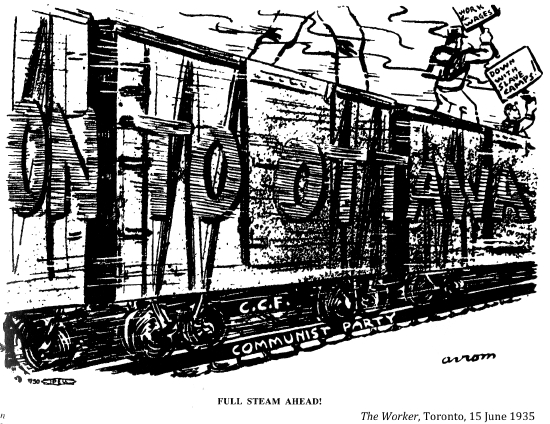
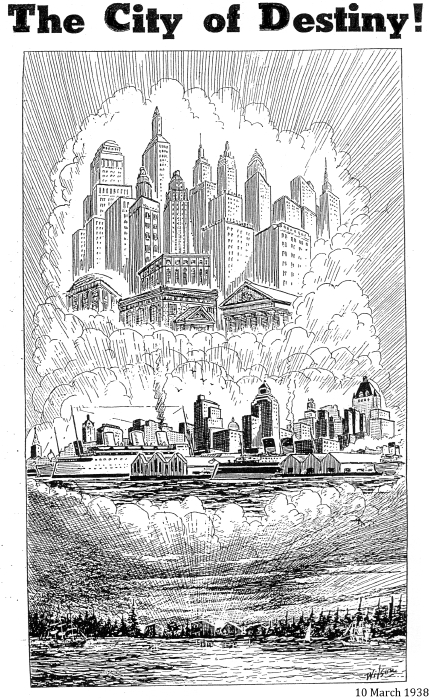

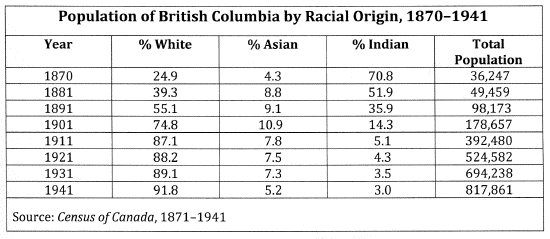
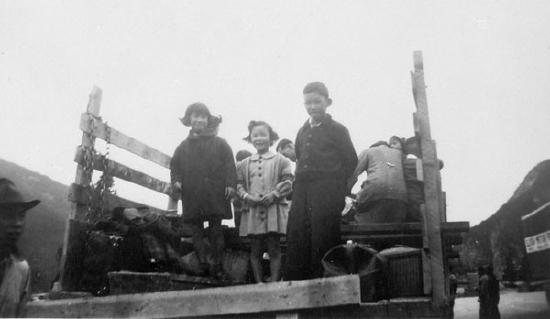
1942-45 David Suzuki and his two sisters in an internment camp. David Suzuki et ses deux soeurs dans un camp d'internement. LAC, 1976-087, PA-187835
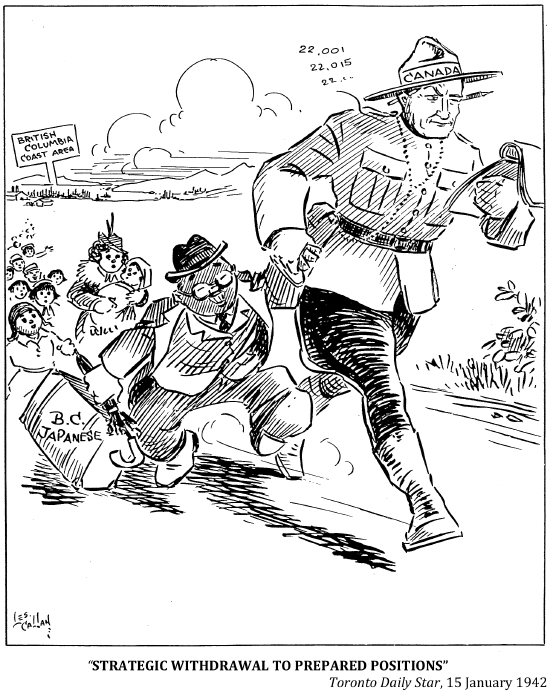
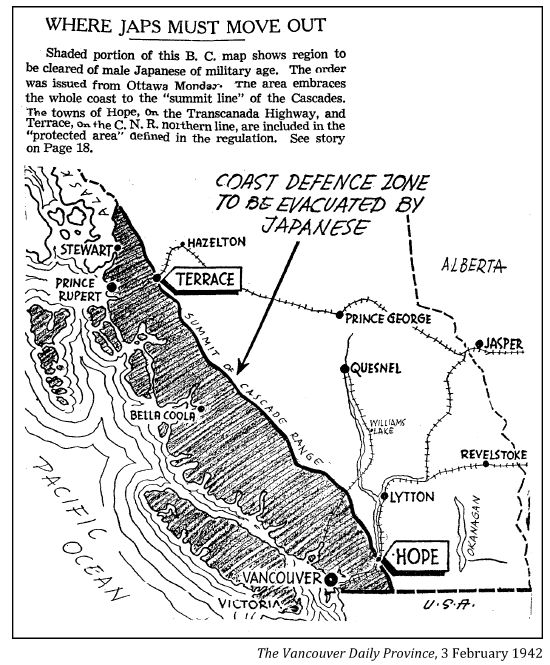
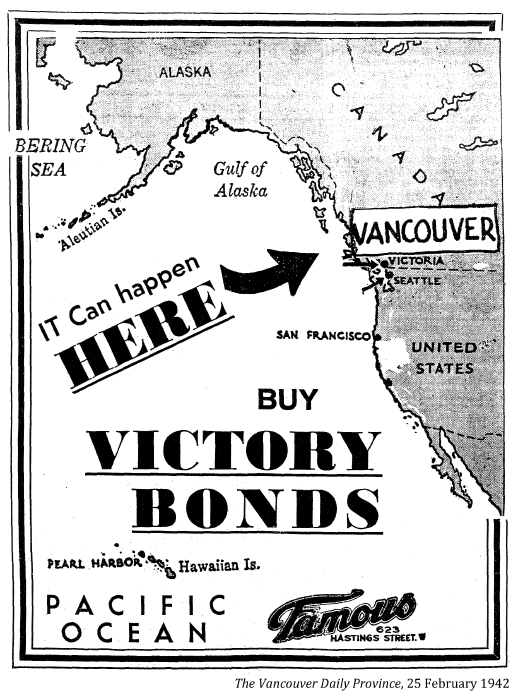
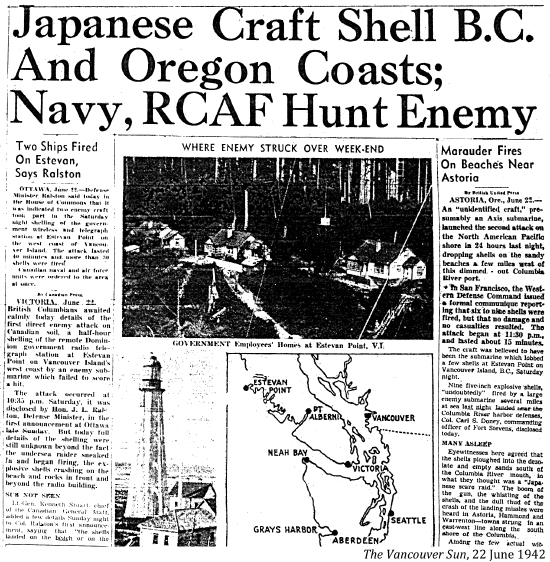
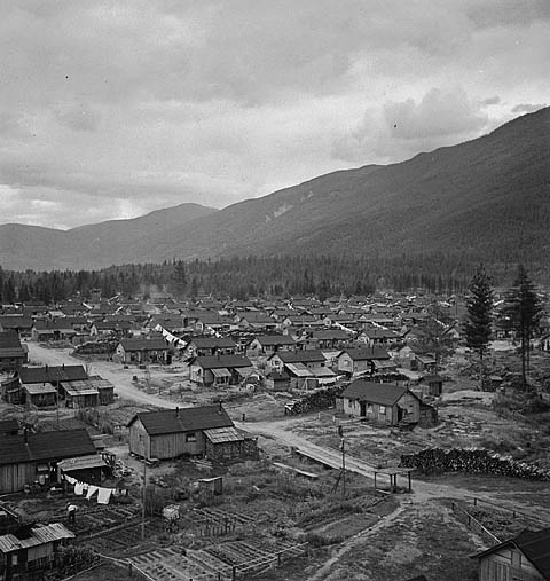
Internment camp for Japanese – Canadians, June 1945, NFB, LAC PA-142853
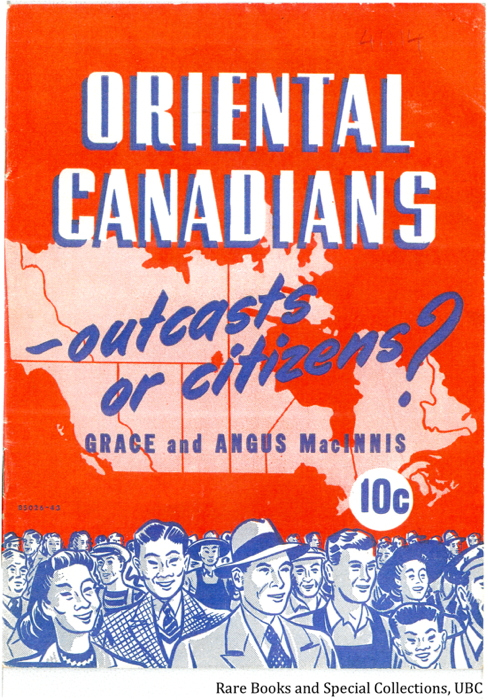
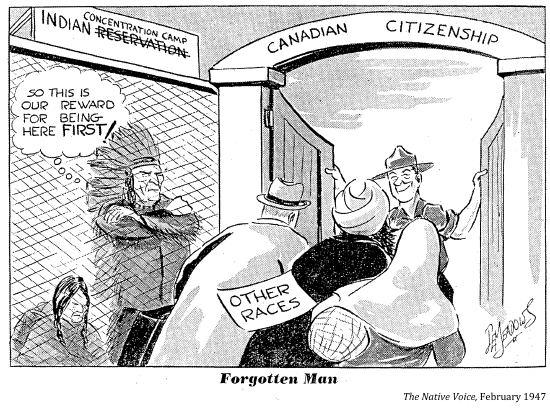
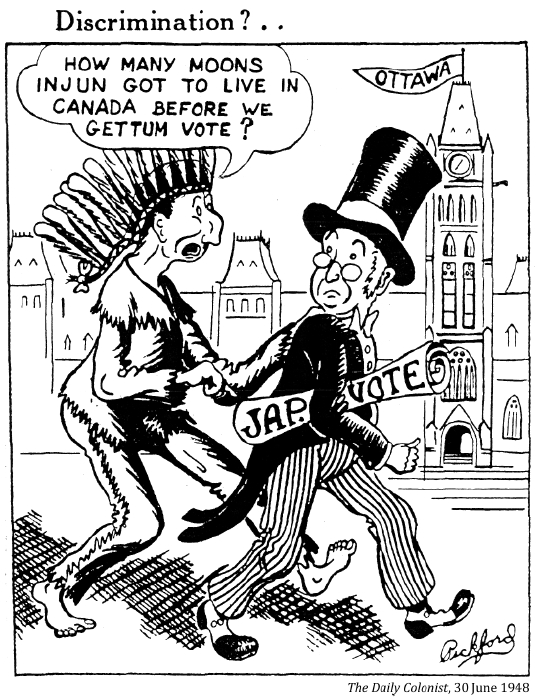

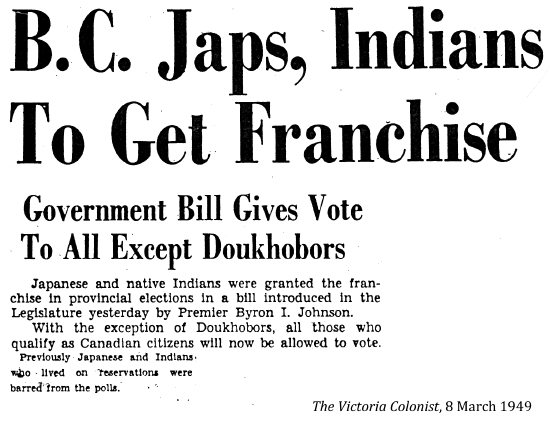
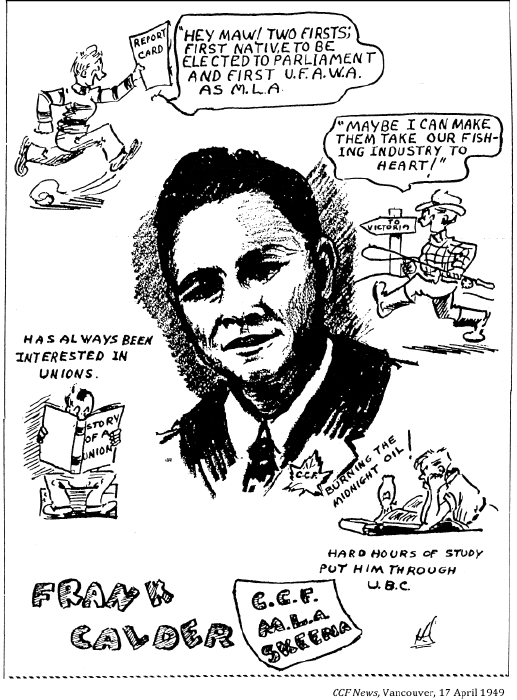
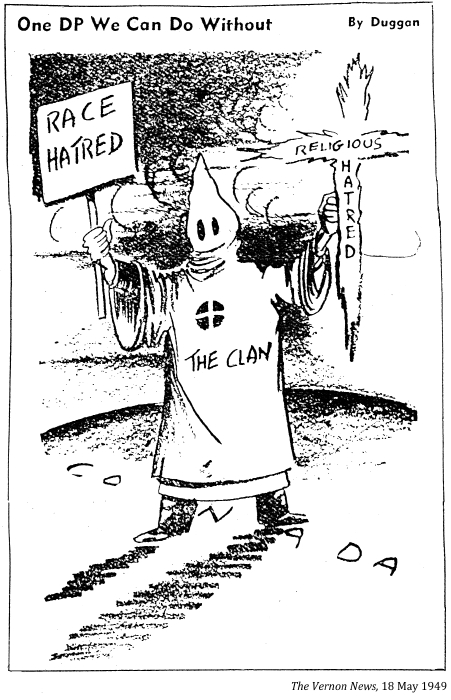
Summary of Groups Disenfranchised Provincially in British Columbia
Women
Chinese
Native Indians
Japanese
East Indians
Mennonites
Doukhobors |
Year Disenfrancised
-
1874
1874
1895
1907
1931
1931 |
Year Enfranchised
1917
1847
1849
1849
1847
1848
1852 |
Sooource: Electoral History of British Columbia, 1871-1986
(Victoria: Elections British Columbia, 1988)

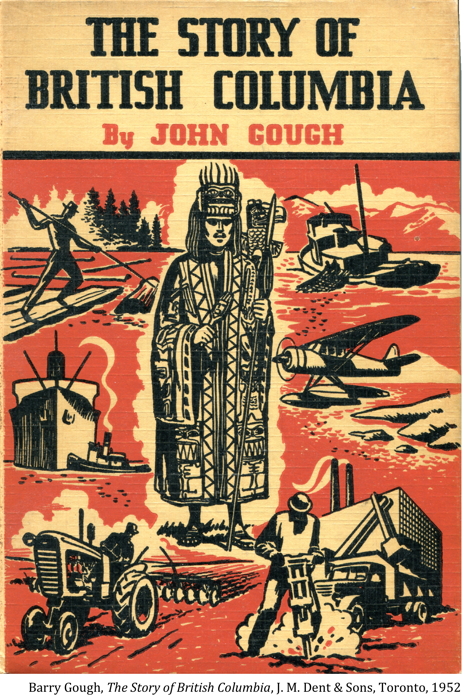

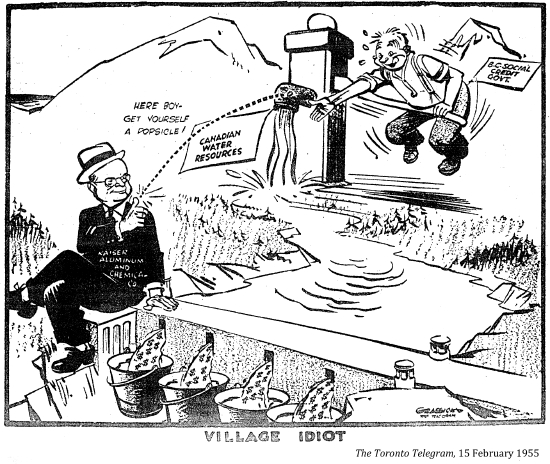
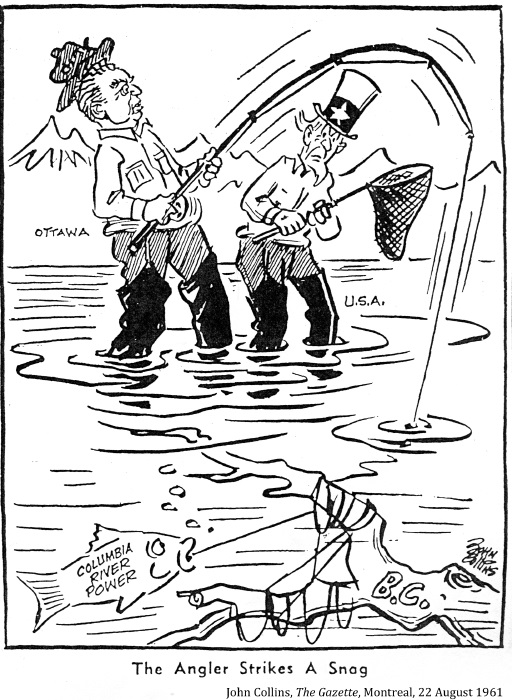
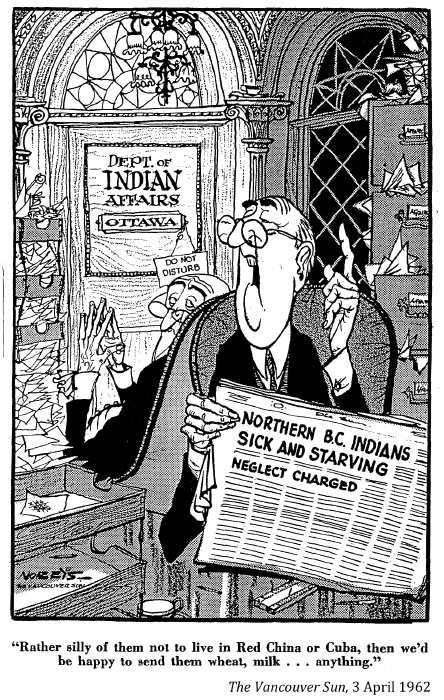
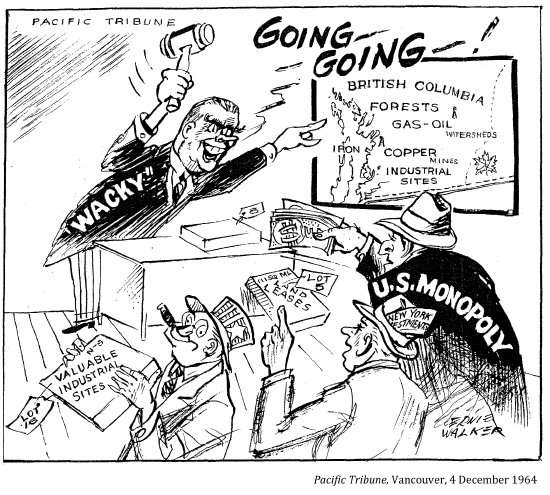
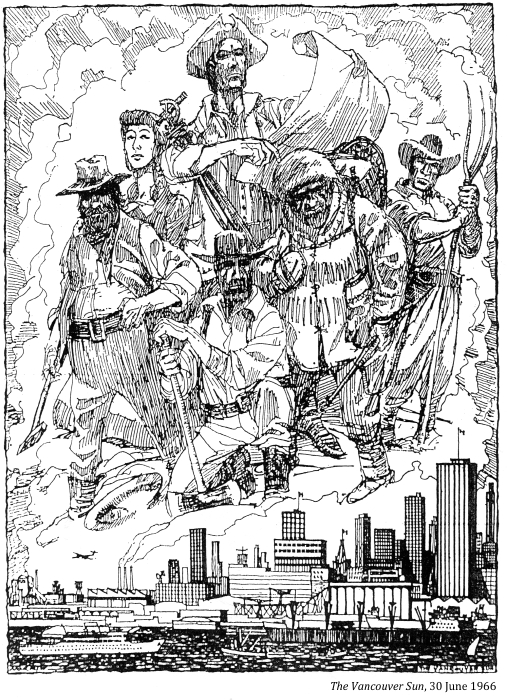
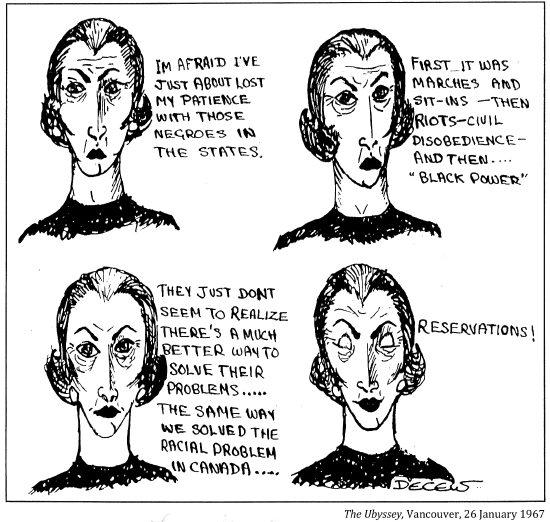


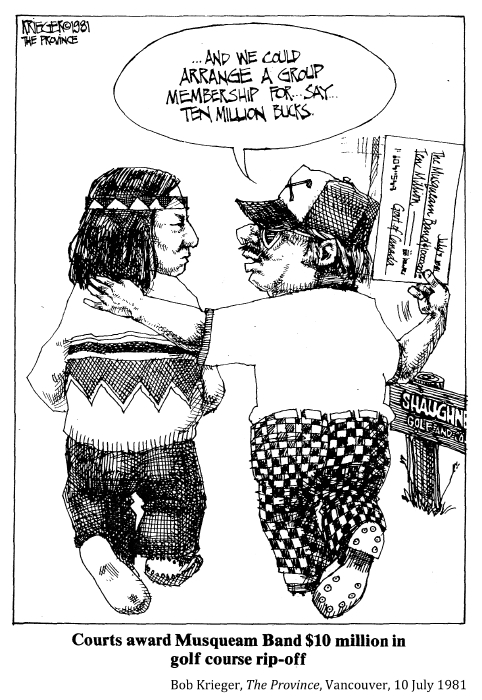

|


































































































































.jpg)






































%20June%20native%20land.jpg)






































.jpg)






























































































